 |
HP OpenVMS systems documentation |
| Previous | Contents | Index |
The following figures show the qualifiers that can be used in BACKUP save, restore, copy, compare and list operations. The figures also indicate valid combinations of BACKUP qualifiers.
Figure G-1 Command Qualifiers Used in Save Operations
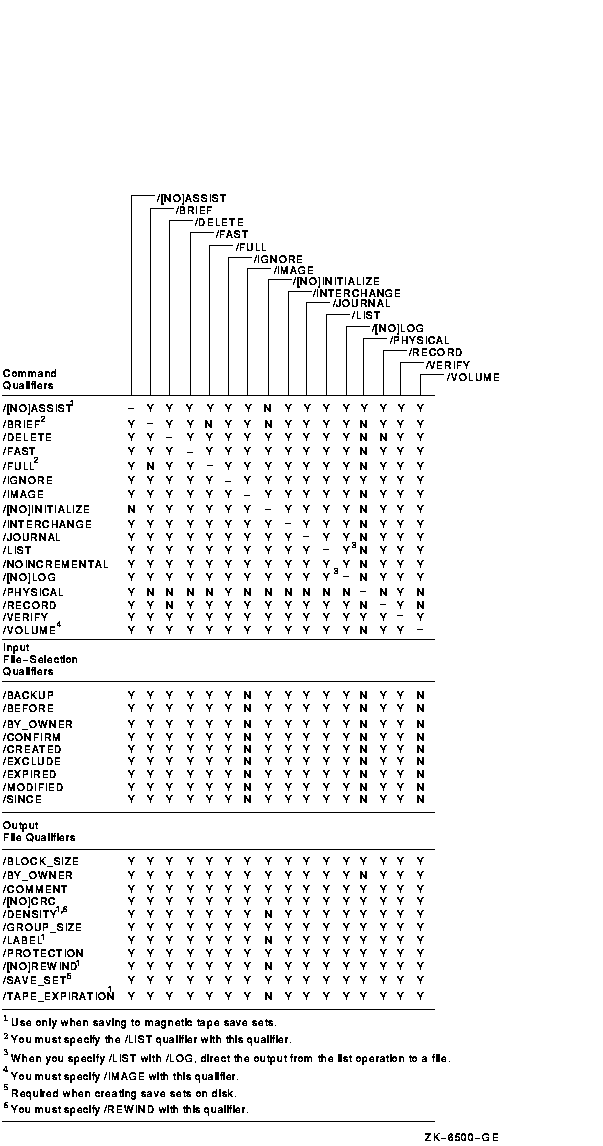
Figure G-2 Input File-Selection Qualifiers Used in Save Operations
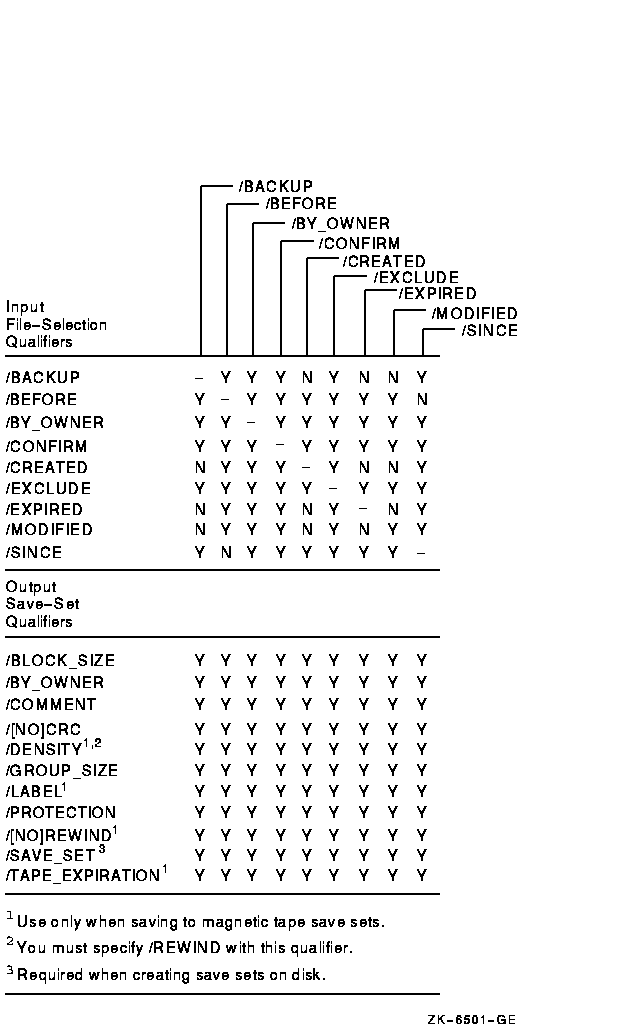
Figure G-3 Output Save-Set Qualifiers Used in Save Operations
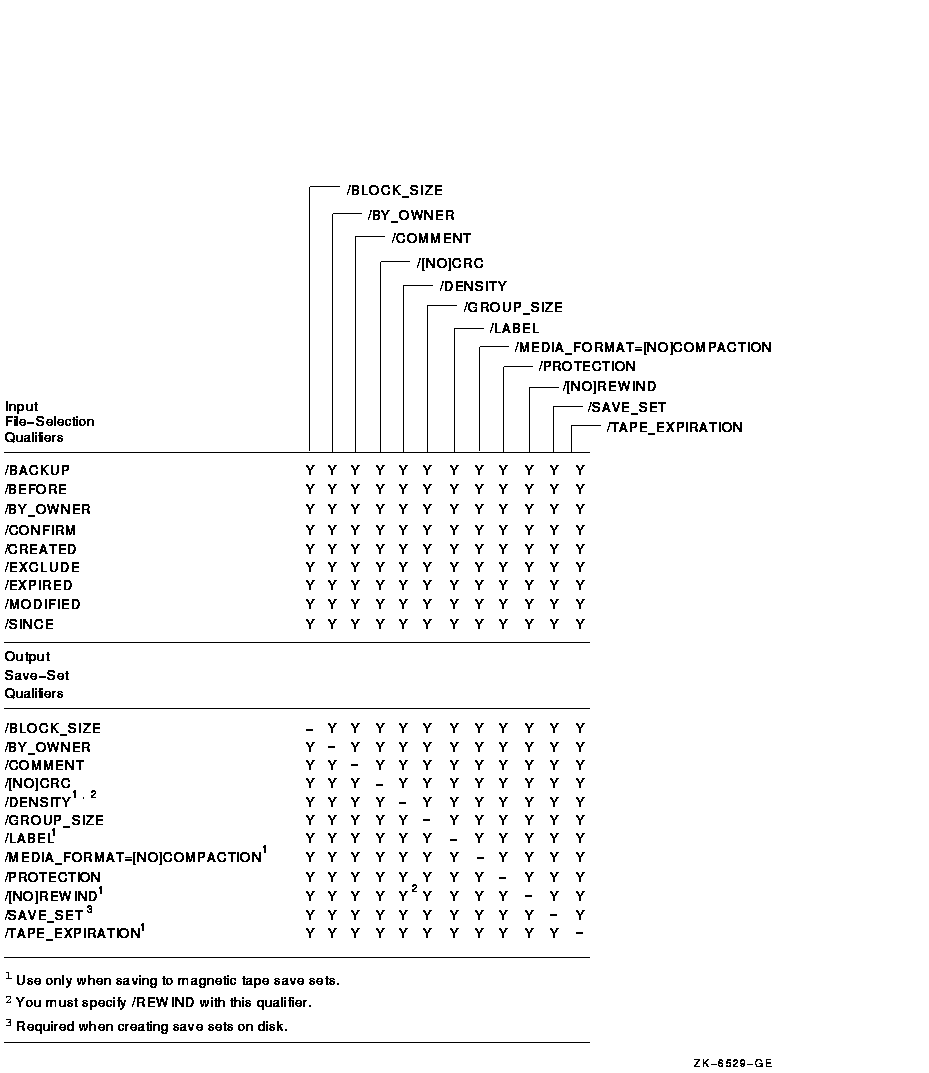
Figure G-4 Command Qualifiers Used in Restore Operations
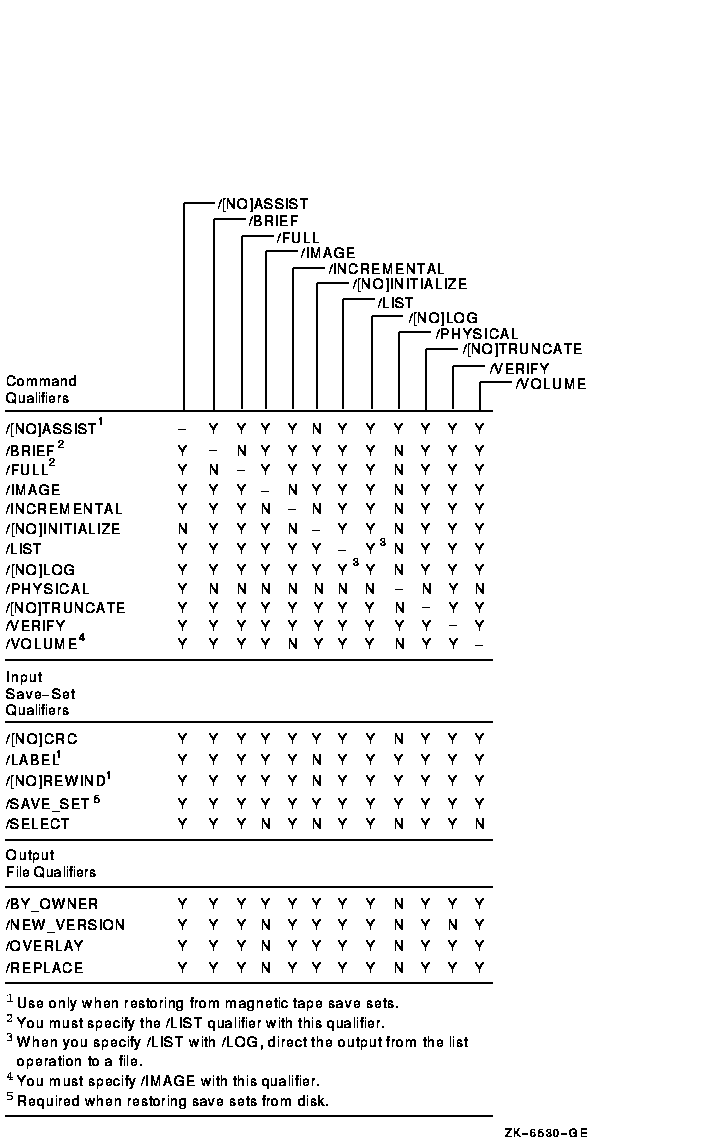
Figure G-5 Input Save-Set Qualifiers Used in Restore Operations
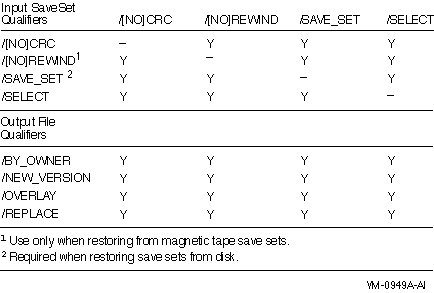
Figure G-6 Output File Qualifiers Used in Restore Operations
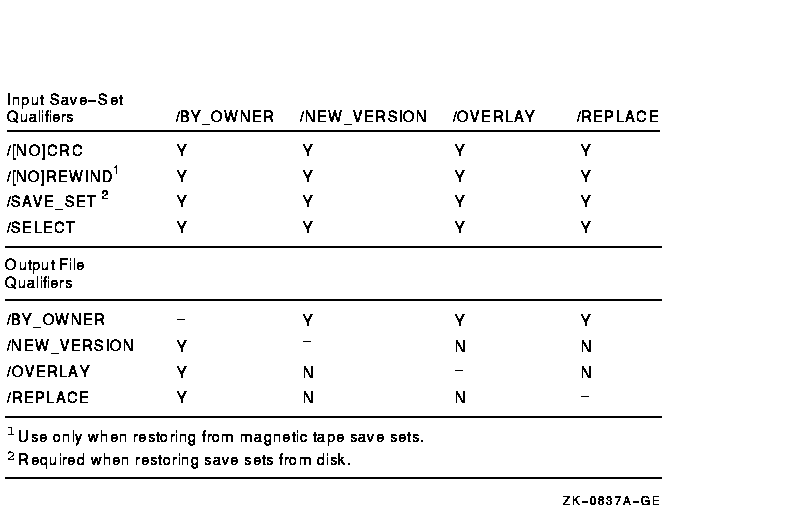
Figure G-7 Command Qualifiers Used in Copy Operations
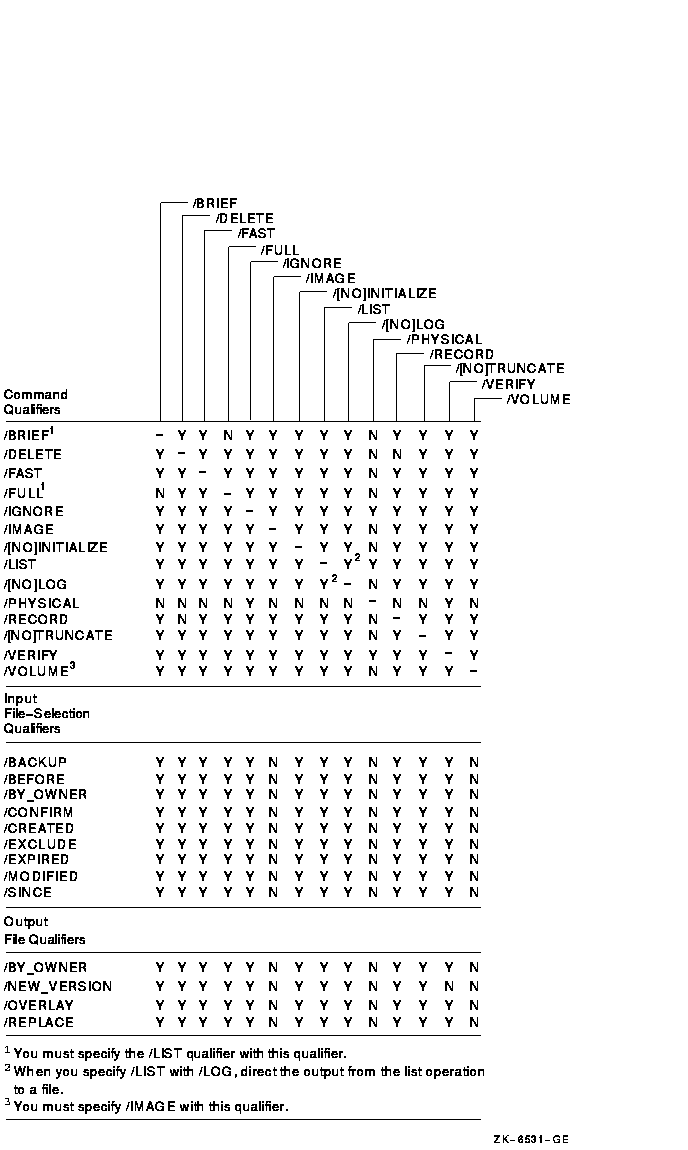
Figure G-8 Input File-Selection Qualifiers Used in Copy Operations
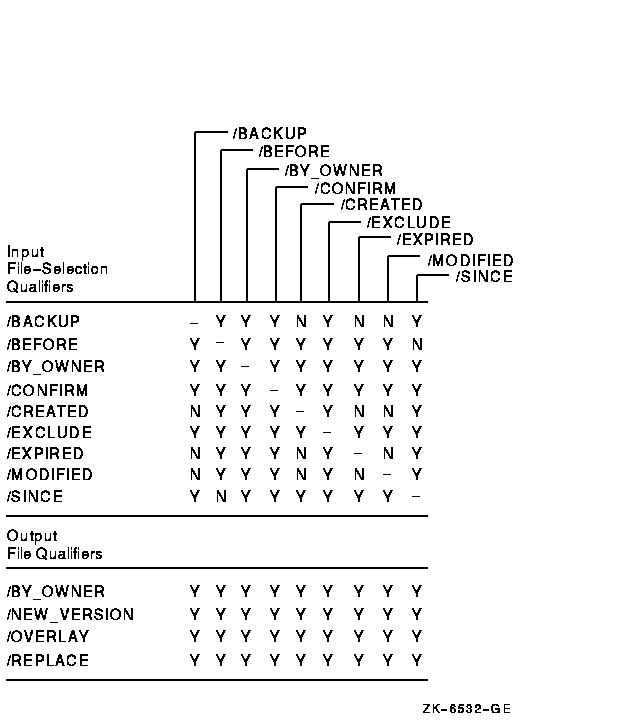
Figure G-9 Output File Qualifiers Used in Copy Operations
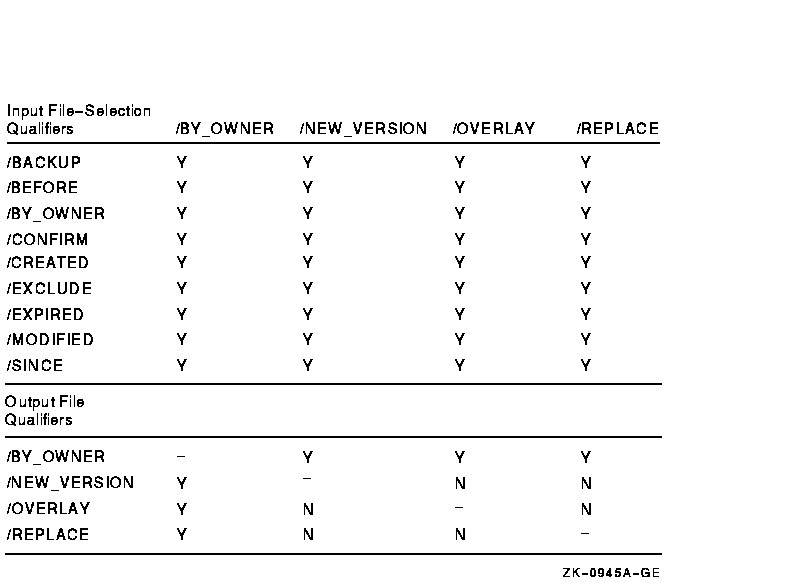
Figure G-10 Command Qualifiers Used in Compare Operations
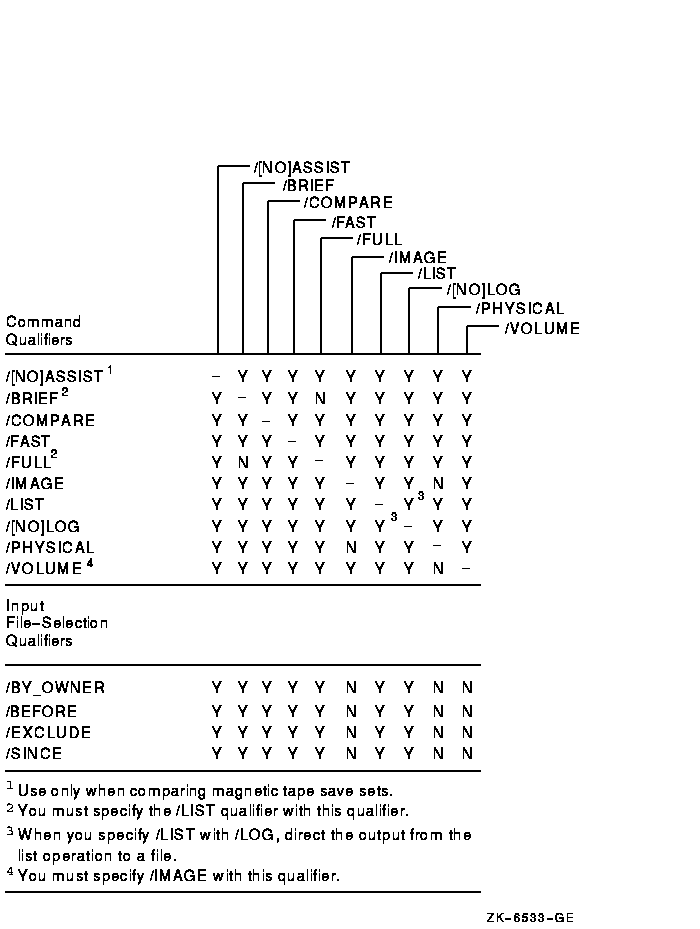
Figure G-11 Input File-Selection Qualifiers Used in Compare Operations
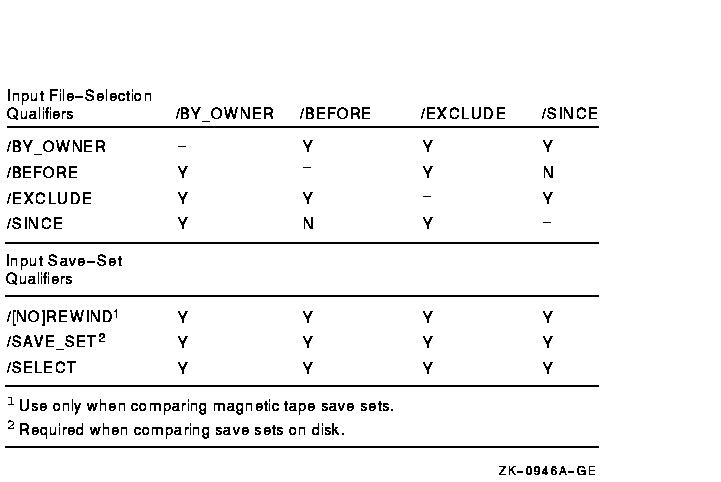
Figure G-12 Input Save-Set Qualifiers Used in Compare Operations
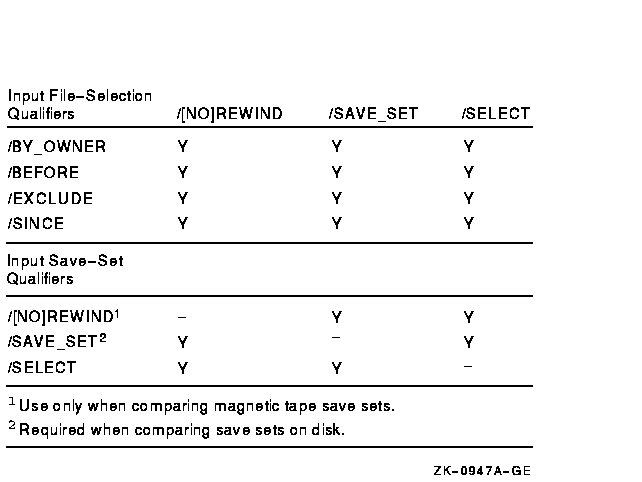
The following sections describe the MONITOR record formats.
Contact HP Customer Support to obtain the latest MONITOR record formats. |
Binary performance data is written into the MONITOR recording file when a MONITOR request indicates recording. A record is written to this file once per interval for each requested class. The record contains a predefined set of data for each of the requested performance classes.
The recording file is created when a MONITOR request is initiated, and is closed when the request terminates. The MONITOR recording file may be used as a source file to format and display the data on a terminal, to create a summary file, or to record a new recording file with different characteristics.
The record formats described in this section are subject to change without notice at any future OpenVMS release. |
The MONITOR recording file is an OpenVMS RMS sequential file with variable-length records. Each record in the file begins with a one-byte type field. The remaining fields are different in length and format for each record type. The following list contains three categories of record types:
Customer control records may appear anywhere in the recording file. They are not generated by MONITOR and are ignored by MONITOR when it reads the file.
The first records in the MONITOR recording file, excluding customer control records, are HP control records. The beginning of the file has three types of HP control records: the file header record, the system information record, and the record RMS file name record. Node transition records are also control records, but can appear anywhere in the file.
Class records, which contain data on requested performance classes, follow the HP control records. The class record is generally written once per interval for each class being recorded. An exception to this rule occurs when several class records are required to contain data for a single class over a single interval. This can occur for the PROCESSES class when too many processes exist to be accommodated by the maximum record size.
Unique numbers are assigned to each MONITOR record type. Record type numbers 0--127 are reserved for class records; numbers 128--191 are reserved for HP control records; numbers 192--255 are reserved for customer control records.
MONITOR generates 29 record types. The following table lists the MONITOR record types and their numbers, with associated class types. (For an explanation of MONITOR class types, refer to Section H.4.1.)
| Record Type | Type Number | Class Type |
|---|---|---|
| File Header | 128 | |
| System Information | 129 | |
| Node Transition | 130 | |
| RMS File Name | 131 | |
| PROCESSES Class | 0 | component |
| STATES Class | 1 | system |
| MODES Class | 2 | component |
| PAGE Class | 3 | system |
| IO Class | 4 | system |
| FCP Class | 5 | system |
| POOL Class 1 | 6 | system |
| LOCK Class | 7 | system |
| DECNET Class | 8 | system |
| RESERVED | 9 | system |
| RESERVED | 10 | system |
| FILE_SYSTEM_CACHE Class | 11 | system |
| DISK Class | 12 | component |
| RESERVED | 13 | component |
| DLOCK Class | 14 | system |
| SCS Class | 15 | component |
| RESERVED | 16 | system |
| SYSTEM Class | 17 | system |
| RESERVED | 18 | system |
| CLUSTER Class | 19 | system |
| RMS Class | 20 | component |
| MSCP_SERVER Class | 21 | system |
| TRANSACTION Class | 22 | system |
| VECTOR Class | 23 | component |
| VBS Class | 24 | system |
| RESERVED | 25 | system |
| RLOCK | 26 | system |
| TIMER | 27 | system |
The following sections define the contents of each field within each record type. Record type and record size are given in decimal representation. References to system time indicate time values in system time format (64-bit format).
The field offset names listed are not defined within MONITOR. However, HP recommends that you define and use these offset names when you work with MONITOR output records.
The following example is the suggested naming convention for the field offset names:
|
MNR_CCC$X_DDDDD |
CCC is a record type or class mnemonic.
X is a one-letter code indicating the size of the data item, as follows:
B for byte
W for word
L for longword
Q for quadword
O for octaword
T for ASCII string
DDDDD is the name describing the data item.
In the following tables that describe the record fields, the size of
the data is shown in parentheses following the description of the field
contents.
H.3 HP Control Records
The four types of HP control records are:
Each file has one header record, which contains information applicable to all classes of performance data contained in the file. It must be the first record (except for customer control records) in the file.
One system information record exists per node per file. The record
contains information about the system being monitored and follows the
header record in the file.
H.3.1 File Header Record
The file header record has a record type of 128 and a size of 259 bytes. Figure H-1 illustrates the format of the file header record.
Figure H-1 File Header Record Format
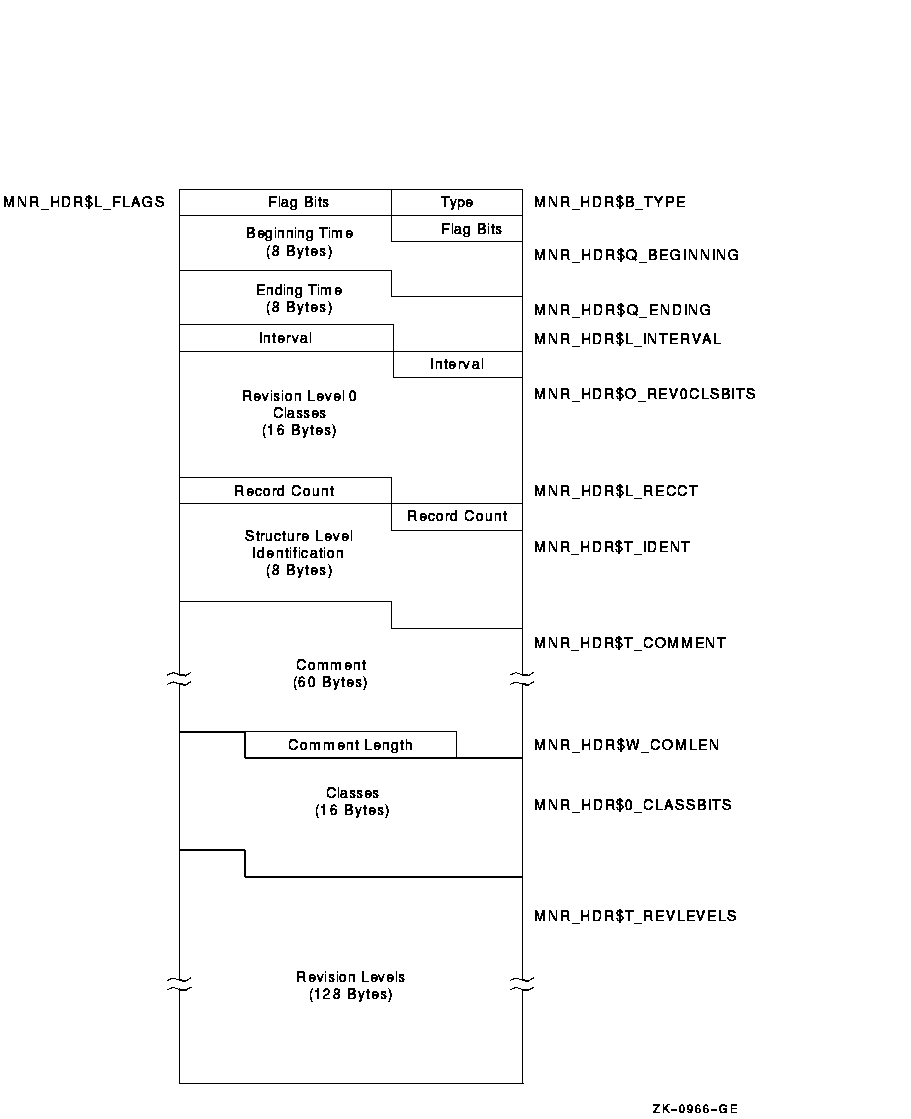
The following table describes the fields in the file header record:
| Field | Symbolic Offset | Contents |
|---|---|---|
| Type | MNR_HDR$B_TYPE | Record type identifier (1 byte). |
| Flags | MNR_HDR$L_FLAGS | Total of 32 flag bits; low-order bit = bit 0. All flags reserved to HP for future use (1 longword). |
| Beginning Time | MNR_HDR$Q_BEGINNING | System time of beginning of recording (1 quadword). |
| Ending Time | MNR_HDR$Q_ENDING | System time of end of recording (1 quadword). |
| Interval | MNR_HDR$L_INTERVAL | Interval in seconds between collections; this is the value specified by the user in the recording request. It is not necessarily equal to the exact interval value obtained by subtracting two consecutive time-stamps for a given class (1 longword). |
| Revision Level 0 Classes | MNR_HDR$O_REV0CLSBITS | A 128-bit string representing all classes; a bit set to 1 indicates the presence in this file of a class which is at revision level 0 and whose type number corresponds to the bit number. Low-order bit = bit 0 (1 octaword). This field is provided for compatibility with OpenVMS VAX Version 3.0 files. |
| Record Count | MNR_HDR$L_RECCT | Count of all records in the file (1 longword). |
| Structure Level Identification | MNR_HDR$T_IDENT | MONITOR Recording File Structure Level Identification (MON31050) (8 bytes). |
| Comment | MNR_HDR$T_COMMENT | Recording file description supplied by the user, including trailing blanks (60 bytes). |
| Comment Length | MNR_HDR$W_COMLEN | Actual length of recording file description string specified by the user (1 word). |
| Classes | MNR_HDR$O_CLASSBITS | A 128-bit string representing all classes; a bit set to 1 indicates the presence in this file of the class whose type number corresponds to the bit number. Low-order bit = bit 0 (1 octaword). |
| Revision Levels | MNR_HDR$T_REVLEVELS | A 128-byte string consisting of a one-byte binary revision level number for each class. A class has a revision level of 0 initially. For each MONITOR release, if the record definition has changed, the revision level will be increased (not necessarily by 1). |
H.3.2 System Information Record
The system information record has a record type of 129 and a size of 47
bytes. Figure H-2 illustrates the format of the system information
record.
Figure H-2 System Information Record Format
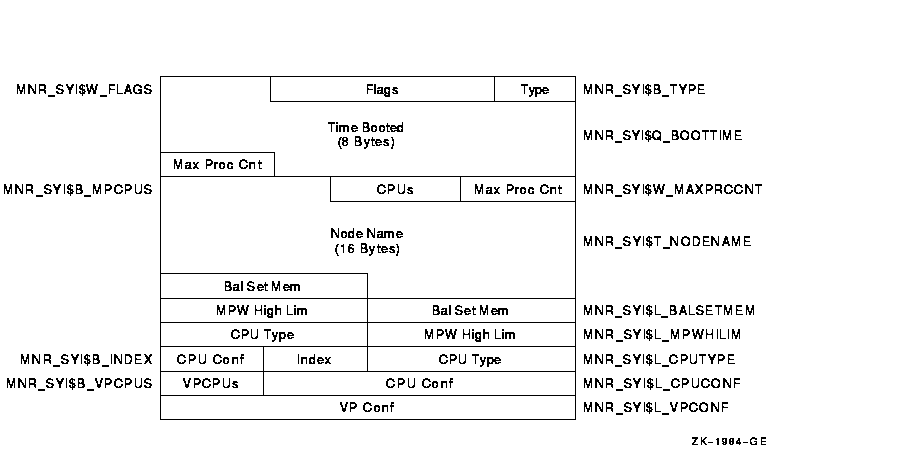
The following table describes the fields in the system information record:
| Field | Symbolic Offset | Contents |
|---|---|---|
| Type | MNR_SYI$B_TYPE | Type identifier (1 byte). |
| Flags | MNR_SYI$W_FLAGS | Total of 16 flag bits; low-order bit = bit 0. If bit 0 is set to 1, the node on which the data was collected is a member of a VAXcluster. All other flags reserved to HP for future use (1 word). |
| Time Booted | MNR_SYI$Q_BOOTTIME | System time at which system booted. MONITOR calculates this time by taking the number of seconds since system boot, converting this to a negative value, and adding it to the current system time (1 quadword). |
| Max Process Cnt | MNR_SYI$W_MAXPRCCNT | MAXPROCESSCNT system parameter value (1 word). |
| CPUs | MNR_SYI$B_MPCPUS | Number of CPUs (1 byte). |
| Node Name | MNR_SYI$T_NODENAME | Node name of node being monitored (counted ASCII string, 16 bytes). |
|
Balance Set
Memory (Bal Set Mem) |
MNR_SYI$L_BALSETMEM | Number of process pages to which memory can be allocated (1 longword). |
|
MPW High
Limit |
MNR_SYI$L_MPWHILIM | MPW_HILIMIT system parameter value (1 longword). |
| CPU Type | MNR_SYI$L_CPUTYPE | CPU type code. Use $PRDEF macro for code values (1 longword). |
| Index | MNR_SYI$B_INDEX | Identifies the position of this node in several internal MONITOR data structures (1 byte). |
| CPU Config | MNR_SYI$L_CPUCONF | Bit mask defining the location of each CPU in a multiprocessor (1 longword). |
| VPCPUs | MNR_SYI$B_VPCPUS | Number of vector-present processors in the current system (1 byte). |
| VP Config | MNR_SYI$L_VPCONF | Bit mask identifying the vector-present processors in the configuration (1 longword). |
The node transition record has a record type of 130 and a size of 2 bytes. Figure H-3 illustrates the format of the node transition record.
Figure H-3 Node Transition Record Format

The following table describes the fields in the node transition record:
| Field | Symbolic Offset | Contents |
|---|---|---|
| Type | MNR_NTR$B_TYPE | Record type identifier---indicates node removal operation (1 byte). |
| Index | MNR_NTR$B_INDEX | Identifies the position of this node in several internal MONITOR data structures (1 byte). |
The RMS file record has a record type of 131 and a variable size that depends on the number of RMS files and length of the file name string. Figure H-4 illustrates the format of the RMS file record.
Figure H-4 RMS File Record Format
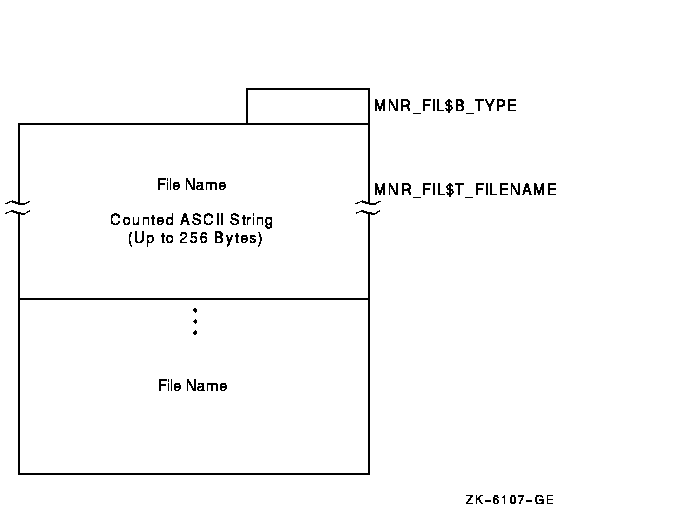
The following table describes the fields in the RMS file record:
| Field | Symbolic Offset | Contents |
|---|---|---|
| Type | MNR_FIL$B_TYPE | Record type identifier (1 byte). |
| Filename | MNR_FIL$T_FILENAME | A counted ASCII string that identifies the RMS file for MONITOR RMS requests (up to 256 bytes). |
The MONITOR recording file contains one class record for each requested
class for every collection interval, except for the PROCESSES class.
(See Section H.4.2.12 for more information about the PROCESSES class
records.) For example, if a MONITOR user requested to record five
classes (excluding PROCESSES) for a duration of 100 collection
intervals, the file would contain 500 class records. Class records
occur in order of increasing type number within an interval. The first
class record for a given interval follows the last class record for the
previous interval.
H.4.1 Class Type Formats
The two basic class types are system classes and component classes. A class record for a system class generally consists of counts for systemwide activities (such as page faults), whereas a class record for a component class normally contains a count for each element of a measured activity (such as I/O operations for each disk in the system).
Specifically, a class record for a system class consists of a class header followed by a data block. A class record for a component class has a class header followed by a class prefix and one data block per element.
Figure H-5 illustrates the format for class records.
Figure H-5 Class Record Format
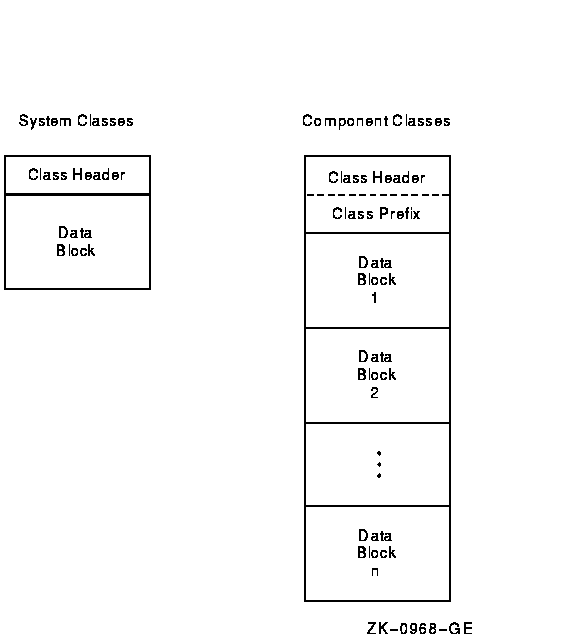
The class header is the first part of every class record. Its format is independent of class. The class header is 13 bytes long.
Figure H-6 illustrates the format of the class header.
Figure H-6 Class Header Format

The following table describes the fields in the class header:
| Field | Symbolic Offset | Contents |
|---|---|---|
| Type | MNR_CLS$B_TYPE | Record type identifier (1 byte). |
| Flags | MNR_CLS$B_FLAGS | Total of 8 flag bits; low order bit = bit 0. If bit 0 is set to 1, the data for this interval continues in the next record. Can be set for the PROCESSES class only. All other flags reserved by HP for future use (1 byte). |
| Index | MNR_CLS$B_INDEX | Identifies the position of this node in several internal MONITOR data structures (1 byte). |
| Time | MNR_CLS$Q_STAMP | System time at which this class record was recorded. The time value is nondecreasing across all class records in the file. |
| Reserved | MNR_CLS$W_RESERVED | Reserved for HP use (1 word). |
The class prefix always follows the class header for component class records. It contains data describing the number of elements (for example, processes for the PROCESSES class, disks for the DISK class) represented by the class records for the current collection interval. Unlike system class records, which have one data block per record, component classes have one data block per element.
One of the class prefix data items describes the number of elements (and therefore the number of data blocks) included in the class record. The other class prefix data item is used only for the PROCESSES class, and describes the number of processes included in the interval. The following discussion applies only to the PROCESSES class.
It is possible to monitor a number of processes so large that the required number of data blocks for one collection interval does not fit into a single maximum size record. In this case, the required number of PROCESSES class records is created to fully describe the processes.
All class headers in the set of PROCESSES class records for a given interval are identical, except for the setting of bit 0 in the MNR_CLS$W_FLAGS field. This bit is set to 1 for all records except the last, for which it is set to 0.
The class prefixes in the set of class records vary, as described in the table following the next figure. The contents of the MNR_CMP$L_ELTCT field depends on the number of data blocks contained in the record; the contents of the MNR_CMP$L_PCTINT field remain constant for each record in the set. All records in the set except the last contain as many data blocks as will fit into the maximum size record (32000 bytes). The last record in the set contains the remaining data blocks.
Figure H-7 illustrates the class prefix format.
Figure H-7 Class Prefix Format

The following table describes the fields in the class prefix. The class prefix is 8 bytes long.
| Field | Symbolic Offset | Contents |
|---|---|---|
|
Elements in
Record |
MNR_CMP$L_ELTCT | Count of elements (data blocks) in this record (1 longword). |
|
Processes in
Interval |
MNR_CMP$L_PCTINT | Count of processes (data blocks) for this interval (1 longword). This field is for the PROCESSES class only. For other component classes, this longword is reserved to HP for future use. |
The size and format of each data block and the number of blocks per record depend on the class. System classes have one data block per record. Component classes have one data block per element. The fields within each block are performance data items.
The following sections describe the data items within the data block for each class. Every data item falls into one of three categories. It is either a count, a level, or an informational item. A count is a numeric quantity that increases at each succeeding interval for the duration of a system boot. A level is a numeric quantity that may increase or decrease at each succeeding interval. An informational item represents data that, rather than being a unit of performance measurement (as are the first two types), is descriptive in nature.
In the tables that follow, item types are identified by the letters C
(count), L (level), and I (informational). Item types are shown in
parentheses, following the length of the field. Class records are
listed alphabetically.
H.4.2.1 CLUSTER Class Record
The CLUSTER class record contains data describing clusterwide CPU, memory, and locking activity. The CLUSTER class record has a record type of 19 and a size of 65 bytes. Note that when the CLUSTER class is recorded, the DISK and MODES classes are also recorded, even if not explicitly requested.
Figure H-8 illustrates the format of the CLUSTER class record.
Figure H-8 CLUSTER Class Record Format
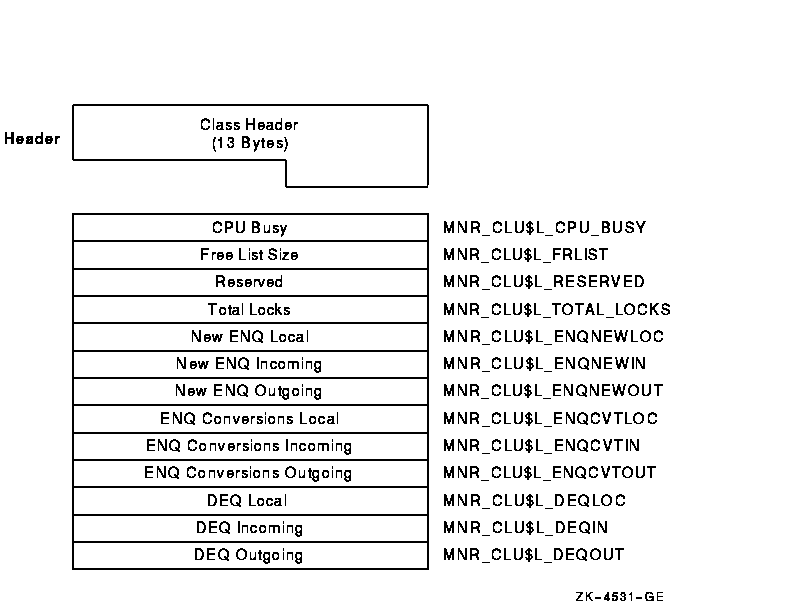
The following table describes the fields in the data block for the CLUSTER class record:
| Field | Symbolic Offset | Contents |
|---|---|---|
| CPU Busy | MNR_CLU$L_CPU_BUSY | Count of clock ticks (10-millisecond units) spent in all CPU modes since system was booted (longword,C) |
| Free List Size | MNR_CLU$L_FRLIST | Number of pages currently on the free list (longword,L) |
| Reserved | MNR_CLU$L_RESERVED | Reserved to HP |
| Total Locks | MNR_CLU$L_TOTAL_LOCKS | Total of all incoming, outgoing, and local ENQs, DEQs, and conversions (longword,C) |
| New ENQ Local | MNR_CLU$L_ENQNEWLOC | Count of new lock requests that originate and are performed on the system (local) (longword,C) |
| New ENQ Incoming | MNR_CLU$L_ENQNEWIN | Count of new lock requests that originate on other systems and are performed on this system (incoming) (longword,C) |
| New ENQ Outgoing | MNR_CLU$L_ENQNEWOUT | Count of new lock requests that originate on this system and are performed on other systems (outgoing) (longword,C) |
| ENQ Conversions Local | MNR_CLU$L_ENQCVTLOC | Count of lock conversion requests (local) (longword,C) |
| ENQ Conversions Incoming | MNR_CLU$L_ENQCVTIN | Count of lock conversion requests (incoming) (longword,C) |
| ENQ Conversions Outgoing | MNR_CLU$L_ENQCVTOUT | Count of lock conversion requests (outgoing) (longword,C) |
| DEQ Local | MNR_CLU$L_DEQLOC | Count of unlock requests (local) (longword,C) |
| DEQ Incoming | MNR_CLU$L_DEQIN | Count of unlock requests (incoming) (longword,C) |
| DEQ Outgoing | MNR_CLU$L_DEQOUT | Count of unlock requests (outgoing) (longword,C) |
The DECNET class record contains data describing the operation of the DECnet for OpenVMS subsystem. The DECNET class record has a record type of 8 and a size of 33 bytes.
Figure H-9 illustrates the format of the DECNET class record.
Figure H-9 DECNET Class Record Format
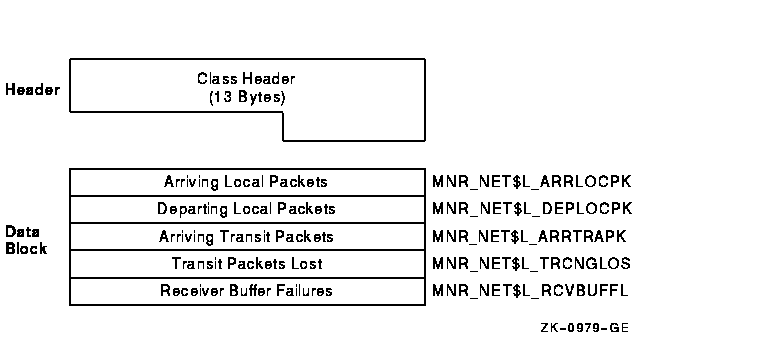
The following table describes the fields in the data block for the DECNET class record:
| Field | Symbolic Offset | Contents |
|---|---|---|
|
Arriving
Local Packets |
MNR_NET$L_ARRLOCPK | Count of arriving local packets (longword,C) |
|
Departing
Local Packets |
MNR_NET$L_DEPLOCPK | Count of departing local packets (longword,C) |
|
Arriving Transit
Packets |
MNR_NET$L_ARRTRAPK | Count of arriving transit packets (longword,C) |
|
Transit Packets
Lost |
MNR_NET$L_TRCNGLOS | Count of packets lost because of transit congestion (longword,C) |
|
Receiver Buffer
Failures |
MNR_NET$L_RCVBUFFL | Count of receiver buffer failures (longword,C) |
The DISK class record contains data describing all disk devices in the system. The DISK class record has a record type of 12; its size depends on the number of disks being monitored. The size, in bytes, is calculated by adding the size of the class header, the class prefix, and the data blocks contained in the record. This is shown in the following formula:
13 + 8 + (37 * the value of MNR_CMP$L_ELTCT) |
Figure H-10 illustrates the format of the DISK class record.
Figure H-10 DISK Class Record Format
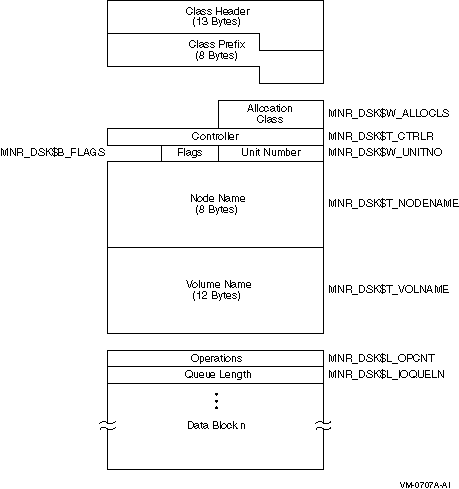
The following table describes the fields in the data block for the DISK class record:
| Field | Symbolic Offset | Contents |
|---|---|---|
| Allocation Class | MNR_DSK$W_ALLOCLS | Allocation class number (word,I) |
| Controller | MNR_DSK$T_CTRLR | Name of device controller (counted ASCII string) (4 bytes,I) |
| Unit Number | MNR_DSK$W_UNITNO | Unit number (word,I) |
| Flags | MNR_DSK$B_FLAGS | Total of 8 flag bits; if the low bit is set, the device is served by the MSCP server (byte,I) |
| Node Name | MNR_DSK$T_NODENAME | Name of cluster node where device resides (counted ASCII string) (8 bytes,I) |
| Volume Name | MNR_DSK$T_VOLNAME | Volume name of disk (ASCII) (12 bytes,I) |
| Operations | MNR_DSK$L_OPCNT | Count of I/O operations (longword,C) |
| Queue Length | MNR_DSK$L_IOQUELN | Sum of I/O request queue samples (longword,C) |
The DLOCK class record contains data describing the operation of the Distributed Lock Management facility. The DLOCK class record has a record type of 14 and a size of 73 bytes.
Figure H-11 illustrates the format of the DLOCK class record.
Figure H-11 DLOCK Class Record Format
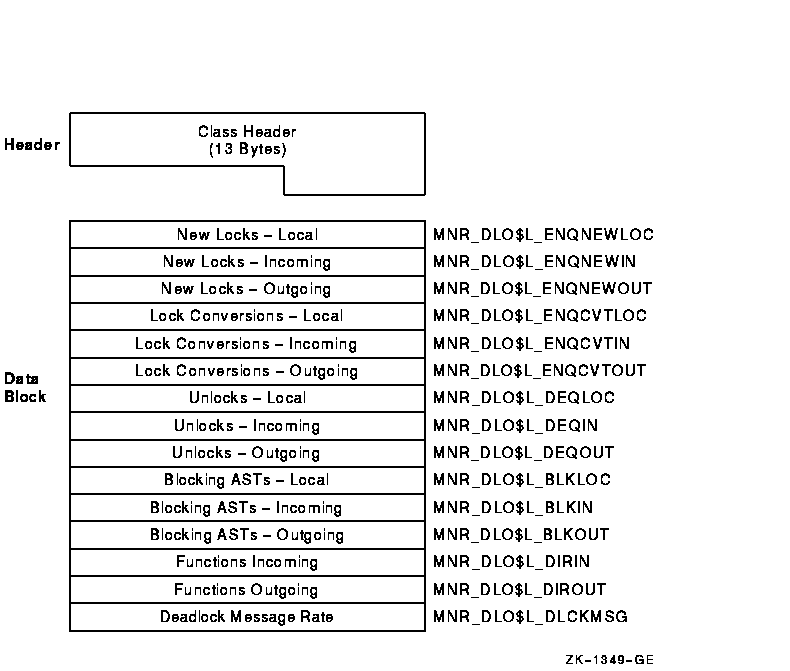
The following table describes the fields in the data block for the DLOCK class record:
| Field | Symbolic Offset | Contents |
|---|---|---|
|
New Locks
---Local |
MNR_DLO$L_ENQNEWLOC | Count of new lock requests that originate and are performed on this system (local) (longword,C) |
|
New Locks
---Incoming |
MNR_DLO$L_ENQNEWIN | Count of new lock requests originating on another system and performed on this system (incoming) (longword,C) |
|
New Locks
---Outgoing |
MNR_DLO$L_ENQNEWOUT | Count of new lock requests originating on this system and performed on another system (outgoing) (longword,C) |
|
Lock Conversions
---Local |
MNR_DLO$L_ENQCVTLOC | Count of lock conversion requests (local) (longword,C) |
|
Lock Conversions
---Incoming |
MNR_DLO$L_ENQCVTIN | Count of lock conversion requests (incoming) (longword,C) |
|
Lock Conversions
---Outgoing |
MNR_DLO$L_ENQCVTOUT | Count of lock conversion requests (outgoing) (longword,C) |
| Unlocks---Local | MNR_DLO$L_DEQLOC | Count of unlock requests (local) (longword,C) |
| Unlocks---Incoming | MNR_DLO$L_DEQIN | Count of unlock requests (incoming) (longword,C) |
| Unlocks---Outgoing | MNR_DLO$L_DEQOUT | Count of unlock requests (outgoing) (longword,C) |
|
Blocking ASTs
---Local |
MNR_DLO$L_BLKLOC | Count of lock manager blocking ASTs (local) (longword,C) |
|
Blocking ASTs
---Incoming |
MNR_DLO$L_BLKIN | Count of lock manager blocking ASTs (incoming) (longword,C) |
|
Blocking ASTs
---Outgoing |
MNR_DLO$L_BLKOUT | Count of lock manager blocking ASTs (outgoing) (longword,C) |
|
Directory Functions
---Incoming |
MNR_DLO$L_DIRIN | Count of directory functions (incoming) (longword,C) |
|
Directory Functions
---Outgoing |
MNR_DLO$L_DIROUT | Count of directory functions (outgoing) (longword,C) |
|
Deadlock
Message Rate |
MNR_DLO$L_DLCKMSG | Count of incoming and outgoing lock manager messages required for deadlock detection (longword,C) |
The FCP class record contains data describing the operation of the file system ACPs. The FCP class record has a record type of 5 and a size of 61 bytes.
Figure H-12 illustrates the format of the FCP class record.
Figure H-12 FCP Class Record Format
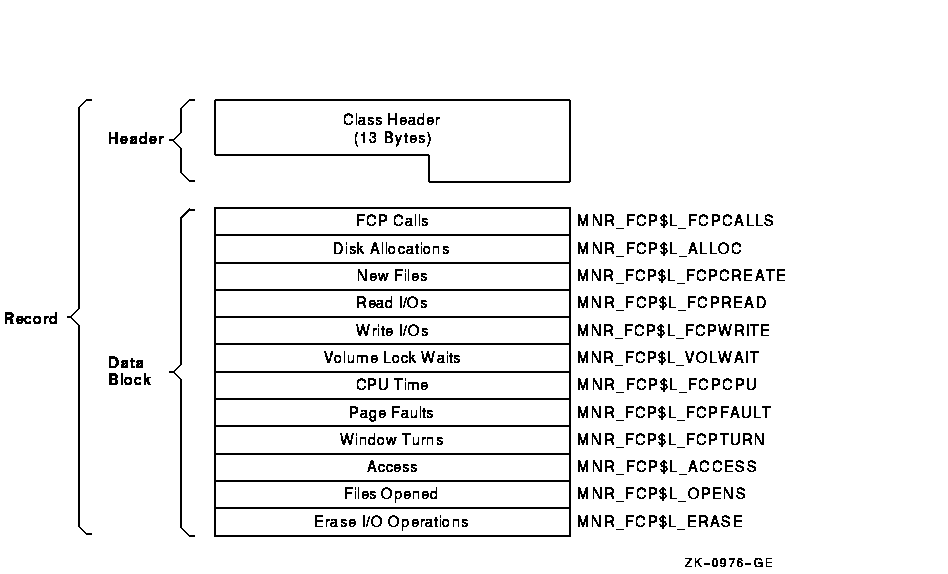
The following table describes the fields in the data block for the FCP class record:
| Field | Symbolic Offset | Contents |
|---|---|---|
| FCP Calls | MNR_FCP$L_FCPCALLS | Count of QIO requests received by the file system (longword,C) |
| Disk Allocations | MNR_FCP$L_ALLOC | Count of QIO requests that caused allocation of disk space (longword,C) |
| New Files | MNR_FCP$L_FCPCREATE | Count of new files created (longword,C) |
| Read I/Os | MNR_FCP$L_FCPREAD | Count of read I/O operations from the disk by the file system (longword,C) |
| Write I/Os | MNR_FCP$L_FCPWRITE | Count of write I/O operations to disk by the file system (longword,C) |
| Volume Lock Waits | MNR_FCP$L_VOLWAIT | Number of times a wait state was entered by the XQP due to volume lock contention (longword,C) |
| CPU Time | MNR_FCP$L_FCPCPU | Count of clock ticks (10-millisecond units) of CPU time used by the file system (longword,C) |
| FCP Page Faults | MNR_FCP$L_FCPFAULT | Count of page faults for the file system (longword,C) |
| Window Turns | MNR_FCP$L_FCPTURN | Count of file-map window misses (longword,C) |
| Access | MNR_FCP$L_ACCESS | Count of file name lookup operations in file directories (longword,C) |
| Files Opened | MNR_FCP$L_OPENS | Count of files opened (longword,C) |
|
Erase I/O
Operations |
MNR_FCP$L_ERASE | Count of erase I/O operations issued (longword,C) |
The FILE_SYSTEM_CACHE class record contains data describing the operation of the caches for the file system ACPs and XQPs. The FILE_SYSTEM_CACHE class record has a record type of 11 and a size of 69 bytes.
Figure H-13 illustrates the format of the FILE_SYSTEM_CACHE class record.
Figure H-13 FILE_SYSTEM_CACHE Class Record Format
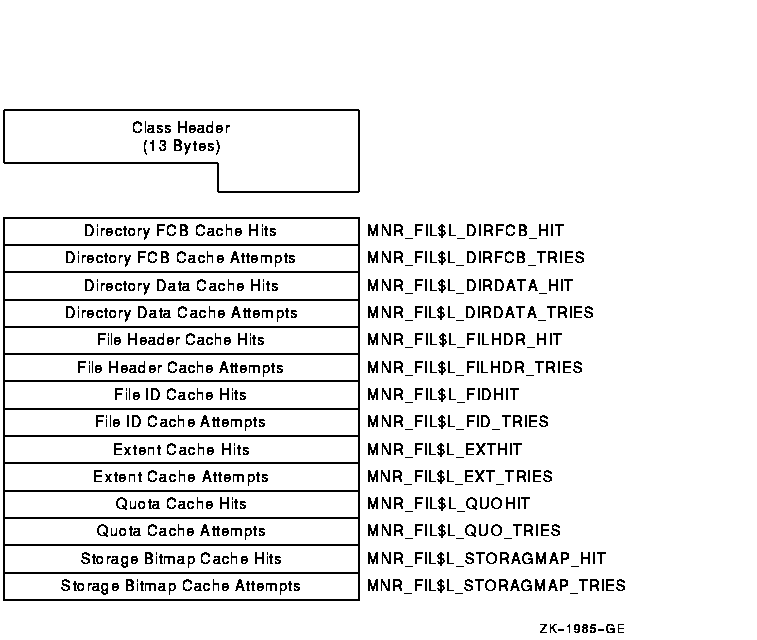
The following table describes the fields in the data block for the FILE_SYSTEM_CACHE class record:
| Field | Symbolic Offset | Contents |
|---|---|---|
|
Directory FCB
Cache Hits |
MNR_FIL$L_DIRFCB_HIT | Count of hits on directory FCB cache (longword,C) |
|
Directory FCB
Cache Attempts |
MNR_FIL$L_DIRFCB_TRIES | Count of attempts on directory FCB cache (longword,C) |
|
Directory Data
Cache Hits |
MNR_FIL$L_DIRDATA_HIT | Count of hits on directory data cache (longword,C) |
|
Directory Data
Cache Attempts |
MNR_FIL$L_DIRDATA_TRIES | Count of attempts on directory data cache (longword,C) |
|
File Header
Cache Hits |
MNR_FIL$L_FILHDR_HIT | Count of hits on file header cache (longword,C) |
|
File Header
Cache Attempts |
MNR_FIL$L_FILHDR_TRIES | Count of attempts on file header cache (longword,C) |
|
File ID
Cache Hits |
MNR_FIL$L_FIDHIT | Count of hits on file ID cache (longword,C) |
|
File ID
Cache Attempts |
MNR_FIL$L_FID_TRIES | Count of attempts on file ID cache (longword,C) |
|
Extent Cache
Hits |
MNR_FIL$L_EXTHIT | Count of hits on extent cache (longword,C) |
|
Extent Cache
Attempts |
MNR_FIL$L_EXT_TRIES | Count of attempts on extent cache (longword,C) |
|
Quota Cache
Hits |
MNR_FIL$L_QUOHIT | Count of hits on quota cache (longword,C) |
|
Quota Cache
Attempts |
MNR_FIL$L_QUO_TRIES | Count of attempts on quota cache (longword,C) |
|
Storage Bitmap
Cache Hits |
MNR_FIL$L_STORAGMAP_HIT | Count of hits on storage bitmap cache (longword,C) |
|
Storage Bitmap
Cache Attempts |
MNR_FIL$L_STORAGMAP_TRIES | Count of attempts on storage bitmap cache (longword,C) |
The I/O class record contains data describing the operation of the I/O subsystem. The I/O class record has a record type of 4 and a size of 69 bytes.
Figure H-14 illustrates the format of the I/O class record.
Figure H-14 I/O Class Record Format
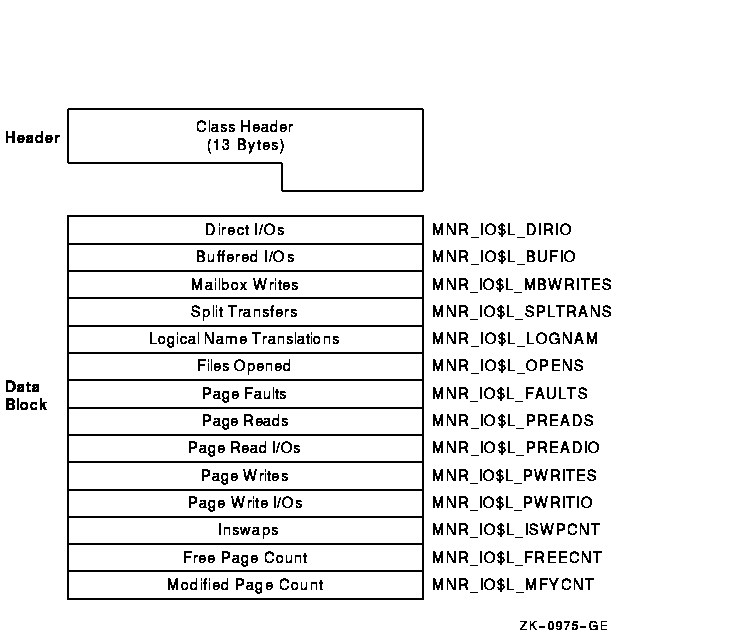
The following table describes the fields in the data block for the I/O class record:
| Field | Symbolic Offset | Contents |
|---|---|---|
| Direct I/Os | MNR_IO$L_DIRIO | Count of direct I/O operations (longword,C) |
| Buffered I/Os | MNR_IO$L_BUFIO | Count of buffered I/O operations (longword,C) |
| Mailbox Writes | MNR_IO$L_MBWRITES | Count of write-to-mailbox requests (longword,C) |
| Split Transfers | MNR_IO$L_SPLTRANS | Count of split transfers (longword,C) |
|
Logical Name
Translations |
MNR_IO$L_LOGNAM | Count of logical name translations (longword,C) |
| Files Opened | MNR_IO$L_OPENS | Count of files opened (longword,C) |
| Page Faults | MNR_IO$L_FAULTS | Count of page faults for all working sets (longword,C) |
| Page Reads | MNR_IO$L_PREADS | Count of pages read from disk as a result of page faults (longword,C) |
| Page Read I/Os | MNR_IO$L_PREADIO | Count of read I/O operations from disk as a result of page faults (longword,C) |
| Page Writes | MNR_IO$L_PWRITES | Count of pages written to the page file (longword,C) |
| Page Write I/Os | MNR_IO$L_PWRITIO | Count of write I/O operations to the page file (longword,C) |
| Inswaps | MNR_IO$L_ISWPCNT | Count of working sets read into memory from the swap file (longword,C) |
| Free Page Count | MNR_IO$L_FREECNT | Number of pages currently on free-page list (longword,L) |
|
Modified Page
Count |
MNR_IO$L_MFYCNT | Number of pages currently on modified-page list (longword,L) |
The LOCK class record contains data describing the operation of the lock management subsystem. The LOCK class record has a record type of 7 and a size of 53 bytes.
Figure H-15 illustrates the format of the LOCK class record.
Figure H-15 LOCK Class Record Format
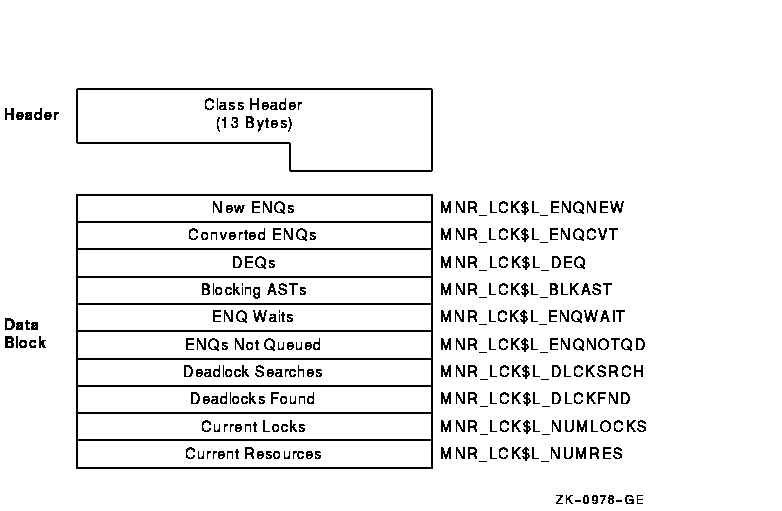
The following table describes the fields in the data block for the LOCK class record:
| Field | Symbolic Offset | Contents |
|---|---|---|
| New ENQs | MNR_LCK$L_ENQNEW | Count of new ENQ (lock) requests (longword,C) |
| Converted ENQs | MNR_LCK$L_ENQCVT | Count of converted ENQ (lock) requests (longword,C) |
| DEQs | MNR_LCK$L_DEQ | Count of DEQ (unlock) requests (longword,C) |
| Blocking ASTs | MNR_LCK$L_BLKAST | Count of blocking ASTs queued (longword,C) |
| ENQ Waits | MNR_LCK$L_ENQWAIT | Count of times a lock could not be granted immediately and waited (longword,C) |
| ENQs Not Queued | MNR_LCK$L_ENQNOTQD | Count of times a lock could not be granted immediately and got an error status instead of waiting (longword,C) |
| Deadlock Searches | MNR_LCK$L_DLCKSRCH | Count of times that a deadlock search was performed (longword,C) |
| Deadlocks Found | MNR_LCK$L_DLCKFND | Count of times that a deadlock was found (longword,C) |
| Current Locks | MNR_LCK$L_NUMLOCKS | Number of locks currently in the system (longword,L) |
| Current Resources | MNR_LCK$L_NUMRES | Number of resources currently in the system (longword,L) |
The MODES class record contains data describing time spent in each of the processor modes. The MODES class record has a record type of 2; its size depends on the number of active CPUs on the system being monitored. The size, in bytes, is calculated by adding the size of the class header, the class prefix, and the data blocks contained in the record. This is shown in the following formula, which assumes that all CPUs are active:
13 + 8 + (33 * MNR_SYI$B_MPCPUS) |
Figure H-16 illustrates the format of the MODES class record.
Figure H-16 MODES Class Record Format
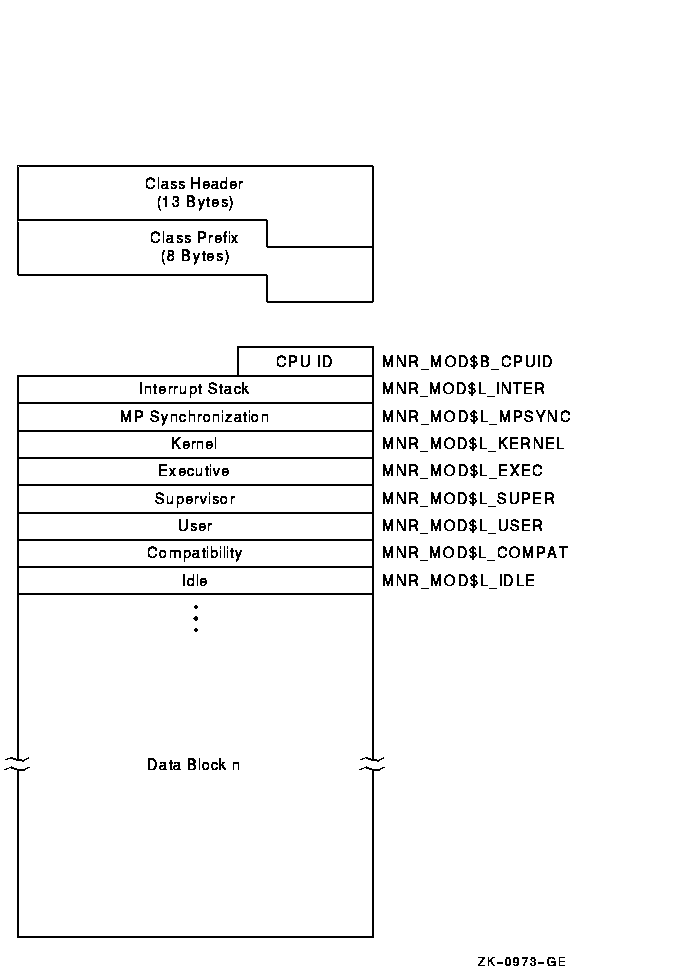
The following table describes the fields in the data block for the MODES class record:
| Field | Symbolic Offset | Contents |
|---|---|---|
| CPU ID | MNR_MOD$B_CPUID | CPU identification (byte,I) |
| Interrupt Stack | MNR_MOD$L_INTER | Count of clock ticks (10-millisecond units) spent on interrupt stack since system was booted (longword,C) |
| MP Synchronization | MNR_MOD$L_MPSYNC | Count of clock ticks spent synchronizing multiple CPUs since system boot |
| Kernel | MNR_MOD$L_KERNEL | Count of clock ticks spent in kernel mode, excluding interrupt stack time, since system boot (longword,C) |
| Executive | MNR_MOD$L_EXEC | Count of clock ticks spent in executive mode since system boot (longword,C) |
| Supervisor | MNR_MOD$L_SUPER | Count of clock ticks spent in supervisor mode since system boot (longword,C) |
| User | MNR_MOD$L_USER | Count of clock ticks spent in user mode, excluding compatibility mode time since system boot (longword,C) |
| Compatibility | MNR_MOD$L_COMPAT | Count of clock ticks boot spent in compatibility mode since system boot (longword,C) |
| Idle | MNR_MOD$L_IDLE | Count of clock ticks spent executing the NULL process since system boot (longword,C) |
The MSCP_SERVER class record contains data describing activities of the MSCP server. The MSCP_SERVER class record has a record type of 21 and a size of 65 bytes.
Figure H-17 illustrates the format of the MSCP_SERVER class record.
Figure H-17 MSCP_SERVER Class Record Format
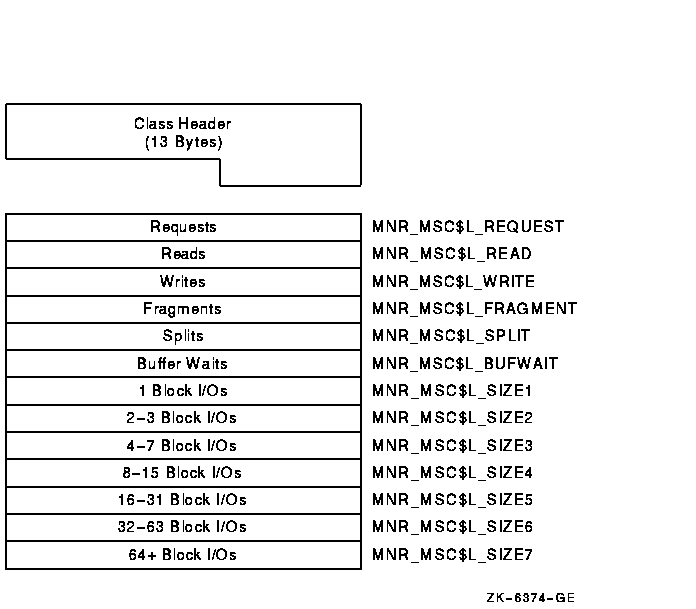
The following table describes the fields in the data block for the MSCP_SERVER class record:
| Field | Symbolic Offset | Contents |
|---|---|---|
| Requests | MNR_MSC$L_REQUEST | Count of requests for I/O transfers by remote processors (longword,C) |
| Reads | MNR_MSC$L_READ | Count of requests for Read I/O transfers by remote processors (longword,C) |
| Writes | MNR_MSC$L_WRITE | Count of requests for Write I/O transfers by remote processors (longword,C) |
| Fragments | MNR_MSC$L_FRAGMENT | Count of extra fragments issued by the server (longword,C) |
| Splits | MNR_MSC$L_SPLIT | Count of fragmented requests issued by the server (longword,C) |
| Buffer Waits | MNR_MSC$L_BUFWAIT | Count of requests that had to wait for MSCP buffer memory (longword,C) |
| 1 Block I/Os | MNR_MSC$L_SIZE1 | Count of I/O requests with a length of one block (longword,C) |
| 2---3 Block I/Os | MNR_MSC$L_SIZE2 | Count of I/O requests with a length of 2 to 3 blocks (longword,C) |
| 4---7 Block I/Os | MNR_MSC$L_SIZE3 | Count of I/O requests with a length of 4 to 7 blocks (longword,C) |
| 8---15 Block I/Os | MNR_MSC$L_SIZE4 | Count of I/O requests with a length of 8 to 15 blocks (longword,C) |
| 16---31 Block I/Os | MNR_MSC$L_SIZE5 | Count of I/O requests with a length of 16 to 31 blocks (longword,C) |
| 32---63 Block I/Os | MNR_MSC$L_SIZE6 | Count of I/O requests with a length of 32 to 63 blocks (longword,C) |
| 64+ Block I/Os | MNR_MSC$L_SIZE7 | Count of I/O requests with a length equal to or greater than 64 blocks (longword,C) |
The PAGE class record contains data describing the operation of the page management subsystem. The PAGE class record has a record type of 3 and a size of 65 bytes.
Figure H-18 illustrates the format of the PAGE class record.
Figure H-18 PAGE Class Record Format
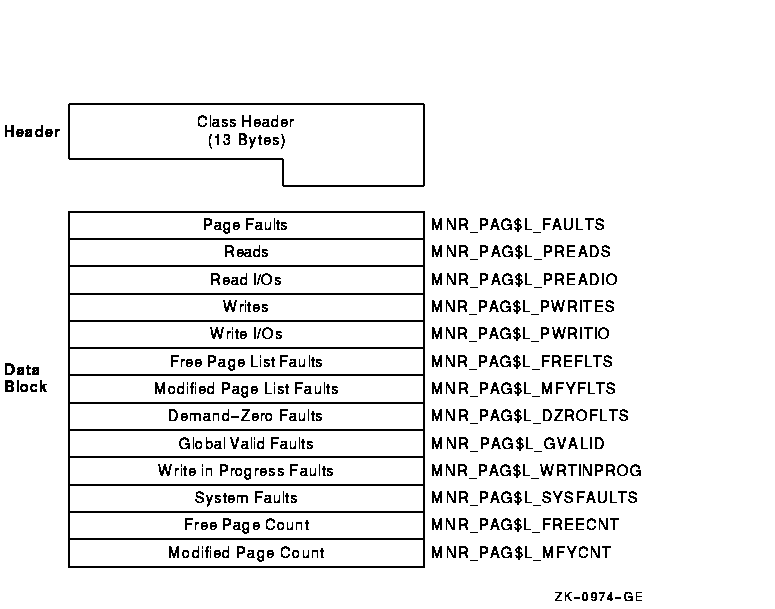
The following table describes the fields in the data block for the PAGE class record:
| Field | Symbolic Offset | Contents |
|---|---|---|
| Page Faults | MNR_PAG$L_FAULTS | Count of page faults for all working set (longword,C) |
| Reads | MNR_PAG$L_PREADS | Count of pages read from disk as a result of page faults (longword,C) |
| Read I/Os | MNR_PAG$L_PREADIO | Count of read I/Os as a result of operations from disk page faults (longword,C) |
| Writes | MNR_PAG$L_PWRITES | Count of pages written to the page file (longword,C) |
| Write I/Os | MNR_PAG$L_PWRITIO | Count of write I/O operations to the page file (longword,C) |
|
Free-page
List Faults |
MNR_PAG$L_FREFLTS | Count of pages read from the free list as a result of page faults (longword,C) |
|
Modified-page
List Faults |
MNR_PAG$L_MFYFLTS | Count of pages read from the modified list as a result of page faults (longword,C) |
|
Demand-zero
Faults |
MNR_PAG$L_DZROFLTS | Count of zero-filled pages allocated as a result of faults (longword,C) |
|
Global Valid
Faults |
MNR_PAG$L_GVALID | Count of page faults for which the reference page was found to be valid in the system global page tables (longword,C) |
|
Write-in-Progress
Faults |
MNR_PAG$L_WRTINPROG | Count of pages read that were in the process of being written back to disk when faulted (longword,C) |
| System Faults | MNR_PAG$L_SYSFAULTS | Count of page faults for which the referenced page is in system space (longword,C) |
| Free-page Count | MNR_PAG$L_FREECNT | Number of pages currently on free-page list (longword,L) |
|
Modified-page
Count |
MNR_PAG$L_MFYCNT | Number of pages currently on modified-page list (longword,L) |
The PROCESSES class record contains data describing all processes in the system. The PROCESSES class record has a record type of 0; its size depends on the number of processes being monitored. The size, in bytes, is calculated by adding the size of the class header, the class prefix, and the data blocks contained in the record. This is shown in the following formula:
13 + 8 + (67 * the value of MNR_CMP$L_ELTCT) |
Figure H-19 illustrates the format of the PROCESSES class record.
Figure H-19 PROCESSES Class Record Format
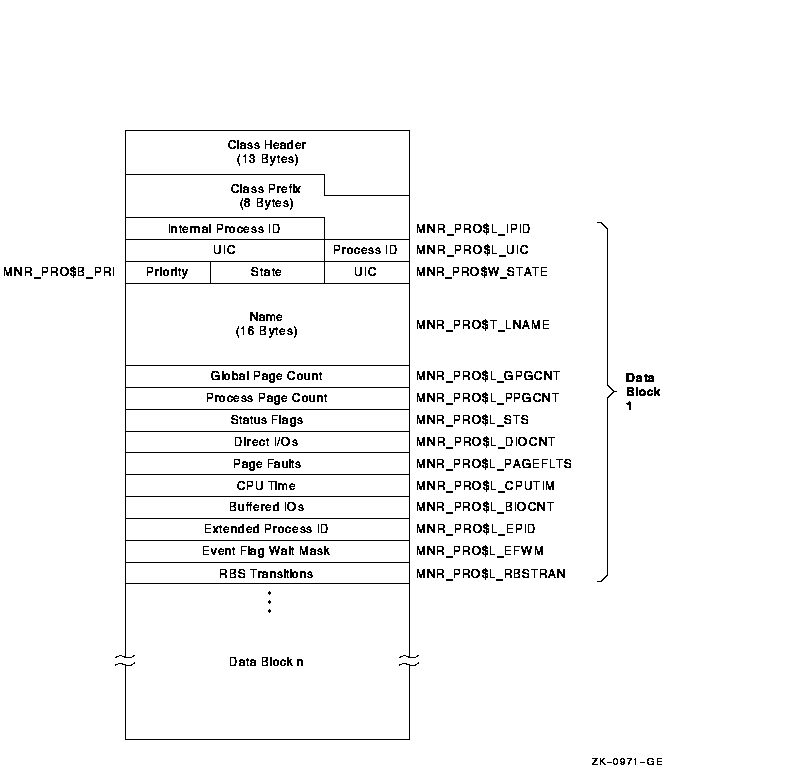
The following table describes the fields in the data block for the PROCESSES class record:
| Field | Symbolic Offset | Contents |
|---|---|---|
| Internal Process ID | MNR_PRO$L_IPID | Internal process identification (longword,I) |
| UIC | MNR_PRO$L_UIC | User identification code (Group is high-order word; Member is low-order word) (longword,I) |
| State | MNR_PRO$W_STATE | Current scheduling state code (word,I) |
| Priority | MNR_PRO$B_PRI | Current software priority (complement of 31) (byte,I) |
| Name | MNR_PRO$T_LNAME | Process name (counted ASCII string) (16 bytes,I) |
| Global Page Count | MNR_PRO$L_GPGCNT | Current global page count (longword,L) |
| Process Page Count | MNR_PRO$L_PPGCNT | Current process page count (longword,L) |
| Status Flags | MNR_PRO$L_STS | Software process status flags (PCB$V_RES bit clear implies swapped out) (longword,I) |
| Direct I/Os | MNR_PRO$L_DIOCNT | Direct I/O count (0 if swapped out) (longword,C) |
| Page Faults | MNR_PRO$L_PAGEFLTS | Page fault count (0 if swapped out) (longword,C) |
| CPU Time | MNR_PRO$L_CPUTIM | Accumulated CPU time, in 10 ms ticks (0 if swapped out) (longword,C) |
| Buffered I/Os | MNR_PRO$L_BIOCNT | Buffered I/O count (0 if swapped out) (longword,C) |
| Extended Process ID | MNR_PRO$L_EPID | Extended process identification (longword,I) |
| Event Flag Weight Mask | MNR_PRO$L_EFWM | Event flag wait mask (used for MWAITs) (longword, I) |
| RBS Transitions | MNR_PRO$L_RBSTRAN | Real balance slot transitions (longword, C) |
The RLOCK class record contains data that is useful for monitoring the dynamic lock remastering statistics of a node. The RLOCK class record has a record type of 27 and a size of 41 bytes.
Figure H-20 illustrates the format of the RLOCK class record.
Figure H-20 RLOCK Class Record Format
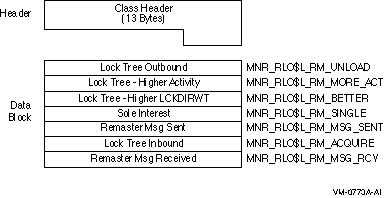
The following table describes the fields in the data block for the RLOCK class record:
| Field | Symbolic Offset | Contents |
|---|---|---|
| Lock Tree Outbound | MNR_RLO$L_RM_UNLOAD | Count of lock trees that are moved from this node. |
| Lock Tree-Higher Activity | MNR_RLO$L_RM_MORE_ACT | Count of trees that are moved due to higher locking activity on another node in the cluster. |
| Lock Tree-Higher LCKDIRWT | MNR_RLO$L_RM_BETTER | Count of trees that are moved to a node with a higher value of the system parameter LCKDIRWT. |
| Sole Interest | MNR_RLO$L_RM_SINGLE | Count of trees that are moved to another node because that node is the only one with locks remaining on the tree. |
| Remaster Msg Sent | MNR_RLO$L_RM_MSG_SENT | Count of remaster messages sent from this node. |
| Lock Tree Inbound | MNR_RLO$L_RM_ACQUIRE | Count of trees that are moved to this node. |
| Remaster Msg Received | MNR_RLO$L_RM_MSG_RCV | Count of remaster messages received on this node. |
The RMS class record contains data describing Record Management Services for specified files. The RMS class record has a record type of 20. Use the following formula to calculate the record size (the formula calculates the size by adding the size of the class header, the class prefix, and the data blocks contained in the record):
13 + 8 + (273 * MNR_CMP$L_ELTCT) |
Figure H-21 illustrates the format of the RMS class record.
Figure H-21 RMS Class Record Format
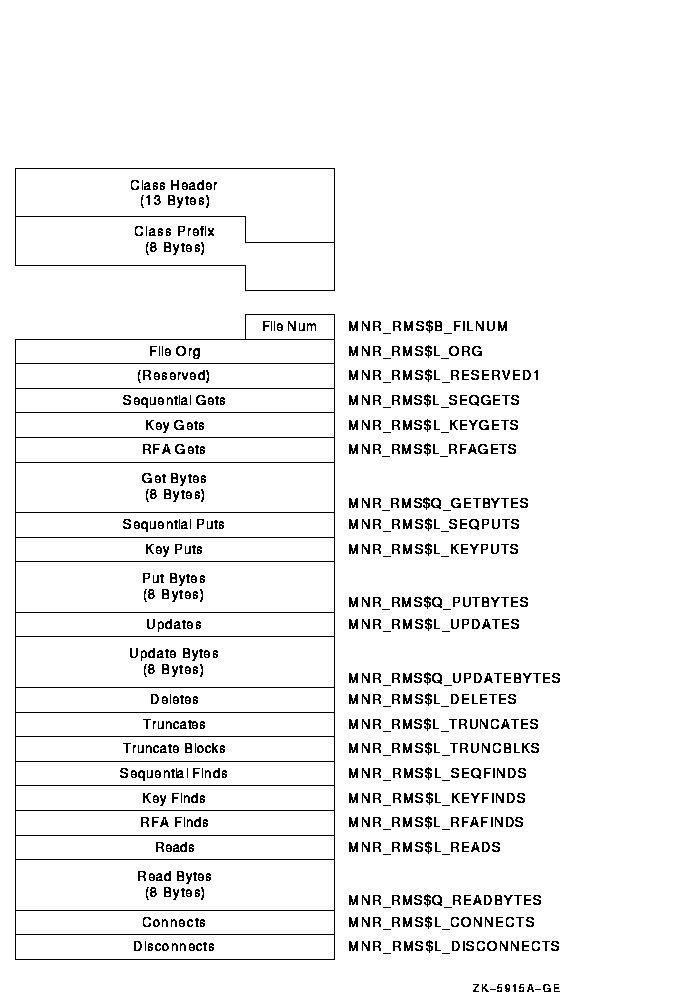
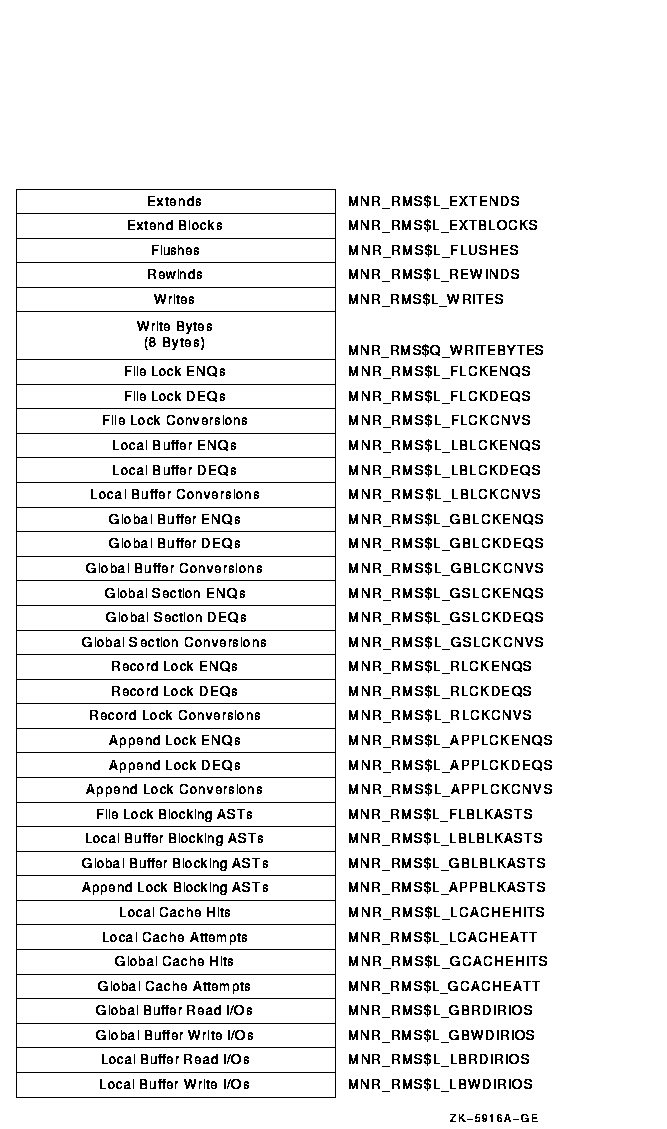
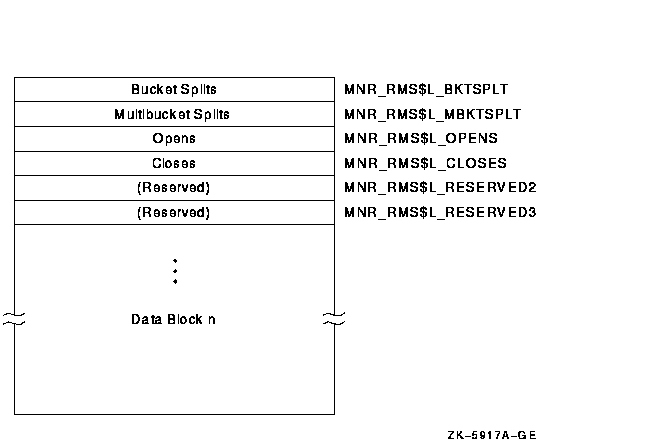
The following table describes the fields in the data block for the RMS class record:
| Field | Symbolic Offset | Contents |
|---|---|---|
| File Number (Num) | MNR_RMS$B_FILNUM | Sequential number of the file (byte,I) |
| File Organization | MNR_RMS$L_ORG | Organization of the file (longword,I) |
| Reserved | MNR_RMS$L_RESERVED1 | Reserved (longword) |
| Sequential GETs | MNR_RMS$L_SEQGETS | Count of sequential $GETs to the file (longword,C) |
| Key GETs | MNR_RMS$L_KEYGETS | Count of keyed $GETs to the file (longword,C) |
| RFA GETs | MNR_RMS$L_RFAGETS | Count of $GETs by record-file-address to the file (longword,C) |
| GET Bytes | MNR_RMS$Q_GETBYTES | Total number of bytes required for all $GETs issued (quadword,C) |
| Sequential PUTs | MNR_RMS$L_SEQPUTS | Count of sequential $PUTs to the file (longword,C) |
| Key PUTs | MNR_RMS$L_KEYPUTS | Count of keyed $PUTs to the file (longword,C) |
| PUT Bytes | MNR_RMS$Q_PUTBYTES | Total number of bytes required for all $PUTs issued (quadword,C) |
| UPDATEs | MNR_RMS$L_UPDATES | Count of $UPDATEs to the file (longword,C) |
| UPDATE Bytes | MNR_RMS$Q_UPDATEBYTES | Total number of bytes required for all $UPDATEs issued (quadword,C) |
| DELETEs | MNR_RMS$L_DELETES | Count of $DELETEs to the file (longword,C) |
| TRUNCATEs | MNR_RMS$L_TRUNCATES | Count of $TRUNCATEs to the file (longword,C) |
| TRUNCATE Blocks | MNR_RMS$L_TRUNCBLKS | Total blocks required for all $TRUNCATEs issued (longword,C) |
| Sequential FINDs | MNR_RMS$L_SEQFINDS | Count of sequential $FINDs to the file (longword,C) |
| Key FINDs | MNR_RMS$L_KEYFINDS | Count of keyed $FINDs to the file (longword,C) |
| RFA FINDs | MNR_RMS$L_RFAFINDS | Count of $FINDs by record-file-address to the file (longword,C) |
| READs | MNR_RMS$L_READS | Count of $READs to the file (longword,C) |
| READ Bytes | MNR_RMS$Q_READBYTES | Total bytes required for all $READs to the file (quadword,C) |
| CONNECTs | MNR_RMS$L_CONNECTS | Count of $CONNECTs to the file (longword,C) |
| DISCONNECTs | MNR_RMS$L_DISCONNECTS | Count of $DISCONNECTs to the file (longword,C) |
| EXTENDs | MNR_RMS$L_EXTENDS | Count of $EXTENDs to the file (longword,C) |
| EXTEND Blocks | MNR_RMS$L_EXTBLOCKS | Total blocks required for all EXTENDs to the file (longword,C) |
| FLUSHes | MNR_RMS$L_FLUSHES | Count of $FLUSHes to the file (longword,C) |
| REWINDs | MNR_RMS$L_REWINDS | Count of $REWINDs to the file (longword,C) |
| WRITES | MNR_RMS$L_WRITES | Count of $WRITES to the file (longword,C) |
| WRITE Bytes | MNR_RMS$Q_WRITEBYTES | Total bytes required for all $WRITEs issued (quadword,C) |
| File Lock ENQs | MNR_RMS$L_FLCKENQS | Count of file lock ENQs to the file (longword,C) |
| File Lock DEQs | MNR_RMS$L_FLCKDEQS | Count of file lock DEQs to the file (longword,C) |
| File Lock Conversions | MNR_RMS$L_FLCKCNVS | Count of file lock conversions for the file (longword,C) |
| Local Buffer ENQs | MNR_RMS$L_LBLCKENQS | Count of local buffer ENQs to the file (longword,C) |
| Local Buffer DEQs | MNR_RMS$L_LBLCKDEQS | Count of local buffer DEQs to the file (longword,C) |
| Local Buffer Conversions | MNR_RMS$L_LBLCKCNVS | Count of local buffer conversions for the file (longword,C) |
| Global Buffer ENQs | MNR_RMS$L_GBLCKENQS | Count of global buffer ENQs to the file (longword,C) |
| Global Buffer DEQs | MNR_RMS$L_GBLCKDEQS | Count of global buffer DEQs to the file (longword,C) |
| Global Buffer Conversions | MNR_RMS$L_GBLCKCNVS | Count of global buffer conversions for the file (longword,C) |
| Global Section ENQs | MNR_RMS$L_GSLCKENQS | Count of global section ENQs to the file (longword,C) |
| Global Section DEQs | MNR_RMS$L_GSLCKDEQS | Count of global section DEQs to the file (longword,C) |
| Global Section Conversions | MNR_RMS$L_GSLCKCNVS | Count of global section conversions for the file (longword,C) |
| Record Lock ENQs | MNR_RMS$L_RLCKENQS | Count of record lock ENQs to the file (longword,C) |
| Record Lock DEQs | MNR_RMS$L_RLCKDEQS | Count of record lock DEQs to the file (longword,C) |
| Record Lock Conversions | MNR_RMS$L_RLCKCNVS | Count of record lock conversions for the file (longword,C) |
| Append Lock ENQs | MNR_RMS$L_APPLCKENQS | Count of append lock ENQs to the file (longword,C) |
| Append Lock DEQs | MNR_RMS$L_APPLCKDEQS | Count of append lock DEQs to the file (longword,C) |
| Append Lock Conversions | MNR_RMS$L_APPLCKCNVS | Count of append lock conversions for the file (longword,C) |
| File Lock Blocking ASTs | MNR_RMS$L_FLBLKASTS | Count of file lock blocking ASTs for the file (longword,C) |
| Local Buffer Blocking ASTs | MNR_RMS$L_LBLBLKASTS | Count of local buffer blocking ASTs for the file (longword,C) |
| Global Buffer Blocking ASTs | MNR_RMS$L_GBLBLKASTS | Count of global buffer blocking ASTs for the file (longword,C) |
| Append Lock Blocking ASTs | MNR_RMS$L_APPBLKASTS | Count of apppend lock blocking ASTs for the file (longword,C) |
| Local Cache Hits | MNR_RMS$L_LCACHEHITS | Count of local cache hits for the file (longword,C) |
| Local Cache Attempts | MNR_RMS$L_LCACHEATT | Count of local cache attempts for the file (longword,C) |
| Global Cache Hits | MNR_RMS$L_GCACHEHITS | Count of global cache hits for the file (longword,C) |
| Global Cache Attempts | MNR_RMS$L_GCACHEATT | Count of global cache attempts for the file (longword,C) |
| Global Buffer Read I/Os | MNR_RMS$L_GBRDIRIOS | Count of global buffer read I/Os for the file (longword,C) |
| Global Buffer Write I/Os | MNR_RMS$L_GBWDIRIOS | Count of global buffer write I/Os for the file (longword,C) |
| Local Buffer Read I/Os | MNR_RMS$L_LBRDIRIOS | Count of local buffer read I/Os for the file (longword,C) |
| Local Buffer Write I/Os | MNR_RMS$L_LBWDIRIOS | Count of local buffer write I/Os for the file (longword,C) |
| Bucket Splits | MNR_RMS$L_BKTSPLT | Count of bucket splits for the file (longword,C) |
| Multibucket Splits | MNR_RMS$L_MBKTSPLT | Count of multibucket splits for the file (longword,C) |
| Opens | MNR_RMS$L_OPENS | Count of the times the file was opened (longword,C) |
| Closes | MNR_RMS$L_CLOSES | Count of the times the file was closed (longword,C) |
| Reserved | MNR_RMS$L_RESERVED2 | Reserved (longword) |
| Reserved | MNR_RMS$L_RESERVED3 | Reserved (longword) |
The SCS class record contains data describing SCS (System Communications Services) activity for all SCS connections in the system, on a per-node basis. The SCS class record has a record type of 15; its size depends on the number of nodes being monitored. The size, in bytes, is calculated by adding the size of the class header, the class prefix, and the data blocks contained in the record. This is shown in the following formula:
13 + 8 + (56 * the value of MNR_CMP$L_ELTCT) |
Figure H-22 illustrates the format of the SCS class record.
Figure H-22 SCS Class Record Format
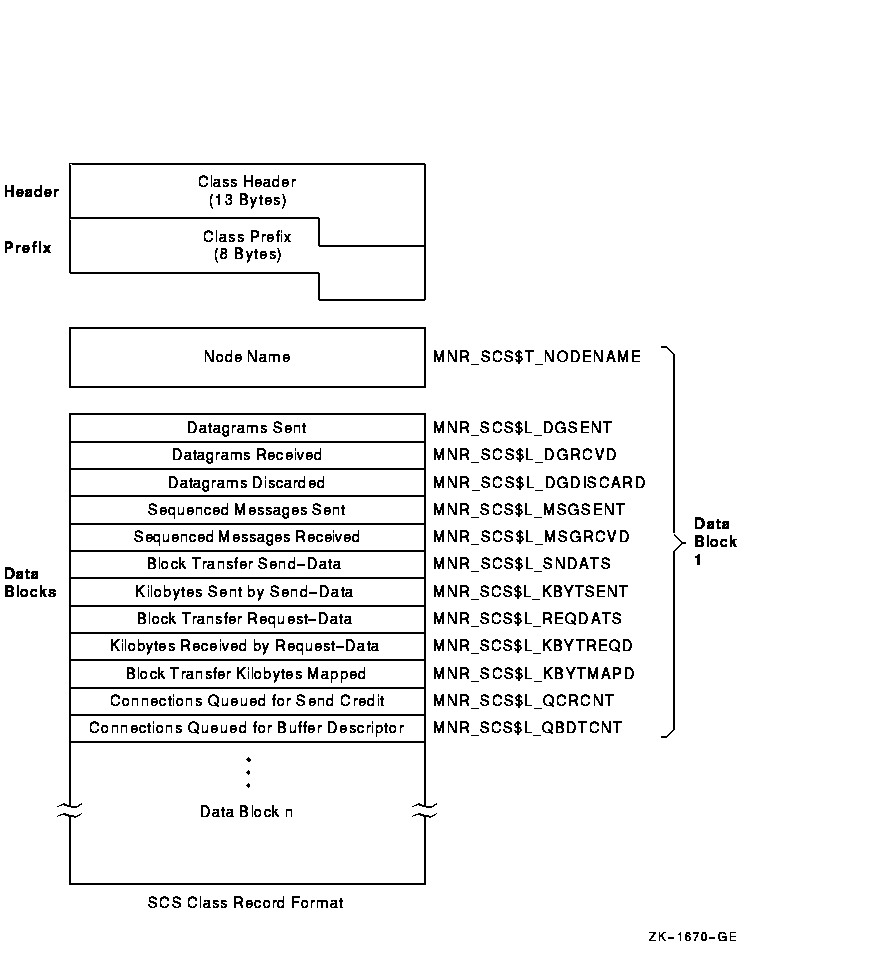
The following table describes the fields in the data block for the SCS class record:
| Field | Symbolic Offset | Contents |
|---|---|---|
| Node Name | MNR_SCS$T_NODENAME | Name of remote cluster node (counted ASCII string) (8 bytes,I) |
| Datagrams Sent | MNR_SCS$L_DGSENT | Count of datagrams sent to the remote node (longword,C) |
| Datagrams Received | MNR_SCS$L_DGRCVD | Count of datagrams received from the remote node (longword,C) |
| Datagrams Discarded | MNR_SCS$L_DGDISCARD | Count of datagrams discarded by the CI port driver (longword,C) |
| Sequenced Messages Sent | MNR_SCS$L_MSGSENT | Count of sequenced messages sent to the remode node (longword,C) |
| Seqenced Messages Received | MNR_SCS$L_MSGRCVD | Count of sequenced messages received from the remote node (longword,C) |
|
Block Transfer
Send-data commands |
MNR_SCS$L_SNDATS | Count of block transfer send-data commands initiated on the local node, targeted for the remote node (longword,C) |
|
Kilobytes Sent by
Send-data commands |
MNR_SCS$L_KBYTSENT | Count of kilobytes sent as a result of send-data commands (longword,C) |
|
Block Transfer Request-
data commands |
MNR_SCS$L_REQDATS | Count of block transfer request-data commands initiated on the local node, targeted for the remote node (longword,C) |
|
Kilobytes Received by
Request-data commands |
MNR_SCS$L_KBYTREQD | Count of kilobytes received as a result of request-data commands (longword,C) |
|
Block Transfer
Kilobytes Mapped |
MNR_SCS$L_KBYTMAPD | Count of kilobytes mapped for block transfers (longword,C) |
|
Connections Queued For
Send Credit |
MNR_SCS$L_QCRCNT | Count of times connections are queued for send credits (longword,C) |
|
Connections Queued For
Buffer Descriptor |
MNR_SCS$L_QBDTCNT | Count of times connections are queued for buffer descriptors (longword,C) |
The STATES class record contains data describing the number of processes in each of the scheduler states. The STATES class record has a record type of 1 and a size of 69 bytes.
Figure H-23 illustrates the format of the STATES class record.
Figure H-23 STATES Class Record Format
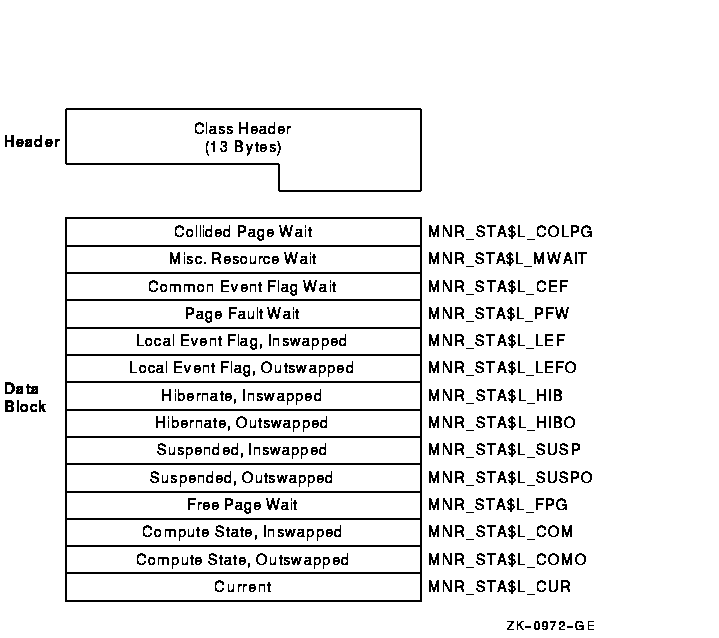
The following table describes the fields in the data block for the STATES class record:
| Field | Symbolic Offset | Contents |
|---|---|---|
|
Collided
Page Wait |
MNR_STA$L_COLPG | Number of processes in collided page wait (longword,L) |
|
Misc
Resource Wait |
MNR_STA$L_MWAIT | Number of processes in miscellaneous resource wait (longword,L) |
|
Common Event
Flag Wait |
MNR_STA$L_CEF | Number of processes in common event flag wait (longword,L) |
|
Page Fault
Wait |
MNR_STA$L_PFW | Number of processes in page fault wait (longword,L) |
|
Local Event Flag,
Inswapped |
MNR_STA$L_LEF | Number of processes in local event flag wait, inswapped (longword,L) |
|
Local Event Flag,
Outswapped |
MNR_STA$L_LEFO | Number of processes in local event flag wait, outswapped (longword,L) |
|
Hibernate,
Inswapped |
MNR_STA$L_HIB | Number of processes in hibernate wait, inswapped (longword,L) |
|
Hibernate,
Outswapped |
MNR_STA$L_HIBO | Number of processes in hibernate wait, outswapped (longword,L) |
|
Suspended,
Inswapped |
MNR_STA$L_SUSP | Number of processes in suspended wait, inswapped (longword,L) |
|
Suspended,
Outswapped |
MNR_STA$L_SUSPO | Number of processes in suspended wait, outswapped (longword,L) |
|
Free Page
Wait |
MNR_STA$L_FPG | Number of processes in free wait (longword,L) |
|
Compute State,
Inswapped |
MNR_STA$L_COM | Number of processes in compute state, inswapped (longword,L) |
|
Compute State,
Outswapped |
MNR_STA$L_COMO | Number of processes in compute state, outswapped (longword,L) |
| Current | MNR_STA$L_CUR | Number of current processes (longword,L) |
The SYSTEM class record contains data describing the overall operation of the three major system components (CPU, memory, I/O). The SYSTEM class record has a record type of 17 and a size of 49 bytes. Note that when the SYSTEM class is recorded, the PROCESSES, STATES, and MODES classes are also recorded, even if not explicitly requested.
Figure H-24 illustrates the format of the SYSTEM class record.
Figure H-24 SYSTEM Class Record Format
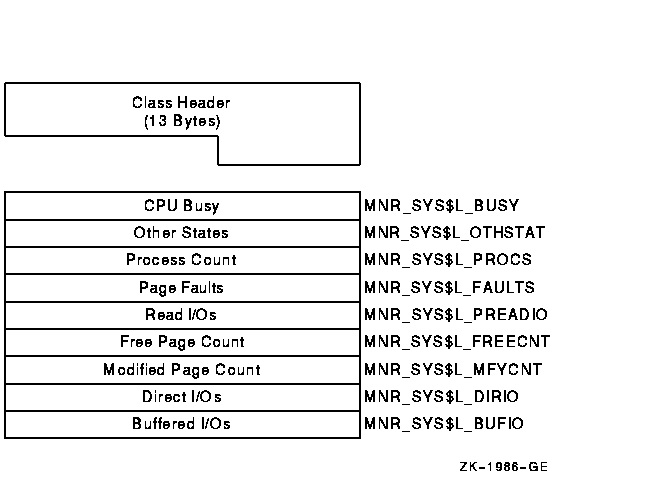
The following table describes the fields in the data block for the SYSTEM class record:
| Field | Symbolic Offset | Contents |
|---|---|---|
| CPU Busy | MNR_SYS$L_BUSY | Count of clock ticks (10-millisecond units) spent in all CPU modes since system was booted (longword,C) |
| Other States | MNR_SYS$L_OTHSTAT | Number of processes in states other than LEF, LEFO, HIB, HIBO, COM, COMO, PFW, and MWAIT (longword,L) |
| Process Count | MNR_SYS$L_PROCS | Number of processes in system (longword,L) |
| Page Faults | MNR_SYS$L_FAULTS | Count of page faults for all working sets (longword,C) |
| Read I/Os | MNR_SYS$L_PREADIO | Count of read I/Os resulting from disk page faults (longword,C) |
| Free Page Count | MNR_SYS$L_FREECNT | Number of pages currently on free-page list (longword,L) |
| Modified Page Count | MNR_SYS$L_MFYCNT | Number of pages currently on modified-page list (longword,L) |
| Direct I/Os | MNR_SYS$L_DIRIO | Count of direct I/O operations (longword,C) |
| Buffered I/Os | MNR_SYS$L_BUFIO | Count of buffered I/O operations (longword,C) |
The TIMER class record contains data that is useful to the OpenVMS executive when monitoring timer queue entries (TQEs). The TIMER class record has a record type of 26 and a size of 29 bytes.
Figure H-25 illustrates the format of the TIMER class record.
Figure H-25 TIMER Class Record Format
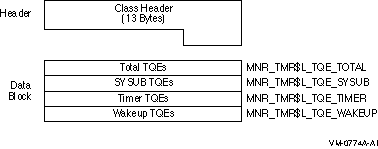
The following table describes the contents of each of the TIMER class record fields:
| Field | Symbolic Offset | Contents |
|---|---|---|
| Total TQEs | MNR_TMR$L_TQE_TOTAL | Count of all TQEs processed per second. |
| SYSUB TQEs | MNR_TMR$L_TQE_SYSUB | Count of SYSUB TQEs processed per second. |
| Timer TQEs | MNR_TMR$L_TQE_TIMER | Count of timer requests made by users per second. |
| Wakeup TQEs | MNR_TMR$L_TQE_WAKEUP | Count of wakeup timer requests made by users per second. |
The TRANSACTION class record contains data describing the operations of the DECdtm transaction manager. The TRANSACTION class has a record type of 22 and a size of 69 bytes. Figure H-26 illustrates the format of the TRANSACTION class record.
Figure H-26 TRANSACTION Class Record Format
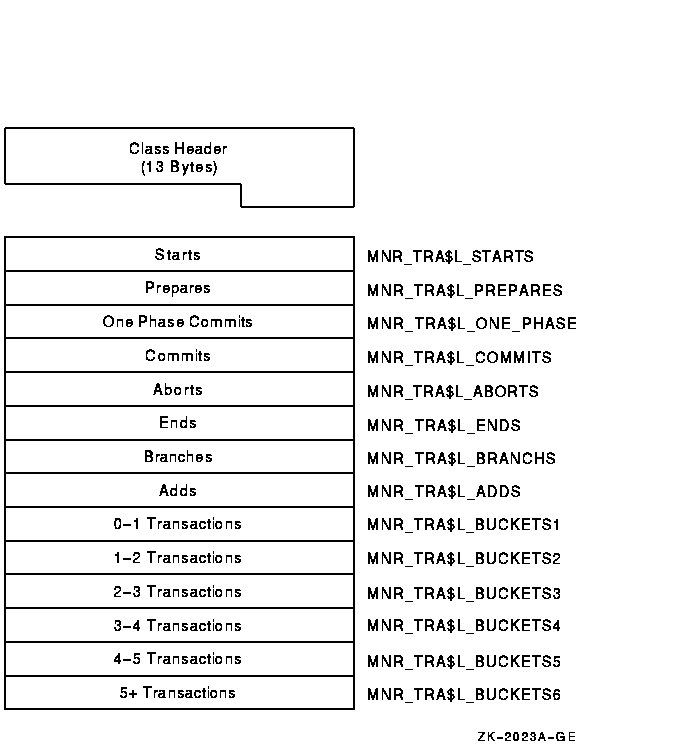
The following table describes the contents of each of the TRANSACTION class record fields:
| Field | Symbolic Offset | Contents |
|---|---|---|
| Starts | MNR_TRA$L_STARTS | Count of transactions started. The number of times that calls on the local node to $START_TRANS have completed successfully (longword, C). |
| Prepares | MNR_TRA$L_PREPARES | Count of transactions that have been prepared (longword, C). |
| One Phase Commits | MNR_TRA$L_ONE_PHASE | Count of one-phase commit events initiated (longword, C). |
| Commits | MNR_TRA$L_COMMITS | Count of transactions committed. This is the combined total of one-phase and two-phase commits (longword, C). |
| Aborts | MNR_TRA$L_ABORTS | Count of transactions aborted. Combined total of planned and unplanned aborts (longword, C). |
| Ends | MNR_TRA$L_ENDS | Count of transactions ended. The number of times that calls on the local node to $END_TRANS have completed successfully (longword, C). |
| Branches | MNR_TRA$L_BRANCHS | Count of transaction branches started on the local node (longword, C). |
| Adds | MNR_TRA$L_ADDS | Count of transaction branches added on the local node (longword, C). |
| 0-1 Transactions | MNR_TRA$L_BUCKETS1 | Count of transactions with a duration of less than 1 second (longword, C). |
| 1-2 Transactions | MNR_TRA$L_BUCKETS2 | Count of transactions with a duration of 1 to 2 (1.99) seconds (longword, C). |
| 2-3 Transactions | MNR_TRA$L_BUCKETS3 | Count of transactions with a duration of 2 to 3 seconds (longword, C). |
| 3-4 Transactions | MNR_TRA$L_BUCKETS4 | Count of transactions with a duration of 3 to 4 seconds (longword, C). |
| 4-5 Transactions | MNR_TRA$L_BUCKETS5 | Count of transactions with a duration of 4 to 5 seconds (longword, C). |
| 5+ Transactions | MNR_TRA$L_BUCKETS6 | Count of transactions with a duration greater than 5 seconds (longword, C). |
H.4.2.20 VBS Class Record (VAX Only)
On VAX systems, the VBS class record contains statistics on the
operation of the virtual balance slot (VBS) mechanism. The VBS class
record has a record type of 24 and a size of 21 bytes.
Figure H-27 illustrates the format of a VBS class record.
Figure H-27 VBS Class Record Format (VAX Only)
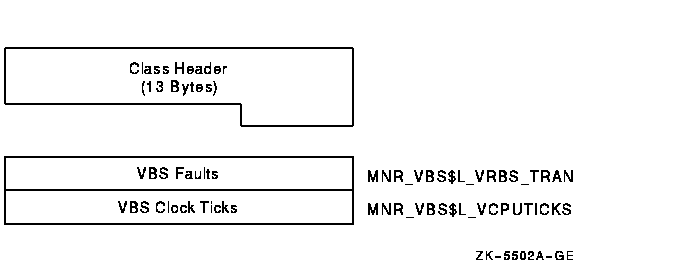
The following table describes the fields in the data block for the VBS class record:
| Field | Symbolic Offset | Contents |
|---|---|---|
| VBS Faults | MNR_VBS$L_VRBS_TRAN | Count of faults from virtual balance slots to real balance slots (longword, C) |
| VBS Clock Ticks | MNR_VBS$L_VCPUTICKS | Count of virtual balance slot clock ticks (10-millisecond units) (longword, C) |
H.4.2.21 VECTOR Class Record
The VECTOR class record contains data describing the time during which
vector consumers have been scheduled on a vector-present processor. Its
record type number is 23. A VECTOR class record is of variable length
and depends on the number of active processors in the system. Assuming
all processors are active, MONITOR calculates the size of the record by
adding the size of the class header, the class prefix, and the data
blocks contained in the record. This is shown in the following formula:
13 + 8 + (5 * MNR_SYI$B_VPCPUS) |
Figure H-28 illustrates the format of the VECTOR class record.
Figure H-28 VECTOR Class Record Format
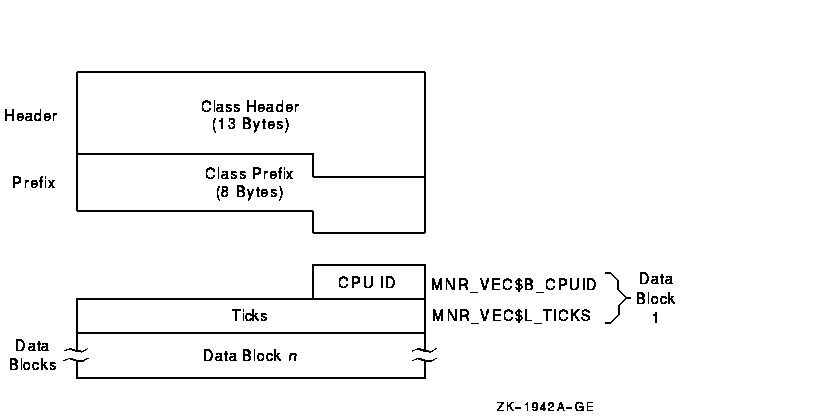
The following table describes the contents of each of the VECTOR class record fields:
| Field | Symbolic Offset | Contents |
|---|---|---|
| CPU ID | MNR_VEC$B_CPUID | Identification of the processor from which the data has been collected (byte, I) |
| Ticks | MNR_VEC$L_TICKS | Number of 10-millisecond clock ticks in which a vector consumer has been scheduled on this processor (longword, C) |
To support the VECTOR class, MONITOR uses the items MNR_SYI$B_VPCPUS and MNR_SYI$L_VPCONF in the system information record. See the table in Section H.3.2 for details on these items.
SHOW CLUSTER provides a predefined keypad that you can use to enter
selected commands. You can add, remove, or reposition windows, scroll
their contents, or change the interval at which the display is updated.
You can also customize the keypad by redefining the default functions
of individual keys.
I.1 Using the Keypad
By default, the numeric keypad is defined as shown in Figure I-1.
Figure I-1 SHOW CLUSTER Default Keypad
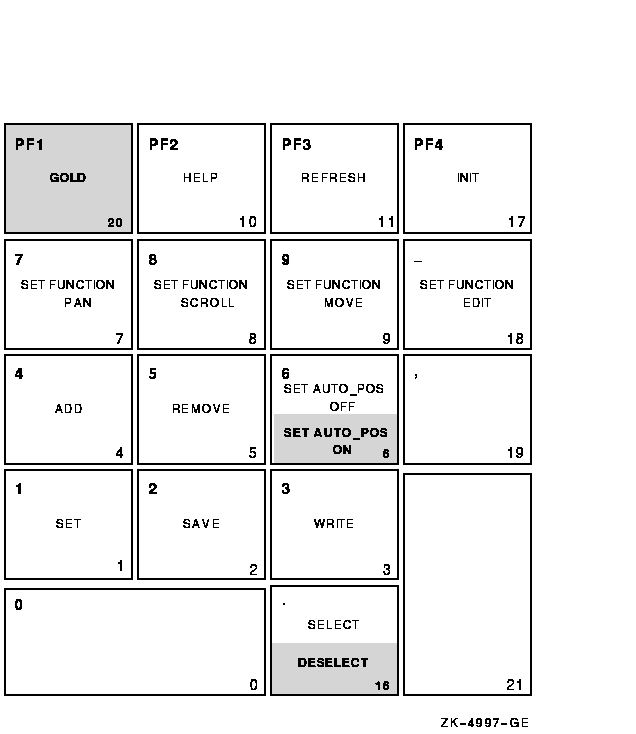
Shading over a keypad command indicates that you must press the GOLD key and then the keypad key.
The following table describes each keypad command you can use with the Show Cluster utility. In this table, KPn refers to the keypad key labeled with the number n. For example, KP2 refers to the keypad key labeled with the number 2. All commands shown on the keypad are also discussed in the Command Section of Chapter 20.
| Command | Key or Key Sequence |
Description |
|---|---|---|
| ADD | KP4 | Modifies the current display by including the field or class that you specify after the ADD command. |
| DESELECT | GOLD-Period | Terminates a window selection. |
| GOLD | PF1 | When pressed before another keypad key, specifies the second key's alternate function (the bottom function on the keypad diagram). |
| HELP | PF2 | Displays information about using the editing keypad. |
| INIT | PF4 | Resets the display using the original default values for field names, class names, and field widths. |
| REFRESH | PF3 | Refreshes the screen display. Clears and redraws the screen, deleting any extraneous characters or messages that might have appeared on the screen but are not part of the SHOW CLUSTER display. (Performs the same function as Ctrl/W.) |
| REMOVE | KP5 | Modifies the current display by removing the field or class that you specify after the REMOVE command. |
| SAVE | KP2 | Allows you to save the current display to a startup initialization file or a command procedure that you can then use to restore the display at a later time. |
| SELECT | Period | Designates which window to scroll or move. |
| SET | KP1 | Changes any of several options including the number of columns in the display, the number of seconds between updates, the functions of the arrow keys, the auto positioning of windows, and the characteristics of a particular field. |
| SET AUTO_POS OFF | KP6 | Disables the automatic positioning of windows on the screen. |
| SET AUTO_POS ON | GOLD-KP6 | Enables the Show Cluster utility to automatically position windows on the screen. This is the default setting. |
|
SET FUNCTION
EDIT |
Hyphen | Redefines the arrow keys to restore line-mode editing. |
|
SET FUNCTION
MOVE |
KP9 | Redefines the arrow keys to move a selected window to a specified position on the display screen. For example, the UP, DOWN, RIGHT, and LEFT arrow keys are redefined as MOVE UP 1, MOVE DOWN 1, MOVE RIGHT 1, and MOVE LEFT 1, respectively. |
|
SET FUNCTION
PAN |
KP7 | Redefines the arrow keys to rotate the display. For example, the UP, DOWN, RIGHT, and LEFT arrow keys are redefined as PAN UP 1, PAN DOWN 1, PAN RIGHT 1, and PAN LEFT 1, respectively. |
|
SET FUNCTION
SCROLL |
KP8 | Resets the arrow keys to scroll the screen display. For example, if you press the SET FUNCTION SCROLL key, the UP, DOWN, RIGHT, and LEFT arrow keys are redefined as SCROLL UP 1, SCROLL DOWN 1, SCROLL RIGHT 1, and SCROLL LEFT 1, respectively. |
| WRITE | KP3 | Outputs the current display to either a file name that you specify, or to the default output file name SHOW_CLUSTER.LIS. |
Use the DEFINE/KEY command to change the definition of a key. See the
DEFINE/KEY command in the Command Section of Chapter 20 for more
information.
I.3 Redefining the Arrow Keys
By default, the SHOW CLUSTER arrow keys are set to the EDIT function. This means that you can perform command line editing at the command prompt that is similar to DCL line-mode editing. For example, the left arrow key moves the cursor to the left, or the up arrow key recalls the previous command. See the OpenVMS User's Manual for information about DCL line-mode editing.
The SET FUNCTION keys, shown in the second row of the keypad, redefine the arrow keys to perform a specified function. You can reset the arrow keys from EDIT to PAN, SCROLL, or MOVE with the SET FUNCTION command. For example, if you press the SET FUNCTION SCROLL key, the up, down, right, and left arrow keys are redefined as SCROLL UP 1, SCROLL DOWN 1, SCROLL RIGHT 1, and SCROLL LEFT 1, respectively. (See the Command Section of Chapter 20 for information about specific commands.)
If you set the function to PAN, SCROLL, or MOVE, the arrow keys are no longer defined to perform DCL line-mode editing. Only one function can be enabled at a time. To restore line-mode editing once it has been changed to another function, enter the command SET FUNCTION EDIT. |
This appendix describes OpenVMS system parameters.
HP recommends that you use AUTOGEN to modify system parameters. In special cases, however, you can use a conversational boot to modify a parameter value temporarily. To change a parameter value permanently, you must edit MODPARAMS.DAT and run AUTOGEN. For instructions, see the HP OpenVMS System Manager's Manual. |
System parameters can be grouped into categories, as shown in Section J.1.1. Also, each parameter can have one or more attributes, listed in Section J.1.1. Each parameter also has a value.
The parameters in this appendix are listed alphabetically along with
their attributes.
J.1.1 Parameter Categories and Attributes
The system parameters can be divided into the following categories (see also Table J-1):
| Category | Description |
|---|---|
| ACP | Parameters associated with file system caches and Files-11 ancillary control processes (ACPs). |
| CLUSTER | Parameters that affect OpenVMS Cluster operation. |
| JOB | Job control parameters. |
| LGI | Login security parameters. |
| PQL | Parameters associated with process creation limits and quotas. |
| RMS | Parameters associated with OpenVMS Record Management Services (RMS). |
| SCS | Parameters that control System Communications Services (SCS) and port driver operation. The parameters that affect SCS operation have the prefix SCS. The parameters that affect the CI780/CI750 port driver have the prefix PA. |
| SPECIAL | Special parameters used by HP. These parameters should only be changed if recommended by HP personnel, or if they are clearly stated to change in the installation guide or release notes of an HP-supplied layered product. |
| SYS | Parameters that affect overall system operation. |
| TTY | Parameters associated with terminal behavior. |
The user can also define four parameters: USERD1, USERD2, USER3, and USER4. USERD1 and USERD2 are dynamic.
Parameters can have one or more of the following attributes:
| Attribute | Description |
|---|---|
| AUTOGEN | AUTOGEN calculates and modifies values. |
| DYNAMIC | Active values can be modified. |
| FEEDBACK | FEEDBACK information available for AUTOGEN calculations. |
| GEN | Affects the creation and initialization of data structures at bootstrap time. |
| MAJOR | Most likely to require modification. |
Table J-1 lists system parameters according to category. Footnotes indicate dynamic and system-specific parameters.
| ACP Parameters | ||
|---|---|---|
| ACP_BASEPRIO 1 | ACP_DATACHECK 1 | ACP_DINDXCACHE 1 |
| ACP_DIRCACHE 1 | ACP_EXTCACHE 1 | ACP_EXTLIMIT 1 |
| ACP_FIDCACHE 1 | ACP_HDRCACHE 1 | ACP_MAPCACHE 1 |
| ACP_MAXREAD 1 | ACP_MULTIPLE 1 | ACP_QUOCACHE 1 |
| ACP_REBLDSYSD | ACP_SHARE 1 | ACP_SWAPFLGS 1 |
| ACP_SYSACC 1 | ACP_WINDOW 1 | ACP_WORKSET 1 |
| ACP_WRITEBACK 1 | ACP_XQP_RES 1 | |
| CLUSTER Parameters | ||
| ALLOCLASS | +CHECK_CLUSTER | CLUSTER_CREDITS |
| CWCREPRC_ENABLE | DISK_QUORUM 1 | ++DR_UNIT_BASE |
| EXPECTED_VOTES | LOCKDIRWT | MPW_WRTCLUSTER |
| MSCP_BUFFER | MSCP_CMD_TMO | MSCP_CREDITS |
| MSCP_LOAD | MSCP_SERVE_ALL | NISCS_CONV_BOOT |
| NISCS_LOAD_PEA0 | NISCS_MAX_PKTSZ | NISCS_PORT_SERV |
| QDSKINTERVAL | QDSKSVOTES | RECNXINTERVAL 1 |
| TAPE_ALLOCLASS | TMSCP_LOAD | TMSCP_SERVE_ALL |
| VAXCLUSTER | VOTES | |
| JOB Parameters | ||
| DEFPRI 1 | DEFQUEPRI 1 | IJOBLIM 1 |
| MAXQUEPRI 1 | NJOBLIM 1 | RJOBLIM 1 |
| LGI Parameters | ||
| LGI_BRK_DISUSER 1 | LGI_BRK_LIM 1 | LGI_BRK_TERM 1 |
| LGI_BRK_TMO 1 | LGI_CALLOUTS 1 | LGI_HID_TIM 1 |
| LGI_PWD_TMO 1 | LGI_RETRY_LIM 1 | LGI_RETRY_TMO 1 |
| MULTIPROCESSING Parameters | ||
| ++IO_PREFER_CPUS | MULTIPROCESSING | SMP_CPUS |
| SMP_LNGSPINWAIT | SMP_SANITY_CNT | SMP_SPINWAIT |
| PQL Parameters | ||
| PQL_DASTLM 1 | PQL_DBIOLM 1 | PQL_DBYTLM 1 |
| PQL_DCPULM 1 | PQL_DDIOLM 1 | PQL_DENQLM 1 |
| PQL_DFILLM 1 | PQL_DJTQUOTA | PQL_DPGFLQUOTA 1 |
| PQL_DPRCLM 1 | PQL_DTQELM 1 | PQL_DWSDEFAULT |
| PQL_DWSEXTENT 1 | PQL_DWSQUOTA 1 | PQL_MASTLM 1 |
| PQL_MBIOLM 1 | PQL_MBYTLM 1 | PQL_MCPULM 1 |
| PQL_MDIOLM 1 | PQL_MENQLM 1 | PQL_MFILLM 1 |
| PQL_MJTQUOTA 1 | PQL_MPGFLQUOTA 1 | PQL_MPRCLM 1 |
| PQL_MTQELM 1 | PQL_MWSDEFAULT | PQL_MWSEXTENT 1 |
| PQL_MWSQUOTA 1 | ||
| RMS Parameters | ||
| RMS_CONPOLICY | RMS_DFMBC 1 | RMS_DFMBFIDX 1 |
| RMS_DFMBFREL 1 | RMS_DFMBFSDK 1 | RMS_DFMBFSMT 1 |
| RMS_DFMBFSUR 1 | RMS_DFNBC 1 | RMS_EXTEND_SIZE 1 |
| RMS_FILEPROT | RMS_HEURISTIC | RMS_PROLOGUE 1 |
| ++RMS_SEQFILE_WBH 1 | ||
| SCS Parameters | ||
| PAMAXPORT 1 | PANOPOLL 1 | PANUMPOLL 1 |
| PAPOLLINTERVAL 1 | PAPOOLINTERVAL 1 | PASANITY 1 |
| PASTDGBUF | PASTIMOUT 1 | PRCPOLINTERVAL 1 |
| SCSBUFFCNT | SCSCONNCNT | SCSFLOWCUSH 1 |
| SCSMAXDG | SCSMAXMSG | SCSNODE |
| SCSRESPCNT | SCSSYSTEMID | SCSSYSTEMIDH |
| ++SMCI_FLAGS 1 | ++SMCI_PORTS | TIMVCFAIL 1 |
| UDABURSTRATE | ||
| Special Parameters | ||
| AFFINITY_SKIP | AFFINITY_TIME | BREAKPOINTS |
| CHANNELCNT | +CLOCK_INTERVAL | CONCEAL_DEVICES |
| CRD_CONTROL | CTLIMGLIM | CTLPAGES |
| DISABLE_UPCALLS 1 | +DLCKEXTRASTK | DNVOSI1 |
| EXUSRSTK | ++FAST_PATH | ++FAST_PATH_PORTS |
| IMGIOCNT | IOTA | JOBCTLD |
| LOAD_SYS_IMAGES | LOCKRETRY | MAXCLASSPRI 1 |
| ++MC_SERVICES_P0-9 | MINCLASSPRI 1 | MPW_PRIO |
| NOAUTOCONFIG 1 | NOCLUSTER | NOPGFLSWP |
| PAGTBLPFC | PE* | ++PFN_COLOR_COUNT |
| ++PHYSICAL_MEMORY | +PHYSICALPAGES | PIOPAGES 1 |
| PIXSCAN 1 | POOLCHECK 1 | POOLPAGING |
| PRIORITY_OFFSET | +PSEUDOLOA | PU_OPTIONS |
| +QBUS_MULT_INTR | RESALLOC | RSRVPAGCNT |
| S0_PAGING | SA_APP | +SBIERRENABLE |
| ++SCH_CTLFLAGS 1 | +SCSI_NOAUTO 1 | ++SCSICLUSTER_P[1-4] |
| SMP_CPUSH | SMP_TICK_CNT | SSINHIBIT |
| +SWPALLOCINC | SWPFAIL | SWPRATE |
| SWP_PRIO | SYSPFC | TBSKIPWSL |
| TIME_CONTROL 1 | TTY_DEFPORT | +VBN_CACHE_S |
| +VBSS_ENABLE | +VBSS_ENABLE2 | ++VCC_FLAGS |
| ++VCC_MAXSIZE | +VCC_MINSIZE | +VCC_PTES |
| VMS | WPRE_SIZE 1 | WPTTE_SIZE 1 |
| WRITABLESYS | WRITESYSPARAMS 1 | XQPCTL2 |
| XQPCTLD1 | ||
| SYS Parameters | ||
| ++ARB_SUPPORT 1 | AUTO_DLIGHT_SAV | AWSMIN 1 |
| AWSTIME 1 | BALSETCNT | BORROWLIM 1 |
| BUGCHECKFATAL 1 | BUGREBOOT 1 | CLASS_PROT 1 |
| CLISYMTBL 1 | ++CRDENABLE | ++DBGTK_SCRATCH |
| DCL_CTLFLAGS | DEADLOCK_WAIT 1 | DEFMBXBUFQUO 1 |
| DEFMBXMXMSG 1 | DELPRC_EXIT 1 | ++DEVICE_NAMING |
| DORMANTWAIT 1 | DUMPBUG | DUMPSTYLE 1 |
| ERLBUFFERPAGES | ERRORLOGBUFFERS | EXTRACPU 1 |
| FREEGOAL 1 | FREELIM | ++GALAXY |
| GBLPAGES 1 | GBLPAGFIL 1 | GBLSECTIONS |
| ++GH_EXEC_CODE | ++GH_EXEC_DATA | ++GH_RES_CODE |
| ++GH_RES_DATA | GH_RSRVPGCNT | ++GLX_INST_TMO |
| GLX_SHM_REG | GROWLIM 1 | ++IMGREG_PAGES |
| +INTSTKPAGES 1 | ++KSTACKPAGES | +LAMAPREGS |
| ++LAN_FLAGS 1 | ++LCKMGR_CPUID | ++LCKMGR_MODE |
| LNMPHASHTBL | LNMSHASHTBL | LOAD_PWD_POLICY |
| LOCKIDTBL | LONGWAIT 1 | ++MAXBOBMEM 1 |
| MAXBUF 1 | MAXPROCESSCNT | MAXSYSGROUP 1 |
| MINWSCNT | MMG_CTLFLAGS 1 | ++MPDEV_AFB_INTVL |
| ++MPDEV_ENABLE | ++MPDEV_LCRETRIES | ++MPDEV_POLLER |
| ++MPDEV_REMOTE | MPW_HILIMIT | MPW_IOLIMIT |
| MPW_LOLIMIT | MPW_LOWAITLIMIT 1 | MULTITHREAD |
| ++MVSUPMSG_INTVL 1 | ++MVSUPMSG_NUM 1 | MVTIMEOUT 1 |
| NET_CALLOUTS 1 | NPAGEDYN | ++NPAGERAD |
| NPAGEVIR | ++NPAG_AGGRESSIVE 1 | ++NPAG_BAP_MIN |
| ++NPAG_BAP_MIN_PA | ++NPAG_GENTLE 1 | ++NPAG_INTERVAL 1 |
| ++NPAG_RING_SIZE | PAGEDYN | +PAGFILCNT |
| PFCDEFAULT 1 | PFRATH 1 | PFRATL 1 |
| POWEROFF 1 | PROCSECTCNT | QUANTUM 1 |
| ++RAD_SUPPORT | +REALTIME_SPTS 1 | RESHASHTBL |
| ++S2_SIZE | SAVEDUMP | SECURITY_POLICY |
| SETTIME | SHADOWING | SHADOW_MAX_COPY 1 |
| SHADOW_MAX_UNIT | SHADOW_MBR_TMO 1 | ++SHADOW_REC_DLY 1 |
| ++SHADOW_SITE_ID 1 | SHADOW_SYS_DISK | SHADOW_SYS_TMO |
| SHADOW_SYS_UNIT | SHADOW_SYS_WAIT | +SPTREQ |
| STARTUP_P1-8 | +SWPFILCNT | SWPOUTPGCNT 1 |
| SYSMWCNT | SYSTEM_CHECK | TAILORED |
| TAPE_MVTIMEOUT 1 | TIMEPROMPTWAIT | UAFALTERNATE |
| USERD1 1 | USERD2 1 | USER3 |
| USER4 | ++VCC_MAX_CACHE 1 | ++VCC_MAX_IO_SIZE 1 |
| ++VCC_MAX_LOCKS | ++VCC_READAHEAD 1 | ++VCC_WRITEBEHIND |
| +VECTOR_MARGIN 1 | +VECTOR_PROC | VIRTUALPAGECNT |
| WBM_MSG_INT 1 | WBM_MSG_LOWER 1 | WBM_MSG_UPPER 1 |
| WBM_OPCOM_LVL 1 | WINDOW_SYSTEM 1 | ++WLKSYSDSK |
| WSDEC 1 | WSINC 1 | WSMAX |
| +WS_OPA0 | XFMAXRATE 1 | ++ZERO_LIST_HI 1 |
| TTY Parameters | ||
| TTY_ALTALARM | TTY_ALTYPAHD | TTY_AUTOCHAR 1 |
| TTY_BUF | TTY_CLASSNAME | TTY_DEFCHAR |
| TTY_DEFCHAR2 | TTY_DIALTYPE | TTY_DMASIZE 1 |
| TTY_PARITY | TTY_RSPEED | TTY_SCANDELTA |
| TTY_SILOTIME | TTY_SPEED | TTY_TIMEOUT 1 |
| TTY_TYPAHDSZ | ||
Each parameter has associated default, minimum, and maximum values that define the scope of allowable values. To determine these values, invoke SYSGEN and enter a SHOW [parameter-name] command (with appropriate qualifiers). For example, to display the values for WSMAX, specify SHOW WSMAX; to display the values for the TTY parameters, specify SHOW/TTY. You can also display parameters grouped by attributes. To display DYNAMIC parameters, for example, specify SHOW/DYNAMIC.
Default values for system parameters allow booting on any supported OpenVMS configuration. SYSGEN displays default values under the heading default when you enter the SYSGEN command SHOW [parameter-name] for one of the parameter categories or attributes. Reset the default parameter values with the USE DEFAULT command.
However, to avoid starting all layered products on a system that is not tuned for them, possibly causing the system to become nonoperational, set the STARTUP_P1 system parameter to "MIN."
The computed, installed value referred to in this section is the value
derived by the AUTOGEN command procedure. (See the HP OpenVMS System Manager's Manual.)
J.2 Parameter Descriptions
This section describes system parameters and provides guidelines to help you decide whether you should consider modifying the parameters. The following attributes are indicated for the parameters:
AUTOGEN---A
DYNAMIC---D
FEEDBACK---F
GEN---G
MAJOR---M
In versions of the operating system before Version 4.0, a separate process, the ancillary control process (ACP), performed file operations such as file opens, closes, and window turns. Version 4.0 introduced the XQP (extended QIO procedure), which allows every process on the system to perform these operations. Consequently, many ACP parameters are applicable only when Files-11 On-Disk Structure Level 1 disks are mounted or when an ACP is specifically requested during a mount command. For compatibility reasons, the names of the parameters have not changed. |
This section alphabetically lists and describes the system parameters in all categories.
ACP_BASEPRIO (D)
ACP_BASEPRIO sets the base priority for all ACPs. The DCL command SET PROCESS/PRIORITY can be used to reset the base priorities of individual ACPs. ACP_BASEPRIO is not applicable for XQPs.ACP_DATACHECK (D)
ACP_DATACHECK controls the consistency checks that are performed on internal file system metadata such as file headers.ACP_DATACHECK is a bit mask. The following table shows the bits that are defined currently:
Bit Description 0 Set this bit to perform consistency checks on read operations. When this bit is set, the IO$M_DATACHECK function modifier is automatically set on all subsequent IO$_READLBLK operations that read file system metadata (see the HP OpenVMS I/O User's Reference Manual).
1 Set this bit to perform consistency checks on write operations. When this bit is set, the IO$M_DATACHECK function modifier is automatically set on all subsequent IO$_WRITELBLK operations that read file system metadata (see the HP OpenVMS I/O User's Reference Manual).
2 Set this bit to perform read-after-write consistency checks. This is similar to setting bit 1, except that in this case the file system does the checks, not the lower level device or disk driver.
Note that read-after-write consistency checks are not allowed on deferred writes. Deferred writes are turned off if this bit is set.
3 Reserved for HP use only; must be zero. 4 Reserved for HP use only; must be zero. 5 and 6 These two bits control the checks that are performed on reads and writes of directory blocks. You can select one of four different levels:
To Check That... Select This Level... By Setting Bit 6 to... And Bit 5 to... The block is a valid directory block (reads only) 0 0 0 The block is a valid directory block (reads and writes) 1 0 1 The block is a valid directory block and contains valid entries (reads and writes) 2 1 0 The block is a valid directory block and contains valid entries in correct alphanumeric order (reads and writes) 3 1 1 When you set the SYSTEM_CHECK system parameter to 1, you enable level 3 checking of directory blocks.
Write errors result in BUGCHECK and crash your system; read errors exit with error status SS$_BADDIRECTORY.
7 Reserved for HP use only; must be zero. ACP_DINDXCACHE (A,D,F)
ACP_DINDXCACHE controls the size of the directory index cache and the number of buffers used on a cachewide basis. Also, ACP_DINDXCACHE builds a temporary index into the directory file, thereby reducing search time and directory header lookup operations.ACP_DIRCACHE (A,D,F)
ACP_DIRCACHE sets the number of pages for caching directory blocks. Too small a value causes excessive XQP I/O operations, while too large a value causes excessive physical memory to be consumed by the directory data block cache.ACP_EXTCACHE (D,F)
ACP_EXTCACHE sets the number of entries in the extent cache. Each entry points to one contiguous area of free space on disk. A specification of 0 means no cache. Too small a value causes excessive XQP I/O operations, while too large a value causes excessive physical memory to be consumed by the extent cache.ACP_EXTLIMIT (D)
ACP_EXTLIMIT specifies the maximum amount of free space to which the extent cache can point, expressed in thousandths of the currently available free blocks on the disk. For example, if available free space on the disk is 20,000 blocks, a specification of 10 limits the extent cache to 200 blocks.The computed, installed value is usually adequate. Users with four or more OpenVMS Cluster node systems might want to adjust this parameter.
ACP_FIDCACHE (D,F)
ACP_FIDCACHE sets the number of file identification slots cached. A specification of 1 means no cache. Too small a value causes excessive XQP I/O operations, while too large a value causes excessive physical memory to be consumed by the FID caches.ACP_HDRCACHE (A,D,F)
ACP_HDRCACHE sets the number of pages for caching file header blocks. Too small a value causes excessive XQP I/O operations, while too large a value causes excessive physical memory to be consumed by the file header caches.ACP_MAPCACHE (A,D,F)
ACP_MAPCACHE sets the number of pages for caching index file bitmap blocks. Too small a value causes excessive XQP I/O operations, while too large a value causes excessive physical memory to be consumed by the bitmap cache.ACP_MAXREAD (D)
ACP_MAXREAD sets the maximum number of directory blocks read in one I/O operation.ACP_MULTIPLE (A,D)
ACP_MULTIPLE enables (1) or disables (0) the default creation of a separate disk XQP cache for each volume mounted on a different device type. Prior to Version 4.0, a separate ACP process was created for each device type if this parameter was enabled. Because ACP operations are now handled by the per process XQP, such separate processes are no longer created. In general, having multiple caches is unnecessary. One large cache is more efficient than several small ones. ACP_MULTIPLE can be overridden on an individual-volume basis with the DCL command MOUNT.ACP_QUOCACHE (A,D,F)
ACP_QUOCACHE sets the number of quota file entries cached. A specification of 0 means no cache. Too small a value causes excessive XQP I/O operations, while too large a value causes excessive physical memory to be consumed by the quota caches.ACP_REBLDSYSD
ACP_REBLDSYSD specifies whether the system disk should be rebuilt if it was improperly dismounted with extent caching, file number caching, or disk quota caching enabled. The ACP_REBLDSYSD default value (1) ensures that the system disk is rebuilt. Setting the value to 0 means the disk is not rebuilt.Depending on the amount of caching enabled on the volume before it was dismounted, the rebuild operation may consume a considerable amount of time. Setting the value of ACP_REBLDSYSD to 0 specifies that the disk should be returned to active service immediately. If you set ACP_REBLDSYSD to 0, you can enter the DCL command SET VOLUME/REBUILD at any time to rebuild the disk.
ACP_SHARE (D)
ACP_SHARE enables (0) or disables (1) the creation of a global section for the first ACP used, enabling succeeding ACPs to share its code. This parameter should be set to 0 when ACP_MULTIPLE is on.ACP_SWAPFLGS (A,D)
ACP_SWAPFLGS enables or disables swap through the value of a 4-bit number for the following four classes of ACPs:
Bit Class of ACP 0 Disks mounted by MOUNT/SYSTEM 1 Disks mounted by MOUNT/GROUP 2 Private disks 3 Magnetic tape ACP If the value of the bit is 1, the corresponding class of ACPs can be swapped. The value of decimal 15 (hexadecimal F---all bits on) enables swap for all classes of ACP. A value of decimal 14 disables swap for ACPs for volumes mounted with the /SYSTEM qualifier but leaves swap enabled for all other ACPs. Note that one has only disk ACPs present if they are specifically requested at mount time or if a Files-11 On-Disk Structure Level 1 disk is mounted. In general, only bit 3 is significant because usually no file ACPs exist.
ACP_SYSACC (A,D)
ACP_SYSACC sets the number of directory file control blocks (FCBs) that are cached for disks mounted with the /SYSTEM qualifier. Each directory FCB contains a 16-byte array containing the first letter of the last entry in each block of the directory (or group of blocks if the directory exceeds 16 blocks). Since entries in a directory are alphabetical, the cached FCB provides quick access to a required directory block. This parameter value should be roughly equivalent to the number of directories that are in use concurrently on each system volume. It might be overridden on a per-volume basis with the /ACCESSED qualifier to the DCL command MOUNT. The value should be kept low in systems with small physical memory and little file activity, because the FCBs require a significant amount of space in the nonpaged dynamic pool.Too small a value causes excessive XQP I/O operations, while too large a value causes excessive physical memory to be consumed by the FCB caches.
ACP_WINDOW (D)
ACP_WINDOW sets the default number of window pointers to be allocated in a window for a default file access, for disks mounted with the /SYSTEM qualifier.ACP_WORKSET (D)
ACP_WORKSET sets the default size of a working set for an ACP. A specification of 0 permits the ACP to calculate the size. This value should be nonzero only on small systems where memory is tight. Too small a value causes excessive ACP page, while too large a value causes excessive physical memory to be consumed by the ACP. Note that this parameter has no effect on the per-process XQP.ACP_WRITEBACK (D)
ACP_WRITEBACK is a dynamic system parameter that controls whether deferred writes to file headers are enabled. The default value is 1, which enables deferred writes to file headers. To disable the feature, set ACP_WRITEBACK to 0.This system parameter affects only applications like PATHWORKS that can request deferred writes to file headers. Note that the deferred write feature is not available on Files-11 ODS--1 volumes.
ACP_XQP_RES
ACP_XQP_RES controls whether the XQP is currently in memory. The default value (1) specifies that the XQP is permanently in memory. Change the default only on restricted memory systems with a small number of users and little or no file activity that requires XQP intervention. Such activity includes file opens, closes, directory lookups, and window turns.AFFINITY_SKIP
AFFINITY_SKIP controls the breaking of implicit affinity. The value indicates the number of times a process is skipped before being moved.This special parameter is used by HP and is subject to change. Do not change this parameter unless HP recommends that you do so.
AFFINITY_TIME
AFFINITY_TIME controls the breaking of implicit affinity. The value indicates how long a process remains on the compute queue.This special parameter is used by HP and is subject to change. Do not change this parameter unless HP recommends that you do so.
ALLOCLASS
ALLOCLASS determines the device allocation class for the system. The device allocation class is used to derive a common lock resource name for multiple access paths to the same device.ARB_SUPPORT (D)
(Alpha only) The Access Rights Block (ARB) compatibility option, the ARB_SUPPORT system parameter, is provided specifically to support products that have not yet been updated to use the new per-thread security Persona Security Block (PSB) data structure instead of the ARB. Changing the value of ARB_SUPPORT from 2 or 3 (the default) to any other value can affect the operation of these products.
Note
HP recommends that all Version 7.3-1 systems have the ARB_SUPPORT parameter set to 3 (the default). Do not change the ARB_SUPPORT parameter to any other value until all products dependent on the ARB and associated structures have been modified for the new environment.The following table describes ARB_SUPPORT parameters:
ARB_SUPPORT Parameter Value Behavior ISS$C_ARB_NONE 0 The obsolete kernel data cells are not maintained by the system. Fields are initialized to zero (or set to invalid pointers) at process creation. ISS$C_ARB_CLEAR 1 The obsolete kernel data cells are cleared (or set to invalid pointers) when the code would have set up values for backward compatibility. ISS$C_ARB_READ_ONLY 2 The obsolete cells are updated with corresponding security information stored in the current PSB when a $PERSONA_ASSUME is issued. ISS$C_ARB_FULL 3 (default) Data is moved from the obsolete cells to the currently active PSB on any security-based operation. AUTO_DLIGHT_SAV
AUTO_DLIGHT_SAV is set to either 1 or 0. The default is 0.If AUTO_DLIGHT_SAV is set to 1, OpenVMS automatically makes the change to and from daylight saving time.
AWSMIN (D)
On VAX systems, AWSMIN establishes the lowest number of pages to which a working set limit can be decreased by automatic working set adjustment.On Alpha systems, AWSMIN establishes the lowest number of pagelets to which a working set limit can be decreased by automatic working set adjustment.
AWSTIME (D)
AWSTIME specifies the minimum amount of processor time that must elapse for the system to collect a significant sample of a working set's page fault rate. The time is expressed in units of 10 milliseconds. The default value of 20, for example, is 200 milliseconds.Some application configurations that have a large number of memory-intensive processes may benefit if the value is reduced. The value can be as low as 4.
AWSTIME expiration is checked only at quantum end. Reducing its value and not reducing QUANTUM effectively sets the value of AWSTIME equal to the value of QUANTUM.
BALSETCNT (A,G,M)
BALSETCNT sets the number of balance set slots in the system page table. Each memory-resident working set requires one balance set slot.You can monitor the active system with the DCL command SHOW MEMORY or the MONITOR PROCESSES command of the Monitor utility to determine the actual maximum number of working sets in memory. If this number is significantly lower than the value of BALSETCNT, this parameter value may be lowered. If all balance set slots are being used, raise the value of BALSETCNT.
Never set BALSETCNT to a value higher than 2 less than MAXPROCESSCNT. If physical memory is a significant system constraint, consider lowering this value even further. However, if your system runs with a number of processes nearly equal to MAXPROCESSCNT, lowering BALSETCNT will force swapping to occur, which can affect system performance. Note that virtual balance slots (VBS) can affect the values of BALSETCNT and MAXPROCESSCNT.
BORROWLIM (A,D,M)
BORROWLIM defines the minimum number of pages required on the free-page list before the system permits process growth beyond the working set quota (WSQUOTA) for the process. This parameter should always be greater than FREELIM.This parameter allows a process to grow beyond the value set by the working set quota (WSQUOTA) to the working set quota extent (WSEXTENT) on a system that has a substantial memory on the free-page list. This automatic working set adjustment also depends upon the values of parameters WSINC, PFRATH, and AWSTIME.
Working set growth attempts to alleviate heavy page faulting. To make use of this growth, you must also set the user's WSEXTENT authorization quota to a larger number than the WSQUOTA value.
BREAKPOINTS
If XDELTA is loaded, BREAKPOINTS enables additional built-in calls for XDELTA during the boot sequence. The breakpoints that are enabled may change from release to release of OpenVMS.This special parameter is used by HP and is subject to change. Do not change this parameter unless HP recommends that you do so.
BUGCHECKFATAL (D)
BUGCHECKFATAL enables or disables the conversion of nonfatal bugchecks into fatal bugchecks. The system must be rebooted on a fatal bugcheck. A nonfatal bugcheck places an entry only in the error log and deletes the corresponding process.This parameter should normally be OFF (0); you should set it ON (1) only when the executive is being debugged.
Setting the SYSTEM_CHECK parameter to 1 has the effect of setting BUGCHECKFATAL to ON (1).
BUGREBOOT (D)
BUGREBOOT enables or disables automatic rebooting of the system if a fatal bugcheck occurs. This parameter should normally be on (1); set it off (0) only when the executive is being debugged.CHANNELCNT
CHANNELCNT specifies the number of permanent I/O channels available to the system.This special parameter is used by HP and is subject to change. Do not change this parameter unless HP recommends that you do so.
CHECK_CLUSTER
(VAX only) CHECK_CLUSTER is the VAXCLUSTER parameter sanity check. When CHECK_CLUSTER is set to 1, SYSBOOT outputs a warning message and forces a conversational boot if it detects that the VAXCLUSTER parameter is set to 0.CLASS_PROT (D)
CLASS_PROT performs the nondiscretionary classification checks. CLASS_PROT is also checked by XQP to determine if a classification block should be added to the header of any created files.CLISYMTBL (D)
CLISYMTBL sets the size of the command interpreter symbol table, which controls the number of DCL symbols that can be created.CLOCK_INTERVAL
(VAX only) CLOCK_INTERVAL sets the number of microseconds between the hardware interval timer clock interrupts. It has no effect on processors that have implemented only the subset interval clock registers.This special parameter is used by HP and is subject to change. Do not change this parameter unless HP recommends that you do so.
CLUSTER_CREDITS
CLUSTER_CREDITS specifies the number of per-connection buffers a node allocates to receiving VMS$VAXcluster communications.If the SHOW CLUSTER command displays a high number of credit waits for the VMS$VAXcluster connection, you might consider increasing the value of CLUSTER_CREDITS on the other node. However, in large cluster configurations, setting this value unnecessarily high consumes a large quantity of nonpaged pool. Each receive buffer is at least SCSMAXMSG bytes in size but might be substantially larger depending on the underlying transport.
It is not required for all nodes in the cluster to have the same value for CLUSTER_CREDITS.
The default value is currently 32. Unless a system has very constrained memory available, HP recommends that these values not be increased.
CONCEAL_DEVICES
CONCEAL_DEVICES enables or disables the use of concealed devices. By default, this parameter is set to enable concealed devices (1).This special parameter is used by HP and is subject to change. Do not change this parameter unless HP recommends that you do so.
CRD_CONTROL
This special parameter is used by HP and is subject to change. Do not change this parameter unless HP recommends that you do so.On VAX systems, CRD_CONTROL serves the function of CRDENABLE in earlier releases. On Alpha systems, CRD_CONTROL can be used to expand the function defined by CRDENABLE.
CRD_CONTROL is a bit mask for corrected read data (CRD) soft error control flags. These flags control the use of CRDERROR routines.
On VAX systems, the following bits are defined:
Bit Description 0 Enables CRD processing for all systems. 1 Enables scrubbing (rewriting) of the memory location that induced the CRD. 2 Enables page replacement of the pages that exhibit repeated CRD errors. 3 Forces all memory pages to be included in the PFN database. On systems that contain more than 512 megabytes of memory, all memory is mapped by the PFN database by default. This bit allows the mapping to occur on systems with less than 512 megabytes of memory. Default values are different for VAX and Alpha systems. On VAX systems, the default is 7, which enables CRD processing, scrubbing, and page replacement.
On Alpha systems, the following bits are defined:
Bit Description 0 Enables CRD processing for all systems. 1 Enables scrubbing (rewriting) of the memory location that induced the CRD. 2 Enables page replacement of the pages that exhibit repeated CRD errors. 3 Forces all memory pages to be included in the PFN database. On systems that contain more than 512 megabytes of memory, all memory is mapped by the PFN database by default. This bit allows the mapping to occur on systems with less than 512 megabytes of memory. 4 Enables extended CRD handling, if available. 5 Enables loading of driver and process for handling server management events. Platform-specific code usually sets this bit if the required hardware and firmware support are available. 6 Disables CRD throttling. 16-31 Reserved for platform-specific error-handling control. On Alpha systems, the default setting is 22, which enables scrubbing, page replacement, and extended CRD handling.
CRDENABLE
(Alpha only) CRDENABLE enables or disables detection and logging of memory-corrected read data (ECC) errors. This parameter should normally be set to (1).Beginning with OpenVMS Version 7.2, CRD_CONTROL can expand the function of CRDENABLE. (Refer to CRD_CONTROL.)
CTLIMGLIM
CTLIMGLIM specifies the size of the default image I/O segment; that is channel table and initial buffer pool for image-related file and RMS I/O.This special parameter is used by HP and is subject to change. Do not change this parameter unless HP recommends that you do so.
CTLPAGES (A)
CTLPAGES specifies the size of P1 pool. CTLPAGES is automatically changed only when the process logical name table, DCL symbols, or some layered products require an increase in the size of the P1 pool area.This special parameter is used by HP and is subject to change. Do not change this parameter unless HP recommends that you do so.
CWCREPRC_ENABLE
CWCREPRC_ENABLE controls whether an unprivileged user can create a process on another OpenVMS Cluster node. The default value of 1 allows an unprivileged user to create a detached process with the same UIC on another node. A value of 0 requires that a user have DETACH or CMKRNL privilege to create a process on another node.DBGTK_SCRATCH
(Alpha only) DBGTK_SCRATCH specifies how many pages of memory are allocated for the remote debugger. This memory is allocated only if remote debugging is enabled with the 8000 boot flag. Normally, the default value is adequate, but if the remote debugger issues an error message, you should increase this value. See Writing OpenVMS Alpha Device Drivers in C (Margie Sherlock and Lenny S. Szubowicz, Digital Press, 1996).DCL_CTLFLAGS
DCL_CTLFLAGS is a bitmask used to alter default behavior for certain commands on a systemwide basis. At present, only the low bit of the bitmask is defined. The low bit controls the default process-name assignment for a subprocess created using the SPAWN command or LIB$SPAWN routine.Prior to OpenVMS Version 7.3-1, if no process name was supplied, the system constructed a name by appending _n to the username, where n was the next available non-duplicate integer for any process currently in the system. For example, the first spawned process from user SYSTEM would be called SYSTEM_1, the second, SYSTEM_2, and so on. The next available number was chosen, as soon as a gap was found.
A problem with this technique is that determining the next available number is very expensive in terms of performance, because the mechanism attempts to create the process by incrementing names until one is found that unique. When several subprocesses already exist, the cost of creating the subprocess iteratively becomes even more expensive. When many processes are in the same OpenVMS group, the cost multiplies because process names must be unique throughout the group.
Beginning in OpenVMS Version 7.3-1, the default constructed process name for subprocesses has changed. Instead of incrementally searching for the next unique number, a random number is chosen to append to the username. Therefore, the first processes that are spawned from user SYSTEM might be SYSTEM_154, SYSTEM_42, SYSTEM_87, and so on. This procedure results in a very high probability of finding a unique name on the first try, because it is unlikely that the same number is already in use. This greatly reduces the cost of process creation, and applications that rely on spawned subprocesses might see a dramatic performance improvement due to this change.
However, some applications might rely on the previous method of assigning subprocess names. The DCL_CTLFLAGS parameter is available to allow you to configure the system as necessary.
Bit 0 of DCL_CTLFLAGS selects the behavior for assigning default subprocess names:
- If the bit is clear, the new behavior is used. If you do not specify a process name, the system assigns the username with a random number suffix. This is the default setting.
- If the bit is set, the prior behavior is used. If you do not specify a process name, the system assigns the username with a random number suffix.
DEADLOCK_WAIT (D)
DEADLOCK_WAIT defines the number of seconds that a lock request must wait before the system initiates a deadlock search on behalf of that lock. Setting DEADLOCK_WAIT to 0 disables deadlock checking. Setting DEADLOCK_WAIT to a value greater than 0 but still less than the default setting provides faster detection of deadlocks but requires more CPU usage.DEFMBXBUFQUO (D)
DEFMBXBUFQUO sets the default for the mailbox buffer quota size in bytes when this value is not specified in a Create Mailbox ($CREMBX) system service call.DEFMBXMXMSG (D)
DEFMBXMXMSG sets the default for the mailbox maximum message size in bytes when this value is not specified in a Create Mailbox ($CREMBX) system service call.DEFPRI (D)
DEFPRI sets the base default priority for processes.DEFQUEPRI (D)
DEFQUEPRI establishes the scheduling priority for jobs entered in batch and output (printer, server, and terminal) queues when no explicit scheduling priority is specified by the submitter. The value of this parameter can range from 0 to 255; the default value is 100.The value of DEFQUEPRI should be less than or equal to MAXQUEPRI.
Note
DEFQUEPRI refers to relative queue scheduling priority, not the execution priority of the job.DELPRC_EXIT (D)
DELPRC_EXIT can be used to control $DELPRC system service options that call exit handlers prior to final cleanup and deletion of a process. The following table describes these options:
Option Description 0 Disable the exit handler functionality with $DELPRC. 4 Execute kernel mode exit handlers. 5 (default) Execute exec and more privileged mode exit handlers. 6 Execute supervisor and more privileged mode exit handlers. 7 Execute user and more privileged mode exit handlers.
DEVICE_NAMING
(Alpha only) DEVICE_NAMING is a bit mask indicating whether port allocation classes are used in forming SCSI device names.Following is the bit definition:
Bit Definition 0 If 1, enable new naming. 1 Must be 0. This bit is reserved for use by HP. For more information about port allocation classes, see OpenVMS Cluster Systems.
DISABLE_UPCALLS (D)
DISABLE_UPCALLS is primarily a debugging aid. It allows the system manager to disable threads upcalls of specific types for the entire system. The value is a bit mask, with the bits corresponding to the upcall types. The upcall types are defined in the definition macro $TMCDEF.This special parameter is used by HP and is subject to change. Do not change this parameter unless HP recommends that you do so.
DISK_QUORUM (D)
The DISK_QUORUM parameter is the name of an optional quorum disk in ASCII. ASCII spaces indicate that no quorum disk is being used.DLCKEXTRASTK
(VAX only) DLCKEXTRASTK specifies the amount of extra interrupt stack (in bytes) to leave when doing a deadlock search.This parameter is not used on Alpha systems.
This special parameter is used by HP and is subject to change. Do not change this parameter unless HP recommends that you do so.
DNVOSI1
DNVOSI1 is reserved to DECnet-Plus for OpenVMS. This special parameter is used by HP and is subject to change. Do not change this parameter unless HP recommends that you do so.DORMANTWAIT (D)
DORMANTWAIT specifies, in seconds, the amount of time that can elapse without a significant event before the system treats a low-priority computable process as a DORMANT process for scheduling purposes. (A low-priority process is a non real-time process whose current priority is equal to or less than the value specified by the system parameter DEFPRI [default=4].) After SUSP (suspended) processes, DORMANT processes are the most likely candidates for memory reclamation by the swapper.Increasing the value of DORMANTWAIT can increase the interval that a low priority process blocks a high priority process if that low priority process is holding a lock or resource that the higher priority process is waiting for.
DR_UNIT_BASE (G)
(Alpha only) DR_UNIT_BASE specifies the base value from which unit numbers for DR devices (DIGITAL StorageWorks RAID Array 200 Family logical RAID drives) are counted.DR_UNIT_BASE provides a way for unique RAID device numbers to be generated. DR devices are numbered starting with the value of DR_UNIT_BASE and then counting from there. For example, setting DR_UNIT_BASE to 10 produces device names such as $1$DRA10, $1$DRA11, and so on.
Setting DR_UNIT_BASE to appropriate, nonoverlapping values on all cluster members that share the same (nonzero) allocation class ensures that no two RAID devices are given the same name.
DUMPBUG
DUMPBUG enables (1) or disables (0) the writing of error log buffers and memory contents to SYS$SYSTEM:SYSDUMP.DMP when a fatal bugcheck occurs. This parameter should be off (0) only when the executive is being debugged.DUMPSTYLE (A,D)
DUMPSTYLE specifies the method of writing system dumps.DUMPSTYLE is a 32-bit mask, with the following bits defined. Each bit can be set independently. The value of the system parameter is the sum of the values of the bits that have been set. Remaining or undefined values are reserved for HP use only.
Bit Mask Description 0 00000001 0 = Full dump (SYSGEN default). The entire contents of physical memory are written to the dump file. 1 = Selective dump. The contents of memory are written to the dump file selectively to maximize the usefulness of the dump file while conserving disk space. 1 00000002 0 = Minimal console output. 1 = Full console output (includes stack dump, register contents, and so on). 2 00000004 0 = Dump to system disk. 1 = Dump off system disk (DOSD) to an alternate disk. (Refer to the HP OpenVMS System Manager's Manual for details.) 3 (Alpha only) 1 00000008 0 = Do not compress. 1 = Compress. (See note below.) 4 (Alpha only) 2 00000010 0 = Dump shared memory. 1 = Do not dump shared memory. (See note below.) 5 - 14 Reserved for HP use only. 15 (VAX only) 3 00008000 0 = Disable use of bits 16 - 27. 1 = Enable use of bits 16 - 27. 16 - 27 (VAX only) 2 0FFF0000 Range of DOSD unit numbers. 28 - 31 Reserved for HP use only.
If you plan to enable the Volume Shadowing minimerge feature on an Alpha system disk, be sure to specify DOSD to an alternate disk.
On Alpha systems, you can save space on the system disk and, in the event of a crash, save time recording the system memory, by using the OpenVMS Alpha dump compression feature. Unless you override the default AUTOGEN calculations (by setting DUMPSTYLE in MODPARAMS.DAT), AUTOGEN uses the following algorithm:
|
The mask of 00000006 directs the system to send a full dump, with full console output, off the system disk (to the alternate disk).
For a VAX 7000, a mask of 00098006 directs the system to send a full dump with full console output to the DOSD whose unit number is 9.
On Alpha systems, the mask of 00000009 directs the system to compress a selective dump with minimal console output.
On VAX systems, ERLBUFFERPAGES has a default value of 2 pages and a maximum value of 32 pages.
On Alpha systems, ERLBUFFERPAGES has a default value of 4 pagelets and a maximum value of 32 pagelets.
If you increase ERRORLOGBUFFERS, you must also increase the size of the system dump file.
This special parameter is used by HP and is subject to change. Do not change this parameter unless HP recommends that you do so.
Starting in OpenVMS Version 7.2, FAST_PATH is enabled by default. In Versions 7.0 and 7.1, FAST_PATH was disabled by default.
For additional information, see FAST_PATH_PORTS and IO_PREFER_CPUS.
FAST_PATH_PORTS is a 32-bit mask, with a bit assigned for each Fast Path port driver. The following table describes the bit values:
| Bit Value | Description |
|---|---|
| 1 | Indicates that Fast Path is disabled for ports serviced by the corresponding driver. |
| 0 | Indicates that Fast Path is not disabled for ports serviced by the corresponding driver. |
Beginning in OpenVMS Version 7.3-1, values of specific bit positions are those described in the following table:
| Bit Position | Description |
|---|---|
| 0 | Controls Fast Path for PKQDRIVER (for parallel SCSI). |
| 1 | Controls Fast Path for FGEDRIVER (for Fibre Channel). |
| 2 | Controls Fast Path for PKADRIVER (for Ultra3 SCSI). |
| 3 | Controls Fast Path for PEDRIVER (for LAN). |
| 4 | Controls Fast Path for PKRDRIVER (for SMART Array 5300). |
Currently, the default setting for FAST_PATH_PORTS is 0, which means that Fast Path is enabled for all drivers that appear in the table.
In addition, note the following:
For additional information, see FAST_PATH and IO_PREFER_CPUS. For an explanation of how to set the bits, see the HP OpenVMS I/O User's Reference Manual.
The system writes pages from the modified-page list, swaps out working sets, or reduces the size of the working sets to maintain the minimum count.
While the larger free-page list generally means less page I/O, it also means less space for the balance set, which tends to result in more swap I/O. You can monitor the size of the free-page list, the amount of page, and the amount of swap with the MONITOR IO command of the Monitor utility.
| Value | Description |
|---|---|
| 0 | Never load. Do not participate in a Galaxy sharing set. |
| 1 | Always load. Participate in a Galaxy sharing set. |
The default value is 0. GALAXY is not an AUTOGEN parameter.
Users with CMKRNL privilege can change this parameter on a running system. Increasing the value of this parameter allows the global page table to expand, on demand, up to the maximum size.
The default value is sufficient for the images normally installed as shared in the system startup command procedures. Once the system is running and all global sections are created, you can examine the actual requirements with the /GLOBAL qualifier of the Install utility (INSTALL) and reduce the value of GBLPAGES accordingly. However, do not set the value of this parameter too low, because the page table entries use little permanently resident memory. If you plan to install many user images as shared, or if user programs are likely to create many global sections, you must increase the value of this parameter.
Global page-file sections are created with the Create and Map Section system services ($CREATE_GPFILE, $CRMPSC, and $CRMPSC_GPFILE_64) without an explicit disk file. These sections are used for the RMS global buffers required for shared files. Users of shared files should note that global page-file sections cause both the global page table and the default system page file (PAGEFILE.SYS) to be used. If the value of GBLPAGFIL is too small, $CRMPSC issues an error message when you attempt to create global page-file sections.
You must have scratch global sections if you use RMS global buffers. Each file using global buffers requires, in the system page file, the file's bucket size multiplied by the number of global buffers for that file. If the file's bucket size varies, as with RMS indexed files, use the maximum bucket size. For shared sequential files, use the multiblock count of the first stream to perform the $CONNECT service in place of the file's bucket size.
The default value for this parameter is adequate for most systems. However, if your site uses RMS global buffering to a significant extent, you may need to raise the value of GBLPAGFIL. Use the /GLOBAL qualifier of the Install utility to examine the number of pages consumed by RMS global buffers. The global sections used by RMS for global buffers have the prefix RMS$ followed by 8 hexadecimal digits.
Global buffers are enabled with the DCL command SET FILE/GLOBAL_BUFFERS, which is described in the HP OpenVMS DCL Dictionary.
The default value is sufficient for the images normally installed as shared in the system startup command procedures. Once the system is running and all global sections are created, you can examine the actual requirements with the /GLOBAL qualifier of the Install utility and reduce the value of GBLSECTIONS accordingly. However, the value of this parameter should not be set too low. If you plan to install many user images as shared, or if user programs are likely to create many global sections, you must increase the value of this parameter.
If the value of GBLSECTIONS is too small, you receive a message from the Install utility at system startup time or whenever you install images manually. Note that too large a value for GBLSECTIONS wastes physical memory.
If bit 2 of the LOAD_SYS_IMAGES parameter is set, the image LDR$WRAPUP releases all unused pages in the granularity hint region at the the end of system startup. The unused pages of the resident image granularity hint region are either reserved for future use, or given back to the free memory list.
If bit 2 of the LOAD_SYS_IMAGES parameter is set, the image LDR$WRAPUP releases all unused pages in the granularity hint region at the the end of system startup. The unused pages of the resident image granularity hint region are either reserved for future use, or given back to the free memory list.
GH_RSRVPGCNT specifies the number of pages that LDR$WRAPUP attempts to leave in the resident image code granularity hint region. If the GH_RSRVPGCNT number of pages is larger than the unused pages in the granularity hint region, the region is not expanded to accommodate the number of pages requested.
The default is 20,000 milliseconds (20 seconds).
This special parameter is used by HP and is subject to change. Do not change this parameter unless HP recommends that you do so.
For more information, see the INSTALL section in the HP OpenVMS System Management Utilities Reference Manual.
Use the default value of 6 unless interrupt-stack-not-valid exceptions occur. These may be caused by either an unusually large number of devices or a driver that requires a large amount of stack space.
IO_PREFER_CPUS is a CPU bit mask specifying the CPUs that are allowed to serve as preferred CPUs and that can thus be assigned a Fast Path port. CPUs whose bit is set in the IO_PREFER_CPUS bit mask are enabled for Fast Path port assignment. IO_PREFER_CPUS defaults to -1, which specifies that all CPUs are allowed to be assigned Fast Path ports.
You might want to disable the primary CPU from serving as a preferred CPU by clearing its bit in IO_PREFER_CPUS. This reserves the primary CPU for non-Fast-Path IO operations to use.
Changing the value of IO_PREFER_CPUS causes the FASTPATH_SERVER process to execute the automatic assignment algorithm that spreads Fast Path ports evenly among the new set of usable CPUs.
For additional information, see FAST_PATH and FAST_PATH_PORTS.
This special parameter is used by HP and is subject to change. Do not change this parameter unless HP recommends that you do so.
This special parameter is used by HP and is subject to change. Do not change this parameter unless HP recommends that you do so.
The bit definitions are as follows:
| Bit | Description |
|---|---|
| 0 | The default of zero indicates that ATM devices run in SONET mode. If set to 1, this bit indicates ATM devices run in SDH mode. |
| 1 | If set, this bit enables a subset of the ATM trace and debug messages in the LAN port drivers and support code. |
| 2 | If set, this bit enables all ATM trace and debug messages in the LAN port drivers and support code. |
| 3 1 | If set, this bit runs UNI 3.0 over all ATM adapters. |
| 4 1 | If set, this bit runs UNI 3.1 over all ATM adapters. |
| 5 | If set, disables auto-negotiation over all Gigabit Ethernet Adapters. |
| 6 | If set, enables the use of jumbo frames over all Gigabit Ethernet Adapters. |
If the specified CPU ID is either the primary CPU or a nonexistent CPU, the LCKMGR_SERVER process utilizes the lowest nonprimary CPU. For more information, refer to the LCKMGR_MODE system parameter.
The Dedicated CPU Lock Manager performs all locking operations on a single dedicated CPU. This can improve system performance on large SMP systems with high MP_Synch associated with the lock manager.
If the number of active CPUs is greater than or equal to LCKMGR_MODE, a LCKMGR_SERVER process is created to service locking operations. This process runs at a real-time priority of 63 and is always current.
In addition, if the number of active CPUs should ever be reduced below the required threshold by either a STOP/CPU command or by a CPU reassignment in a Galaxy configuration, the Dedicated CPU Lock Manager automatically turns off within one second, and the LCKMGR_SERVER is placed in a hibernate state. If the number of active CPUs is increased, the LCKMGR_SERVER resumes servicing locking operations.
Specify one of the following:
For more information about use of the Dedicated CPU Lock Manager, see the OpenVMS Performance Management.
The minimum value is 1. The default value is usually adequate.
Ordinarily, LGI_BRK_TERM should be set to off (0) when physical terminal names are created dynamically, such as when network protocols like LAT and Telnet are in use.
LOAD_SYS_IMAGES controls the loading of system images described in the system image data file, VMS$SYSTEM_IMAGES. This parameter is a bit mask.
On VAX systems, the following bit is defined:
| Bit | Description |
|---|---|
| 0 (SGN$V_LOAD_SYS_IMAGES) | Enables loading alternate execlets specified in VMS$SYSTEM_IMAGES.DATA. |
On Alpha systems, the following bits are defined:
| Bit | Description |
|---|---|
| 0 (SGN$V_LOAD_SYS_IMAGES) | Enables loading alternate execlets specified in VMS$SYSTEM_IMAGES.DATA. |
| 1 (SGN$V_EXEC_SLICING) | Enables executive slicing. |
| 2 (SGN$V_RELEASE_PFNS) | Enables releasing unused portions of the Alpha huge pages. |
These bits are on by default. Using conversational bootstrap exec slicing can be disabled.
For simple timesharing systems, the default value is adequate. If your application uses many locks, as in the case of heavy RMS file sharing or a database management application, you should increase this parameter. When you change the value of LOCKIDTBL, examine the value of RESHASHTBL and change it if necessary.
The OpenVMS Lock Management facility is described in the OpenVMS Programming Concepts Manual. You can monitor locks with the MONITOR LOCK command of the Monitor utility.
This special parameter is used by HP and is subject to change. Do not change this parameter unless HP recommends that you do so.
Other MAXBOB* parameters are obsolete beginning in OpenVMS Version 7.3.
The number of bytes specified in the I/O request plus the size of a driver-dependent and function-dependent header area determine the required buffered I/O packet size. The size of the header area is a minimum of 16 bytes; there is no absolute upper limit. However, this header area is usually a few hundred bytes in size.
On OpenVMS VAX systems beginning with Version 7.1, the default value is 4112. The default value on OpenVMS Alpha systems continues to be 8192.
The maximum value of MAXBUF is 64000 bytes.
This special parameter is used by HP and is subject to change. Do not change this parameter unless HP recommends that you do so.
The default value is normally configured to allow you to create the desired number of processes. If the following message appears, you need to increase the value of MAXPROCESSCNT:
%SYSTEM-F-NOSLOT, No PCB to create process |
MAXQUEPRI refers to relative queue scheduling priority, not to the execution priority of the job. |
A value of 1 causes other nodes in the MEMORY CHANNEL cluster to crash with bugcheck code MC_FORCED_CRASH if this node bugchecks or shuts down.
The default value is 0. A setting of 1 is intended only for debugging purposes; the parameter should otherwise be left at its default value.
PMDRIVER is a driver that serves as the MEMORY CHANNEL cluster port driver. It works together with MCDRIVER (the MEMORY CHANNEL device driver and driver interface) to provide MEMORY CHANNEL clustering. If PMDRIVER is not loaded, cluster connections are not made over the MEMORY CHANNEL interconnect.
The default value is 1, which causes PMDRIVER to be loaded when you boot the system. When you run CLUSTER_CONFIG.COM and select the MEMORY CHANNEL option, PMDRIVER is loaded automatically when you reboot the system.
HP recommends that this value not be changed. This parameter value must be the same on all nodes connected by MEMORY CHANNEL.
The default value is 800. HP recommends that this value not be changed. This parameter value must be the same on all nodes connected by MEMORY CHANNEL.
The default value is 200. HP recommends that this value not be changed. This parameter value must be the same on all nodes connected by MEMORY CHANNEL.
The default value is 992. This value is suitable in all cases except for systems with highly constrained memory. For such systems, you can reduce the memory consumptions of MEMORY CHANNEL by slightly reducing the default value of 992. The value of MC_SERVICES_P6 must always be equal to or greater than the result of the following calculations:
The value of MC_SERVICES_P6 must be the same on all nodes connected by MEMORY CHANNEL.
The default value is 0. HP recommends that this value not be changed except while debugging MEMORY CHANNEL problems or adjusting the MC_SERVICES_P9 parameter.
Note that MC_SERVICES_P9 is not a dynamic parameter; you must reboot the system after each change for that change to take effect.
The default value is 150. HP recommends that this value not be changed.
The value of MC_SERVICES_P9 must be the same on all nodes connected by MEMORY CHANNEL.
This special parameter is used by HP and is subject to change. Do not change this parameter unless HP recommends that you do so.
On VAX systems, MINWSCNT sets the minimum number of fluid pages (pages not locked in the working set) required for the execution of a process. The value of MINWSCNT must provide sufficient space to execute any VAX instruction. Theoretically, the longest instruction requires 52 pages; however, all code can run with 20 fluid pages. An insufficient value may inhibit system performance or even put a process into an infinite loop on some instructions.
On Alpha systems, MINWSCNT sets the minimum number of pages required for the execution of a process. The default value is 20; the minimum value is 10.
The following bit mask values are defined:
| Bit | Description |
|---|---|
| 0 | Reclamation enabled by trimming from periodically executing, but otherwise idle processes. This occurs when the size of the free list drops below two times FREEGOAL. |
| 1 | Reclamation enabled by outswapping processes that have been idle for longer than LONGWAIT seconds. This occurs when the size of the free list drops below FREELIM. |
| 2 |
Controls deferred memory testing:
|
| 3-7 | Reserved for future use. |
MPDEV_POLLER must be set to ON to enable automatic failback. You can disable automatic failback without disabling the poller by setting MPDEV_AFB_INTVL to 0. The default is 300 seconds.
MPDEV_REMOTE and MPDEV_AFB_INTVL have no effect when MPDEV_ENABLE is set to OFF.
To use multipath failover to a served path, MPDEV_REMOTE must be enabled on all systems that have direct access to shared SCSI/Fibre Channel devices. The first release to provide this feature is OpenVMS Alpha Version 7.3--1. Therefore, all nodes on which MPDEV_REMOTE is enabled must be running OpenVMS Alpha Version 7.3--1 (or later).
If MPDEV_ENABLE is set to OFF (0), the setting of MPDEV_REMOTE has no effect because the addition of all new paths to multipath sets is disabled. The default is ON.
If MPW_HILIMIT is too low, excessive page faulting can occur from the page file. If it is too high, too many physical pages can be consumed by the modified-page list.
If you increase MPW_HILIMIT, you might also need to increase MPW_WAITLIMIT. Note that if MPW_WAITLIMIT is less than MPW_HILIMIT, a system deadlock occurs. The values for the two parameters are usually equal.
MPW_LOLIMIT ensures that a certain number of pages are available on the modified-page list for page faults. If the number is too small, the caching effectiveness of the modified-page list is reduced. If it is too high, less memory is available for processes, so that swap (and page) may increase.
This special parameter is used by HP and is subject to change. Do not change this parameter unless HP recommends that you do so.
If MPW_WRTCLUSTER is too small, it takes many I/O operations to empty the modified-page list. If MPW_WRTCLUSTER is too large for the speed of the disk that holds the page file, other I/O operations are held up for the modified-page list write.
On VAX systems, the MPW_WRTCLUSTER default value and maximum value is 120 512-byte pages; its minimum value is 16 512-byte pages.
On Alpha systems, the MPW_WRTCLUSTER default value is 64 8192-byte pages; its maximum value is 512 8192-byte pages; and its minimum value is 16 8192-byte pages.
On VAX systems, MSCP_BUFFER specifies the number of pages to be allocated to the MSCP server's local buffer area.
On Alpha systems, MSCP_BUFFER specifies the number of pagelets to be allocated to the MSCP server's local buffer area.
The MSCP_CMD_TMO default value of 0 is normally adequate. A value of 0 provides the same behavior as in previous releases of OpenVMS (which did not have an MSCP_CMD_TMO system parameter). A nonzero setting increases the amount of time before an MSCP command times out.
If command timeout errors are being logged on client nodes, setting the parameter to a nonzero value on OpenVMS servers reduces the number of errors logged. Increasing the value of this parameter reduces the numb client MSCP command timeouts and increases the time it takes to detect faulty devices.
If you need to decrease the number of command timeout errors, HP recommends that you set an initial value of 60. If timeout errors continue to be logged, you can increase this value in increments of 20 seconds.
The default value is currently 32. Unless a system has very constrained memory available, HP recommends that these values not be increased.
| Value | Description |
|---|---|
| 0 | Do not load the MSCP server. This is the default value. |
| 1 | Load the MSCP server and serve disks as specified by the MSCP_SERVE_ALL parameter. |
Starting with OpenVMS Version 7.2, the serving types are implemented as a bit mask. To specify the type of serving your system will perform, locate the type you want in the following table and specify its value. For some systems, you may want to specify two serving types, such as serving the system disk and serving locally attached disks. To specify such a combination, add the values of each type, and specify the sum.
In a mixed-version cluster that includes any systems running OpenVMS Version 7.1-x or earlier, serving all available disks is restricted to serving all disks except those whose allocation class does not match the system's node allocation class (pre-Version 7.2). To specify this type of serving, use the value 9 (which sets bit 0 and bit 3).
The following table describes the serving type controlled by each bit and its decimal value:
| Bit and Value When Set |
Description |
|---|---|
| Bit 0 (1) | Serve all available disks (locally attached and those connected to HS x and DSSI controllers). Disks with allocation classes that differ from the system's allocation class (set by the ALLOCLASS parameter) are also served if bit 3 is not set. |
| Bit 1 (2) | Serve locally attached (non-HS x and DSSI) disks. |
| Bit 2 (4) | Serve the system disk. This is the default setting. This setting is important when other nodes in the cluster rely on this system being able to serve its system disk. This setting prevents obscure contention problems that can occur when a system attempts to complete I/O to a remote system disk whose system has failed. |
| Bit 3 (8) |
Restrict the serving specified by bit 0. All disks except those with
allocation classes that differ from the system's allocation class (set
by the ALLOCLASS parameter) are served.
This is pre-Version 7.2 behavior. If your cluster includes systems running OpenVMS 7.1- x or earlier, and you want to serve all available disks, you must specify 9, the result of setting this bit and bit 0. |
Although the serving types are now implemented as a bit mask, the values of 0, 1, and 2, specified by bit 0 and bit 1, retain their original meanings:
0 --- Do not serve any disks (the default for earlier versions of OpenVMS).
1 --- Serve all available disks.
2 --- Serve only locally attached (non-HSx and non-DSSI) disks.
If the MSCP_LOAD system parameter is 0, MSCP_SERVE_ALL is ignored.
Specify one of the following values:
| Value | Description |
|---|---|
| 0 | Load the uniprocessing synchronization image SYSTEM_SYNCHRONIZATION_UNI.EXE. |
| 1 | If the CPU type is capable of SMP and two or more CPUs are present on the system, load the full-checking multiprocessing synchronization image SYSTEM_SYNCHRONIZATION.EXE. Otherwise, load the uniprocessing synchronization image SYSTEM_SYNCHRONIZATION_UNI.EXE. |
| 2 | Always load the full-checking version SYSTEM_SYNCHRONIZATION.EXE, regardless of system configuration or CPU availability. |
| 3 |
If the CPU type is capable of SMP and two or more CPUs are present on
the system, load the optimized streamlined multiprocessing image:
Otherwise, load the uniprocessing synchronization image SYSTEM_SYNCHRONIZATION_UNI.EXE. The default value is 3. |
| 4 | Always load the streamlined multiprocessing image SYSTEM_SYNCHRONIZATION_MIN.EXE, regardless of system configuration or CPU availability. |
Setting the SYSTEM_CHECK parameter to 1 has the effect of setting MULTIPROCESSING to 2.
| Value | Description |
|---|---|
| 0 | Both Thread Manager upcalls and the creation of multiple kernel threads are disabled. |
| 1 | Thread Manager upcalls are enabled; the creation of multiple kernel threads is disabled. |
| 2-256 (Alpha only) | Both Thread Manager upcalls and the creation of multiple kernel threads are enabled. The number specified represents the maximum number of kernel threads that can be created for a single process. |
The maximum value for MULTITHREAD is 256.
The system issues a mount verification message after a sequence of MVSUPMSG_NUM mount verifications have gone unannounced on a specific fibre channel disk device within a span of MVSUPMSG_INTVL seconds.
If this parameter is zero, all mount verification messages are announced.
The system issues a mount verification message after a sequence of MVSUPMSG_NUM mount verifications have gone unannounced on a specific fibre channel disk device within a span of MVSUPMSG_INTVL seconds.
If this parameter is zero, all mount verification messages are announced.
NISCS_MAX_PKTSZ allows the system manager to change the packet size used for cluster communications on network communication paths. PEDRIVER automatically allocates memory to support the largest packet size that is usable by any virtual circuit connected to the system up to the limit set by this parameter. Its default values are different for OpenVMS Alpha and OpenVMS VAX:
PEDRIVER uses NISCS_MAX_PKTSZ to compute the maximum amount of data to transmit in any LAN packet:
LAN packet size <= LAN header (padded Ethernet format)
+ NISCS_MAX_PKTSZ
+ NISCS checksum (only if data checking
is enabled)
+ LAN CRC or FCS
|
The actual packet size automatically used by PEDRIVER might be smaller than the NISCS_MAX_PKTSZ limit for any of the following reasons:
The actual memory allocation includes the required data structure overhead used by PEDRIVER and the LAN drivers, in addition to the actual LAN packet size.
The following table shows the minimum NISCS_MAX_PKTSZ value required to use the maximum packet size supported by specified LAN types:
| Type of LAN | Minimum Value for NISCS_MAX_PKTSZ |
|---|---|
| Ethernet | 1498 |
| FDDI | 4468 |
| Gigabit Ethernet | 7532 |
| ATM | 7606 |
Starting with OpenVMS Version 7.3-1, you can use the SCACP command SET VC/CHECKSUMMING to specify data checking on the VCs to certain nodes. You can do this on a running system. (Refer to the SCACP documentation in this manual for more information.)
Changing the setting of NISCS_PORT_SERV, on the other hand, requires a reboot. Furthermore, this parameter applies to all virtual circuits between the node on which it is set and other nodes in the cluster.
This special parameter is used by HP and is subject to change. Do not change this parameter unless HP recommends that you do so.
This special parameter is used by HP and is subject to change. Do not change this parameter unless HP recommends that you do so.
This special parameter is used by HP and is subject to change. Do not change this parameter unless HP recommends that you do so.
HP sets the default value of NPAGECALC to 1 only during the initial boot after an installation or upgrade. When the value of NPAGECALC is 1, the system calculates an initial value for the NPAGEVIR and NPAGEDYN system parameters. This calculated value is based on the amount of physical memory in the system.
NPAGECALC's calculations do not reduce the values of NPAGEVIR and NPAGEDYN from the values you see or set at the SYSBOOT prompt. However, NPAGECALC's calculation might increase these values.
AUTOGEN sets NPAGECALC to 0. NPAGECALC should always remain 0 after AUTOGEN has determined more refined values for the NPAGEDYN and NPAGEVIR system parameters.
To set a value for this parameter, use AUTOGEN initially, and then monitor the amount of space actually used with the DCL command SHOW MEMORY/POOL/FULL.
For the benefit of OpenVMS VAX systems with limited physical memory, AUTOGEN logs a warning message in its report if NPAGEDYN exceeds 10 percent of physical memory or if NPAGEVIR exceeds 33 percent of physical memory.
AUTOGEN also limits its own calculated value for NPAGEDYN to 20 percent of physical memory and limits NPAGEVIR to 50 percent of physical memory. These calculated values are adequate for most workstations and systems with 16 or fewer megabytes of physical memory. If your system requires a larger value, you can override the AUTOGEN calculated values by setting higher values in MODPARAMS.DAT.
Also notice that the OpenVMS system might round the specified values higher to an even number of pages for each RAD, which prevents the base RAD from having too little nonpaged pool. For example, if the hardware is an AlphaServer GS160 with 4 RADs:
NPAGEDYN = 6291456 bytes NPAGERAD = 2097152 bytes |
In this case, the OpenVMS system allocates a total of approximately 6,291,456 bytes of nonpaged pool. Of this amount, the system divides 2,097,152 bytes among the RADs that are not the base RAD. The system then assigns the remaining 4,194,304 bytes to the base RAD.
The system actually rounds up to an even number of pages on each RAD. In addition, the base RAD is never assigned a value less than the smaller of the value of NPAGEDYN and 4 megabytes. |
On AlphaServer GS series processors on OpenVMS systems prior to Version 7.3-1, system managers frequently saw pool expansion that increasing NPAGEDYN did not reduce. This problem was caused by leaving NPAGERAD at its default value of 0.
Starting in OpenVMS Version 7.3-1, when NPAGERAD is 0 (the default), the system calculates a value to use for NPAGERAD with the following formula:
Base RAD memory
NPAGEDYN * (1- --------------- )
Total memory
|
This calculation gives more pool to the non-base RADs than before and, therefore, reduces the expansion of non-base RADs.
For the benefit of OpenVMS VAX systems with limited physical memory, AUTOGEN logs a warning message in its report if NPAGEDYN exceeds 10 percent of physical memory or if NPAGEVIR exceeds 33 percent of physical memory.
AUTOGEN also limits its own calculated value for NPAGEDYN to 20 percent of physical memory, and limits NPAGEVIR to 50 percent of physical memory. These calculated values are adequate for most workstations and systems with 16 or fewer megabytes of physical memory. If your system requires a larger value, you can override the AUTOGEN calculated values by setting higher values in MODPARAMS.DAT.
The paged dynamic pool is used to allocate storage for shared logical names, resident image headers, known file list entries, and RMS file-sharing structures. Substantial amounts of space for the pool can be overallocated with little effect on system performance.
The size of the paged pool can grow dynamically up to the maximum size that this parameter specifies.
This special parameter is used by HP and is subject to change. Do not change this parameter unless HP recommends that you do so.
A system does not detect the existence of ports whose port numbers are higher than this parameter's value. Thus, set this parameter to a value that is equal to or greater than the highest port number being used on any CI or DSSI connected to the system.
You can decrease this parameter to reduce polling activity if the hardware configuration has fewer than 16 ports. For example, if the CI or DSSI with the largest configuration has a total of 5 ports assigned to port numbers 0 through 4, you could set PAMAXPORT to 4.
If CI or DSSI devices are not configured on your system, this parameter is ignored.
The default for this parameter is 15 (poll for all possible ports 0 through 15). HP recommends that you set this parameter to the same value on each cluster computer.
PANOPOLL is functionally equivalent to uncabling the system from the DSSI or star coupler. This parameter does not affect OpenVMS Cluster communications by LAN.
The default value of 0 is the normal setting and is required if you are booting from an HSC controller or if your system is joining an OpenVMS Cluster. This parameter is ignored if no CI or DSSI devices are configured on your system.
On systems with less powerful CPUs, the parameter may be useful in applications sensitive to the amount of contiguous time that the system spends at IPL 8. Reducing PANUMPOLL reduces the amount of time spent at IPL 8 during each polling interval, while increasing the number of polling intervals needed to discover new or failed ports.
If CI or DSSI devices are not configured on your system, this parameter is ignored.
This parameter trades polling overhead against quick response to virtual circuit failures. HP recommends that you use the default value for this parameter.
HP recommends that you set this parameter to the same value on each cluster computer.
This parameter trades faster response to pool allocation failures against increased polling overhead. HP recommends that you use the default value for this parameter.
If CI or DSSI devices are not configured on your system, this parameter is ignored.
PASANITY is normally set to 1 and should be set to 0 only when you are debugging with XDELTA or planning to halt the CPU for periods of 100 seconds or more.
PASANITY is only semidynamic. A new value of PASANITY takes effect on the next CI or DSSI port reinitialization.
If CI or DSSI devices are not configured on your system, this parameter is ignored.
Memory Channel devices ignore this parameter.
If CI or DSSI devices are not configured on your system, this parameter is ignored.
The default value should always be adequate.
On Alpha systems during execution of programs, PFCDEFAULT controls the number of image pagelets read from disk per I/O operation when a page fault occurs. The PFCDEFAULT maximum default value is 2032 512-byte pagelets (127 8192-byte Alpha pages).
The read I/O operations can take place from an image file or from the page file. The actual size of the cluster can be less than PFCDEFAULT, depending on the size of image sections and the pattern of page references.
The value should not be greater than one-fourth the default size of the average working set to prevent a single page fault from displacing a major portion of a working set. Too large a value for PFCDEFAULT can hurt system performance. PFCDEFAULT can be overridden on an image-by-image basis with the CLUSTER option of the OpenVMS linker.
This special parameter is used by HP and is subject to change. Do not change this parameter unless HP recommends that you do so. If you increase this parameter, you must also increase the ZERO_LIST_HI system parameter.
On VAX systems, the default value is 120 page faults every 10 seconds.
On Alpha systems, the default value is 8 page faults every 10 seconds.
Increasing the value of this parameter tends to decrease the limits of the working sets, while decreasing its value tends to increase their limits.
This special parameter is used by HP and is subject to change. Do not change this parameter unless HP recommends that you do so.
This special parameter is used by HP and is subject to change. Do not change this parameter unless HP recommends that you do so.
Beginning with OpenVMS Version 7.2, the default value has been raised to 575. The setting has been raised to accommodate the increased demands for process-permanent memory that result from changes made to RMS file-naming parsing in Version 7.2.
This special parameter is used by HP and is subject to change. Do not change this parameter unless HP recommends that you do so.
This special parameter is used by HP and is subject to change. Do not change this parameter unless HP recommends that you do so.
POOLCHECK is used to investigate frequent and inexplicable failures in a system. When POOLCHECK is enabled, pool-checking routines execute whenever pool is deallocated or allocated.
Two loadable forms of SYSTEM_PRIMITIVES.EXE are available at boot time. The default image, which contains no pool-checking code and no statistics maintenance, is loaded when POOLCHECK is set to zero. When POOLCHECK is set to a nonzero value, the monitoring version of SYSTEM_PRIMITIVES.EXE, which contains both pool-checking code and statistics maintenance, is loaded.
Setting the SYSTEM_CHECK parameter to 1 has the effect of setting POOLCHECK to %X616400FF. For further information about pool checking, refer to the OpenVMS VAX Device Support Manual (archived but available on the OpenVMS Documentation CD-ROM).
POOLCHECK is a DYNAMIC parameter. However, for a change in its value to have any effect, POOLCHECK must be non-0 at boot time (to load the monitoring version of SYSTEM_PRIMITIVES.EXE).
This special parameter is used by HP and is subject to change. Do not change this parameter unless HP recommends that you do so.
If firmware or hardware support for the power-off request is not implemented, the shut-down procedure will leave the system halted but fully powered.
The default value of 0 imposes no limit on CPU time usage and is typically the correct value for this parameter.
On Alpha systems, PQL_MPGFLQUOTA sets the minimum pagelet file quota for a process created by the Create Process ($CREPRC) system service or the DCL command RUN (Process).
This value overrides a smaller quantity that is set for a user in AUTHORIZE.
This value overrides a smaller quantity set for a user in AUTHORIZE.
This value overrides a smaller quantity set for a user in AUTHORIZE.
This parameter trades polling overhead against quick recognition of new systems or servers as they appear.
This special parameter is used by HP and is subject to change. Do not change this parameter unless HP recommends that you do so.
Set a value greater than the maximum number of image sections in any section to be run, as indicated by the linkage memory allocation map for the image.
This special parameter is used by HP and is subject to change. Do not change this parameter unless HP recommends that you do so.
This special parameter is used by HP and is subject to change. Do not change this parameter unless HP recommends that you do so.
Bits are defined in the RAD_SUPPORT parameter as follows:
RAD_SUPPORT (default is 79; bits 0-3 and 6 are set)
___________________________________________________
3 2 2 2 2 1 1
1 8 7 4 3 6 5 8 7 0
+-----+-----+-----------+-----------+-----------+
|00|00| skip|ss|gg|ww|pp|00|00|00|00|0p|df|cr|ae|
+-----+-----+-----------+-----------+-----------+
Bit 0 (e): Enable - Enables RAD support
Bit 1 (a): Affinity - Enables Soft RAD Affinity (SRA) scheduling
Also enables the interpretation of the skip
bits, 24-27.
Bit 2 (r): Replicate - Enables system-space code replication
Bit 3 (c): Copy - Enables copy on soft fault
Bit 4 (f): Fault - Enables special page fault allocation
Also enables the interpretation of the
allocation bits, 16-23.
Bit 5 (d): Debug - Reserved to HP
Bit 6 (p): Pool - Enables per-RAD non-paged pool
Bits 7-15: - Reserved to HP
Bits 16-23: - If bit 4 is set, bits 16-23 are interpreted
as follows:
Bits 16,17 (pp): Process = Pagefault on process (non global)
pages
Bits 18,19 (ww): Swapper = Swapper's allocation of pages for
processes
Bits 20,21 (gg): Global = Pagefault on global pages
Bits 22,23 (ss): System = Pagefault on system space pages
Encodings for pp, ww, gg, ss:
Current (0) - allocate PFNs from the current CPU's RAD
Random (1) - allocate PFNs using the "random" algorithm
Base (2) - allocate PFNs from the operating system's "base" RAD
Home (3) - allocate PFNs from the current process's home RAD
If bits 16-23 are 0, the defaults for pp, ww, gg, ss are interpreted
as follows:
Process = home RAD
Swapper = current RAD (also sets home RAD for process)
Global = random RAD
System = base RAD
Bits 24-27: - If bit 1 is set, bits 24-27 are interpreted
as a skip count value (power of 2). Example: If
bits 24-27 contain a 3, the skip count is 8.
If bits 24-27 contain a 5, the skip count is 32.
If bits 24-27 are 0, the default of 16 is used
as the skip count.
Bits 28-31: - Reserved to HP
|
For more information about using OpenVMS RAD features, see the OpenVMS Alpha Galaxy and Partitioning Guide.
This special parameter is used by HP and is subject to change. Do not change this parameter unless HP recommends that you do so.
Possible values are the following:
| Value | Explanation |
|---|---|
| NEVER | (Default) Never use the higher overhead option to improve fairness for any write-shared files accessed on the system; minimal overhead. |
| SOMETIMES | Use this option for fairer bucket access (but higher overhead) to any write-shared files with global buffers enabled that are accessed on the system. |
| ALWAYS | Use this option for fairer bucket access (but higher overhead) to all write-shared files accessed on the system. |
You can set this system parameter with the DCL command SET RMS_DEFAULT/SYSTEM/CONTENTION_POLICY=value and display the parameter with the DCL command SHOW RMS_DEFAULT.
You can set this system parameter with the DCL command SET RMS_DEFAULT/SYSTEM and display the parameter with the SHOW RMS_DEFAULT command.
You can set this system parameter with the DCL command SET RMS_DEFAULT/SYSTEM and display the parameter with SHOW RMS_DEFAULT.
You can set this system parameter with the DCL command SET RMS_DEFAULT/SYSTEM and display the parameter with SHOW RMS_DEFAULT.
The default value is usually adequate. However, if read-ahead or write-behind operations are used, a larger number improves performance.
You can set this system parameter with the DCL command SET RMS_DEFAULT/SYSTEM and display the parameter with SHOW RMS_DEFAULT.
You can set this system parameter with the DCL command SET RMS_DEFAULT/SYSTEM and display the parameter with SHOW RMS_DEFAULT.
You can set this system parameter with the DCL command SET RMS_DEFAULT/SYSTEM and display the parameter with SHOW RMS_DEFAULT.
The network block count value represents the number of blocks that RMS is prepared to allocate for the I/O buffers used to transmit and receive data. The buffer size used for remote file access, however, is the result of a negotiation between RMS and the remote file access listener (FAL). The buffer size chosen is the smaller of the two sizes presented.
Thus, RMS_DFNBC places an upper limit on the network buffer size that is used. It also places an upper limit on the largest record that can be transferred to or from a remote file. In other words, the largest record that can be transferred must be less than or equal to RMS_DFNBC multiplied by 512 bytes.
You can set this system parameter with the DCL command SET RMS_DEFAULT/SYSTEM and display the parameter with SHOW RMS_DEFAULT.
When small disk quotas are used, specify a small number such as the disk cluster size to prevent the user's disk quota from being consumed. If the value of 0 is used, RMS allocates large extents and truncates the file back to its actual usage when it closes.
You can set this system parameter with the DCL command SET RMS_DEFAULT/SYSTEM and display the parameter with SHOW RMS_DEFAULT.
Because a process always inherits its default file protection from its creator process, RMS_FILEPROT determines default file protection only for users who do not execute the DCL command SET PROTECTION/DEFAULT in their login command procedures or during interactive sessions.
The protection is expressed as a mask. (See the discussion of the $CRMPSC system service in the HP OpenVMS System Services Reference Manual for more information about specifying protection masks.) By default, the mask is 64000 (decimal) or FA00 (hexadecimal), which represents the following protection:
|
(S:RWED,O:RWED,G:RE,W:) |
You can set this system parameter with the DCL command SET RMS_DEFAULT/SYSTEM and display the parameter with SHOW RMS_DEFAULT.
| Setting | Description |
|---|---|
| 0 (default) | Do not enable writebehind feature. Preserve prior behavior of using writebehind only if the user requests it by setting RAB$V_WBH in RAB$L_ROP. |
| 1 | Enable writebehind feature as system default, including the allocation of at least two local buffers. |
On VAX systems, RSRVPAGCNT sets the number of pages that are reserved and escrowed for the current process page file.
This special parameter is used by HP and is subject to change. Do not change this parameter unless HP recommends that you do so.
This special parameter is used by HP and is subject to change. Do not change this parameter unless HP recommends that you do so.
This special parameter is used by HP and is subject to change. Do not change this parameter unless HP recommends that you do so.
| Bit | Set or Clear | Meaning |
|---|---|---|
| 0 | Clear | Traditional scheduling algorithm |
| Set | New 1-CPU release scheduling algorithm | |
| 1 | Set | No process will be scheduled on the primary CPU. |
Beginning in OpenVMS Version 7.3-1, the default value for SCH_CTLFLAGS is 1.
On Alpha systems, the system communication services (SCS) buffers are allocated as needed, and SCSBUFFCNT is reserved for HP use only.
The default value is adequate on most systems. If a systems communication architecture (SCA) port is not configured on your system, this parameter is ignored.
SCSI_NOAUTO prevents the loading of a disk or tape SCSI class driver for any given device ID in a configuration that includes a SCSI third-party device. The SCSI_NOAUTO system parameter stores a bit mask of 32 bits, where the low-order byte corresponds to the first SCSI bus (PKA0), the second byte corresponds to the second SCSI bus (PKB0), and so on, as follows:

For each SCSI bus, setting the low-order bit inhibits automatic configuration of the device with SCSI device ID 0; setting the second low-order bit inhibits automatic configuration of the device with SCSI device ID 1, and so forth. For instance, the value 00002000_16 prevents the device with SCSI ID 5 on the bus identified by SCSI port ID B from being configured. By default, all the bits in the mask are cleared, allowing all devices to be configured.
This special parameter is used by HP and is subject to change. Do not change this parameter unless HP recommends that you do so.
Specify SCSNODE as a string of up to six characters. Enclose the string in quotation marks.
The maximum size of six characters is strictly enforced. SYSBOOT truncates the value of SCSNODE if the size of the system parameter is set to more than six characters. |
If the computer is in an OpenVMS Cluster, specify a value that is unique within the cluster. Do not specify the null string.
If the computer is running DECnet for OpenVMS, the value must be the same as the DECnet node name.
If SCA or DSA ports are not configured on your system, the system ignores SCSRESPCNT.
If the computer is in an OpenVMS Cluster, specify a value that is unique within the cluster. Do not use zero as the value.
If the computer is running DECnet for OpenVMS, calculate the value from the DECnet address using the following formula:
SCSSYSTEMID = ((DECnet area number) * 1024) + (DECnet node number) |
Example: If the DECnet address is 2.211, calculate the value as follows:
SCSSYSTEMID = (2 * 1024) + 211 = 2259 |
The following bits are defined:
| Bit | Description |
|---|---|
| 0 | Allows DECwindows to display PostScript extensions. |
| 1 | Allows multiple user names to connect to DECW$SERVER. |
| 2 | Allows unevaluated DECwindows transports (such as TCP/IP). |
| 3 | Allows $SIGPRC and $PRCTERM to span job trees. |
| 4 | Allows security profile changes to protected objects on a local node when the object server is absent and cannot update the cluster database VMS$OBJECTS.DAT. |
| 5 | Allows creation of protected objects on a local node when the object server is absent and cannot update the cluster database VMS$OBJECTS.DAT. |
| 6 | Allows SPAWN or LIB$SPAWN commands in CAPTIVE accounts. |
| 7 | Reserved to HP. |
| 8 | Reserved to HP. |
| 9 | Disables password synchronizations among ACME agents on a systemwide pasis. This is functionally equivalent to the SYS$SINGLE_SIGNON logical name bit mask value 4 for LOGINOUT. |
| 10 |
Allows privileged applications to successfully authenticate a user
whose principal name maps to a SYSUAF record that is either expired or
whose modal restrictions would otherwise prevent the account from being
used.
A SYSUAF record that is disabled or password-expired (in the case of traditional OpenVMS authentication) cannot be bypassed in this manner. An application with SECURITY privilege specifies the SYS$ACM ACME$M_NOAUTHORIZE function modifier to override authorization checks. |
| 11 | Allows any record in the SYSUAF file to be mapped using external authentication. |
| 12 | Allows intrusions on a clusterwide or local basis. (If the bit is cleared, intrusions are clusterwide.) |
The default value of 7 preserves compatibility with existing DECwindows Motif behavior. A value of 0 disables all unevaluated configurations.
Specify one of the following values:
| Value | Description |
|---|---|
| 0 | No shadowing is enabled; SHDRIVER is not loaded. This is the default value. |
| 2 | Host-based volume shadowing enabled; SHDRIVER is loaded. Host-based volume shadowing provides shadowing of all disks located on a standalone system or an OpenVMS Cluster system. |
Carefully consider the needs of each shadowed node when you set this parameter. Too high a value for SHADOW_MAX_COPY can affect performance by allowing too many copy threads to operate in parallel. Too low a value unnecessarily restricts the number of threads your system can effectively handle.
See HP Volume Shadowing for OpenVMS for more information about setting system parameters for volume shadowing.
Review this default carefully. The setting must be equal to or greater than the number of shadow sets you plan to have on a system. If you attempt to mount more shadow sets than the number specified by SHADOW_MAX_UNIT, the MOUNT command will fail. Dismounted shadow sets, unused shadow sets, and shadow sets with no write bitmaps allocated to them are included in the count for SHADOW_MAX_UNIT. |
On OpenVMS Alpha systems, the default value for this system parameter is 500, which consumes 24KB of main memory. On OpenVMS VAX systems, the default value is 100, which consumes 5KB of main memory.
If you do not plan to use Volume Shadowing for OpenVMS, you can change the setting to its minimum of 10 (which consumes 480 bytes of main memory). Setting the default to its minimum frees up 23.5KB of main memory on an OpenVMS Alpha system and 4.5KB of main memory on a VAX system. (The maximum value of this parameter is 10,000.)
This system parameter is not dynamic; that is, a reboot is required when you change the setting.
The SHADOW_MBR_TMO parameter is valid for use only with Phase II of Volume Shadowing for OpenVMS. You cannot set this parameter for use with Phase I, which is obsolete.
Use the SHADOW_MBR_TMO parameter (a word) to specify the number of seconds, in decimal from 1 to 65,535, during which recovery of a repairable shadow set is attempted. If you do not specify a value or if you specify 0, the default delay of 120 seconds is used.
Because SHADOW_MBR_TMO is a dynamic parameter, you should use the SYSGEN command WRITE CURRENT to permanently change its value.
The system manager can now define the site value to be used for all shadow sets mounted on a system. This parameter is an arbitrary numeric value coordinated by the system manager of disaster tolerant clusters. Reads from devices that have site values matching the shadow set's site value are preferred over reads from devices with different site values. For detailed information, see the description of the $SET DEVICE/SITE in the HP OpenVMS DCL Dictionary and HP Volume Shadowing for OpenVMS.
Also specify a system disk shadow set virtual unit number with the SHADOW_SYS_UNIT system parameter, unless the desired system disk unit number is DSA0.
To enable minimerge on a system disk, add the value 4096 to your existing SHADOW_SYS_DISK value. For example, if you have SHADOW_SYS_DISK set to a value of 1, change it to 4097 to enable minimerge. Also, be sure to set the DUMPSTYLE parameter to dump off system disk, as described in the HP OpenVMS System Manager's Manual.
This parameter applies only to members of the system disk shadow set. All nodes using a particular system disk shadow set should have their SHADOW_SYS_TMO parameter set to the same value once normal operations begin.
The default value is 120 seconds. Change this parameter to a higher value if you want the system to wait more than the 120-second default for all members to join the shadow set. You can set the parameter value to 120 through 65,535 seconds.
The default value is 480 seconds. Change this parameter to a higher value if you want the system to wait more than the 480-second default for all members to join the shadow set. You can set the parameter value to 1 through 65,535 seconds.
Bits in the bit mask are the following:
| Bit | Mask | Description | |
|---|---|---|---|
| 0 | 0 | 0 = | Do not create local communications channels (SYSGEN default). Local SCS communications are primarily used in test situations and are not needed for normal operations. Not creating local communications saves resources and overhead. |
| 1 = | Create local communications channels. | ||
| 1 | 2 | 0 = | Load SYS$PBDRIVER if booting into both a Galaxy and a Cluster (SYSGEN Default). |
| 1 = | Load SYS$PBDRIVER if booting into a Galaxy. | ||
| 2 | 4 | 0 = | Minimal console output (SYSGEN default). |
| 1 = | Full console output; SYS$PBDRIVER displays console messages when it creates and tears down communications channels. | ||
Loading additional ports allows multiple paths between Galaxy instances. In the initial release of the Galaxy software, having multiple communications channels is not an advantage because SYS$PBDRIVER does not support fast path. A future release of OpenVMS will provide Fast Path support for SYS$PBDRIVER, when multiple CPUs improve throughput by providing multiple communications channels between instances.
The default value of SMP_CPUS, --1, boots all available CPUs into the multiprocessing system.
Note that although a bit in the mask corresponds to the primary processor's CPU ID, the primary processor is always booted. That is, if the mask is set to 0, the primary CPU still boots. Any available secondary processors are not booted into the multiprocessing system.
This parameter is ignored if the MULTIPROCESSING parameter is set to 0.
The default value is 3000000 (3 million 10-microsecond intervals or 30 seconds).
The default value is 300 milliseconds (30 10-millisecond intervals).
A timeout causes a CPUSPINWAIT bugcheck.
The default value is 100000 (100,000 10-microsecond intervals or 1 second).
This special parameter is used by HP and is subject to change. Do not change this parameter unless HP recommends that you do so.
Executive image
RMS image
SYSMSG.EXE file
Multiport memory structures
Each MASSBUS adapter
Each UNIBUS adapter
Each DR32 adapter
The number of system page table entries required for all other purposes is automatically computed and added to the value of SPTREQ to yield the actual size of the system page table.
This special parameter is used by HP and is subject to change. Do not change this parameter unless HP recommends that you do so.
| STARTUP Value | Description |
|---|---|
| STARTUP_P1 |
Specifies the type of system boot the system-independent startup
procedure is to perform when STARTUP_P1 has one of the following values:
|
| STARTUP_P2 |
Controls the setting of verification during the execution of the
system-independent startup procedure, STARTUP.COM, when STARTUP_P2 has
one of the values described in the lists below.
STARTUP_P2 can be one of the values shown in the following list:
Alternatively, STARTUP_P2 can be a string containing one or more of the letters shown in the following list:
Refer to the SYSMAN command STARTUP SET OPTIONS for more information about STARTUP_P2. |
| STARTUP_P3 | Beginning in OpenVMS Version 7.2, if STARTUP_P3 is set to AGEN, the system executes AUTOGEN at the end of the startup sequence. |
|
STARTUP_P4
through STARTUP_P8 |
Reserved for future use. |
This special parameter is used by HP and is subject to change. Do not change this parameter unless HP recommends that you do so.
This special parameter is used by HP and is subject to change. Do not change this parameter unless HP recommends that you do so.
This special parameter is used by HP and is subject to change. Do not change this parameter unless HP recommends that you do so.
On VAX systems, SWPOUTPGCNT defines the minimum number of pages to which the swapper should attempt to reduce a process before swapping it out. The pages taken from the process are placed into the free-page list.
On Alpha systems, SWPOUTPGCNT defines the minimum number of pagelets to which the swapper should attempt to reduce a process before swapping it out. The pagelets taken from the process are placed into the free-page list.
This special parameter is used by HP and is subject to change. Do not change this parameter unless HP recommends that you do so.
While a high value takes space away from user working sets, a low value can seriously impair system performance. Appropriate values vary, depending on the level of system use. When the system is running at full load, check the rate of system faults with the MONITOR PAGE command of the Monitor utility. An average system page fault rate of between 0 and 3 page faults per second is desirable. If the system page fault rate is high, and especially if the system seems to be slow, you should increase the value of SYSMWCNT. However, do not set this parameter so high that system page faulting never occurs.
This special parameter is used by HP and is subject to change. Do not change this parameter unless HP recommends that you do so.
Enabling SYSTEM_CHECK causes the system to behave as if the following system parameter values are set (although the values of the following parameters are not actually changed):
| Parameter | Value | Description |
|---|---|---|
| BUGCHECKFATAL | 1 | Crash the system on nonfatal bugchecks. |
| POOLCHECK | %X616400FF | Enable all poolchecking, with an allocated pool pattern of %x61616161 ('aaaa') and deallocated pool pattern of x64646464 ('dddd'). |
| MULTIPROCESSING | 2 | Enable full synchronization checking. |
While SYSTEM_CHECK is enabled, the previous settings of the BUGCHECKFATAL and MULTIPROCESSING parameters are ignored. However, setting the parameter POOLCHECK to a nonzero value overrides the setting imposed by SYSTEM_CHECK.
Setting SYSTEM_CHECK creates certain image files that are capable of the additional system monitoring. These image files are located in SYS$LOADABLE_IMAGES and can be identified by the suffix _MON. For information about the type of data checking performed by SYSTEM_CHECK, see the description of the ACP_DATACHECK parameter. For information about the performance implications of enabling SYSTEM_CHECK, see OpenVMS Performance Management.
On VAX systems, SYSTEM_CHECK is a special parameter, which is subject to change at any time and should be modified only if recommended by HP.
The TAPE_ALLOCLASS parameter can also be used to generate a unique clusterwide name for tape devices with identical unit numbers.
This special parameter is used by HP and is subject to change. Do not change this parameter unless HP recommends that you do so.
TIME_CONTROL is an SMP bit mask parameter that controls debugging functions. The following bits are defined:
| Bit | Description |
|---|---|
| 0 | Obsolete. |
| 1 (EXE$V_SANITY) | Disables the SMP sanity timer support. |
| 2 (EXE$V_NOSPINWAIT) | Disables the functional behavior of the SMP spinwait support. |
HP recommends that you set the correct system time before allowing the system to run, so that all functions using time-stamping (such as the operator log, the error log, accounting records, file creation dates, and file expiration dates) contain correct time values. |
Depending on the value specified for the TIMEPROMPTWAIT parameter, the system acts in one of the following ways:
Setting TMSCP_LOAD to 0 inhibits the loading of the tape server and the serving of local tapes. Setting TMSCP to 1 loads the tape server into memory at the time the system is booted and makes all directly connected tape drives available clusterwide. The following table describes the two states of the TMSCP_LOAD parameter:
| State | Function |
|---|---|
| 0 | Do not load the TMSCP tape server. Do not serve any local tape devices clusterwide. This is the default value. |
| 1 | Load the TMSCP tape server. Serve all local TMSCP tape devices clusterwide. |
Starting with OpenVMS Version 7.2, the serving types are implemented as a bit mask. To specify the type of serving your system will perform, locate the type you want in the following table and specify its value. For some systems, you may want to specify two serving types, such as serving all tapes except those whose allocation class does not match. To specify such a combination, add the values of each type, and specify the sum.
In a mixed-version cluster that includes any systems running OpenVMS Version 7.1-x or earlier, serving all available tapes is restricted to serving all tapes except those whose allocation class does not match the system's allocation class (pre-Version 7.2 meaning). To specify this type of serving, use the value 9, which sets bit 0 and bit 3. The following table describes the serving type controlled by each bit and its decimal value:
| Bit | Value When Set | Description |
|---|---|---|
| Bit 0 | 1 | Serve all available tapes (locally attached and those connected to HS x and DSSI controllers). Tapes with allocation classes that differ from the system's allocation class (set by the ALLOCLASS parameter) are also served if bit 3 is not set. |
| Bit 1 | 2 | Serve locally attached (non-HS x and non-DSSI) tapes. |
| Bit 2 | N/A | Reserved. |
| Bit 3 | 8 |
Restrict the serving specified by bit 0. All tapes except those with
allocation classes that differ from the system's allocation class (set
by the ALLOCLASS parameter) are served.
This is pre-Version 7.2 behavior. If your cluster includes systems running OpenVMS Version 7.1- x or earlier, and you want to serve all available tapes, you must specify 9, the result of setting this bit and bit 0. |
Although the serving types are now implemented as a bit mask, the values of 0, 1, and 2, specified by bit 0 and bit 1, retain their original meanings:
If the TMSCP_LOAD system parameter is 0, TMSCP_SERVE_ALL is ignored.
The default value is usually adequate. Do not exceed the maximum value of 32767 when setting this parameter.
| Characteristic | Value (Hex) | Function |
|---|---|---|
| PASSALL | 1 | Passall. |
| NOECHO | 2 | Noecho mode. |
| NOTYPEAHEAD 1 | 4 | No type-ahead buffer. |
| ESCAPE | 8 | Escape sequence processing. |
| HOSTSYNC | 10 | Host can send XON and XOFF. |
| TTSYNC | 20 | Terminal can send XON and XOFF. |
| SCRIPT | 40 | Internal use only. |
| LOWER | 80 | Lowercase. |
| MECHTAB | 100 | Mechanical tabs. |
| WRAP | 200 | Wraparound at end of line. |
| CRFILL 1 | 400 | Perform carriage return fill. |
| LFFILL 1 | 800 | Perform line feed fill. |
| SCOPE | 1000 | Terminal is a scope. |
| REMOTE | 2000 | Internal use only. |
| EIGHTBIT | 8000 | Eight-bit terminal. |
| MBXDSABL | 10000 | Disable mailbox. |
| NOBRDCST | 20000 | Prohibit broadcast. |
| READSYNC | 40000 | XON and XOFF on reads. |
| MECHFORM | 80000 | Mechanical form feeds. |
| HALFDUP | 100000 | Set for half-duplex operation. |
| MODEM | 200000 | Set for modem signals. |
| PAGE | FF000000 | Page size. Default is 24. |
Where a condition is false, the value is 0.
The upper byte is the page length. The default characteristics are 24 lines per page, terminal synchronization, wraparound, lowercase, scope, and full-duplex.
| Characteristic | Value (Hex) | Function |
|---|---|---|
| LOCALECHO | 1 | Enable local echo terminal logic; use with the TTY_DEFCHAR NOECHO characteristic. |
| AUTOBAUD | 2 | Enable autobaud detection. |
| HANGUP | 4 | Hang up on logout. |
| MODHANGUP | 8 | Allow modification of HANGUP without privileges. |
| BRDCSTMBX | 10 | Allow sending of broadcasts to mailboxes. |
| XON | 20 | (No effect in this parameter.) |
| DMA | 40 | (No effect in this parameter.) |
| ALTYPEAHD | 80 | Use the alternate type-ahead parameters. |
| SETSPEED | 100 | Clear to allow setting of speed without privileges. |
| DCL_MAILBX | 200 | Function reserved for HP use only. |
| DECCRT4 | 400 | Terminal is DIGITAL CRT Level 4. |
| COMMSYNC | 800 | Enable flow control using modem signals. |
| EDITING | 1000 | Line editing allowed. |
| INSERT | 2000 | Sets default mode for insert. |
| FALLBACK | 4000 | Do not set this bit with SYSGEN. Refer to the OpenVMS Terminal Fallback Utility Manual 1 for information about setting the FALLBACK terminal characteristic using the Terminal Fallback utility. |
| DIALUP | 8000 | Terminal is a dialup line. |
| SECURE | 10000 | Guarantees that no process is connected to terminal after Break key is pressed. |
| DISCONNECT | 20000 | Allows terminal disconnect when a hangup occurs. |
| PASTHRU | 40000 | Terminal is in PASTHRU mode. |
| SYSPWD | 80000 | Log in with system password only. |
| SIXEL | 100000 | Sixel graphics. |
| DRCS | 200000 | Terminal supports loadable character fonts. |
| PRINTER | 400000 | Terminal has printer port. |
| APP_KEYPAD | 800000 | Notifies application programs of state to set keypad on exit. |
| ANSICRT | 1000000 | Terminal conforms to ANSI CRT programming standards. |
| REGIS | 2000000 | Terminal has REGIS CRT capabilities. |
| BLOCK | 4000000 | Block mode terminal. |
| AVO | 8000000 | Terminal has advanced video. |
| EDIT | 10000000 | Terminal has local edit capabilities. |
| DECCRT | 20000000 | Terminal is a DIGITAL CRT. |
| DECCRT2 | 40000000 | Terminal is a DIGITAL CRT Level 2. |
| DECCRT3 | 80000000 | Terminal is a DIGITAL CRT Level 3. |
The defaults are AUTOBAUD and EDITING.
On Alpha systems, this symbol is in the SYS$LOADABLE_IMAGES:SYS$BASE_IMAGE module.
On VAX systems, the symbol is in the SYS$SYSTEM:SYS.STB module.
On Alpha systems, this symbol is in the SYS$LOADABLE_IMAGES:SYS$BASE_IMAGE module.
On VAX systems, the symbol is in the SYS$SYSTEM:SYS.STB module.
On Alpha systems, this symbol is in the SYS$LOADABLE_IMAGES:SYS$BASE_IMAGE module.
On VAX systems, the symbol is in the SYS$SYSTEM:SYS.STB module.
On Alpha systems, this symbol is in the SYS$LOADABLE_IMAGES:SYS$BASE_IMAGE module.
On VAX systems, the symbol is in the SYS$SYSTEM:SYS.STB module.
| Value | Description |
|---|---|
| 0 | Never form or join a cluster. |
| 1 | Base decision of whether to form (or join) a cluster or to operate standalone on the presence of cluster hardware. |
| 2 | Always form or join a cluster. |
The static system parameter VBN_CACHE_S enables or disables file system data caching. By default its value is 1, which means that caching is enabled and the Virtual I/O Cache is loaded during system startup.
Setting the value to 0 disables file system data caching on the local node and throughout the OpenVMS Cluster. In an OpenVMS Cluster, none of the other nodes in the cluster can cache any file data until this node either leaves the cluster or reboots with VBN_CACHE_S set to 1.
This parameter enables virtual balance slots (VBS) to be created. A virtual balance slot holds the mapping for a memory-resident process that does not currently own a real balance slot (RBS). The set of real balance slots is timeshared among all memory-resident processes. With VBS enabled, the quantity of memory-resident processes is limited by the system parameter MAXPROCESSCNT. With VBS disabled, the quantity of memory-resident processes is limited by the system parameter BALSETCNT.
When creating a new process, if the set of real balance slots is allocated, then a virtual balance slot is created and the owner of a real balance slot is selected and transitioned to the virtual balance slot. The new process is created in the real balance slot. Processes are transitioned (faulted) back to a real balance slot as they are scheduled to execute on a CPU.
| Bit | Result |
|---|---|
| 0 | Enables VBS. All other VBS enables are subordinate to this enable. The default is disabled. |
| 1 | Enables the creation of a map for process-based direct I/O, allowing the process with direct I/O (DIO) outstanding to be transitioned to a virtual balance slot. Without DIO maps, a process with DIO outstanding retains its real balance slot for the duration of the DIO. This reduces the pool of available real balance slots for timesharing, which may result in a higher rate of faulting into the limited set of real balance slots. The default is enabled. |
| 2-7 | Reserved to HP for future use. |
This cell is used for enabling and disabling VBS dynamic capabilities that are valid only when VBS is enabled. The following table indicates the result for each value:
| Bit | Result |
|---|---|
| 0 | Enables VBS to perform first-level data reduction when switching processes. The default is enabled. |
| 1 | Enables VBS to perform second-level data reduction when switching processes. The default is enabled. |
| 2 | Requests VBS to perform an optimization that detects empty private page table pages on the modified list and frees them directly to the free list versus writing them to the page file. The default setting is enabled. |
| 3-7 | Reserved to HP for future use. |
| Value | Description |
|---|---|
| 0 |
Disables file system data caching on the local node and throughout the
OpenVMS Cluster.
In an OpenVMS Cluster, if caching is disabled on any node, none of the other nodes can use the Extended File Cache or the Virtual I/O Cache. They can't cache any file data until that node either leaves the cluster or reboots with VCC_FLAGS set to a nonzero value. |
| 1 | Enables file system data caching and selects the Virtual I/O Cache. This is the default for VAX systems. |
| 2 | Enables file system data caching and selects the Extended File Cache. This is the default for Alpha systems. |
The virtual I/O cache cannot shrink or grow. Its size is fixed at system startup.
To adjust the XFC size, use the VCC_MAX_CACHE system parameter.
The Extended File Cache can automatically shrink and grow, depending on your I/O workload and how much spare memory your system has. As your I/O workload increases, the cache automatically grows, but never to more than the maximum size. When your application needs memory, the cache automatically shrinks.
The value of VCC_MAX_CACHE at system startup sets an upper limit for the maximum size of the Extended File Cache. You cannot increase the maximum size of VCC_MAX_CACHE beyond its value at boot time. For example, if VCC_MAX_CACHE is 60 MB at system startup, you can then set VCC_MAX_CACHE to 40, which decreases the maximum size to 40 MB. If you then set VCC_MAX_CACHE to 80, the maximum size is only increased to 60 MB, the value set at system startup.
Note that VCC_MAX_CACHE is a semi-dynamic parameter. If you change its value, you must enter the DCL command SET CACHE/RESET for any changes to take effect immediately. Otherwise, it might take much more time for the changes to take effect.
If you are using the reserved memory registry to allocate memory permanently, you must set the VCC$MIN_CACHE_SIZE entry in the reserved memory registry to a value less than or equal to VCC_MAX_CACHE at system startup time.
Refer to the HP OpenVMS System Manager's Manual for instructions on setting permanent memory allocations for the cache.
Changing the value of VCC_MAX_IO_SIZE affects reads and writes to volumes currently mounted on the local node, as well as reads and writes to volumes mounted in the future.
If VCC_MAX_IO_SIZE is 0, the Extended File Cache on the local node cannot cache any reads or writes. However, the system is not prevented from reserving memory for the Extended File Cache during startup if a VCC$MIN_CACHE_SIZE entry is in the reserved memory registry.
This special parameter is used by HP and is subject to change. Do not change this parameter unless HP recommends that you do so.
The virtual I/O cache automatically shrinks and grows, depending on your I/O workload and how much spare memory your system has. As your I/O workload increases, the cache automatically grows, but never to more than the maximum size. When your applications need memory, the cache automatically shrinks.
This special parameter is used by HP and is subject to change. Do not change this parameter unless HP recommends that you do so.
By default VCC_READAHEAD is 1, which means that the Extended File Cache can use read-ahead caching. The Extended File Cache detects when a file is being read sequentially in equal-sized I/Os, and fetches data ahead of the current read, so that the next read instruction can be satisfied from cache.
To stop the Extended File Cache from using read-ahead caching, set VCC_READAHEAD to 0.
Changing the value of VCC_READAHEAD affects volumes currently mounted on the local node, as well as volumes mounted in the future.
Readahead I/Os are totally asynchronous from user I/Os and only take place if sufficient system resources are available.
The default value of the VECTOR_MARGIN parameter is 200_10 .
| Value | Result |
|---|---|
| 0 | Do not load the vector processing support code, regardless of the system configuration. |
| 1 | Load the vector processing support code if at least one vector-present processor exists. This is the default value. |
| 2 | Load the vector processing support code if the system is vector-capable. This setting is most useful for a system in which processors have separate power supplies. With this setting, you can reconfigure a vector processor into the system without rebooting the operating system. |
| 3 | Always load the vector processing support code. |
This parameter is not used on Alpha systems.
If you use SYS$UPDATE:LIBDECOMP.COM to decompress libraries and the VIRTUALPAGECNT setting is low, make sure you set the PGFLQUOTA field in the user authorization file to at least twice the size of the library.
At installation time, AUTOGEN automatically sets an appropriate value for VIRTUALPAGECNT. The value depends on the particular configuration---the type and number of graphics adapters on the system, if any exist. You cannot set VIRTUALPAGECNT below the minimum value required for your graphics configuration.
Because the VIRTUALPAGECNT setting supports hardware address space rather than system memory, do not use the value of VIRTUALPAGECNT that AUTOGEN sets to gauge the size of your page file.
Starting with OpenVMS Version 7.0, VIRTUALPAGECNT has been an obsolete parameter on Alpha systems. Note, however, that the parameter remains in existence on Alpha systems for compatibility purposes and has a default and maximum value of %X7FFFFFFF. SYSBOOT and AUTOGEN enforce this default value.
In single-message mode, WBM_MSG_INT is the time interval in milliseconds between assessments of the most suitable write bitmap message mode. In single-message mode, the writes issued by each remote node are, by default, sent one by one in individual SCS messages to the node with the master write bitmap. If the writes sent by a remote node reach an upper threshhold of messages during a specified interval, single-message mode switches to buffered-message mode.
In buffered-message mode, WBM_MSG_INT is the maximum time a message waits before it is sent. In buffered-message mode, the messages are collected for a specified interval and then sent in one SCS message. During periods of increased message traffic, grouping multiple messages to send in one SCS message to the master write bitmap is generally more efficient than sending each message separately.
The minimum value of WBM_MSG_INT is 10 milliseconds. The maximum value is -1, which corresponds to the maximum positive value that a longword can represent. The default is 10 milliseconds.
WBM_MSG_LOWER is the lower threshold for the number of messages sent during the test interval that initiates single-message mode. In single-message mode, the writes issued by each remote node are, by default, sent one by one in individual SCS messages to the node with the master write bitmap. If the writes sent by a remote node reach an upper threshhold of messages during a specified interval, single-message mode switches to buffered-message mode.
The minimum value of WBM_MSG_LOwer is 0 messages per interval. The maximum value is -1, which corresponds to the maximum positive value that a longword can represent. The default is 10.
WBM_MSG_UPPER is the upper threshold for the number of messages sent during the test interval that initiates buffered-message mode. In buffered-message mode, the messages are collected for a specified interval and then sent in one SCS message.
The minimum value of WBM_MSG_UPPER is 0 messages per interval. The maximum value is -1, which corresponds to the maximum positive value that a longword can represent. The default is 100.
| Value | Description |
|---|---|
| 0 | Messages are turned off. |
| 1 | The default; messages are provided when write bitmaps are started, deleted, and renamed, and when the SCS message mode (buffered or single) changes. |
| 2 | All messages for a setting of 1 are provided plus many more. |
| Value | Description |
|---|---|
| 1 | Load the DECwindows Motif for OpenVMS workstation environment. |
| 2 | Load the UIS workstation environment. |
This special parameter is used by HP and is subject to change. Do not change this parameter unless HP recommends that you do so.
This special parameter is used by HP and is subject to change. Do not change this parameter unless HP recommends that you do so.
This special parameter is used by HP and is subject to change. Do not change this parameter unless HP recommends that you do so.
On Alpha systems, WRITESYSPARAMS indicates that parameters are modified during SYSBOOT and are written out to ALPHAVMSSYS.PAR by STARTUP.COM.
This special parameter is used by HP and is subject to change. Do not change this parameter unless HP recommends that you do so.
On VAX systems, WSDEC specifies the number of pages by which the limit of a working set is automatically decreased at each adjustment interval (which is quantum end). At a setting of 35, for example, the system decreases the limit of a working set by 35 pages each time a decrease is required.
On Alpha systems, WSDEC specifies the number of pagelets by which the limit of a working set is automatically decreased at each adjustment interval (which is quantum end). At a setting of 35, for example, the system decreases the limit of a working set by 35 pagelets each time a decrease is required.
On VAX systems, WSINC specifies the number of pages by which the limit of a working set is automatically increased at each adjustment interval (which is quantum end). At a setting of 150, for example, the system increases the limit of a working set by 150 pages each time an increase is required. On VAX systems, the default value is 150 512-byte pages.
On Alpha systems, WSINC specifies the number of pagelets by which the limit of a working set is automatically increased at each adjustment interval (which is quantum end). At a setting of 150, for example, the system increases the limit of a working set by 150 pagelets each time an increase is required. On Alpha systems, the default value is 2400 512-byte pagelets (150 8192-byte Alpha pages).
A value of 0 for WSINC disables the automatic adjustment of working set limits for all processes. Limits stay at their base values. You can disable the automatic adjustment of working set limits on a per-process basis by using the DCL command SET WORKING_SET.
This is intended to assist managers of systems that host large numbers of users whose working sets are not large. Systems whose user bases consist of a small number of users (or processes) that require large amounts of physical memory (for example, simulations) might need to set MIN_WSMAX to a value that satisfies the requirements of those processes.
This special parameter is used by HP and is subject to change. Do not change this parameter unless HP recommends that you do so.
This special parameter is used by HP and is subject to change. Do not change this parameter unless HP recommends that you do so.
| Previous | Next | Contents | Index |